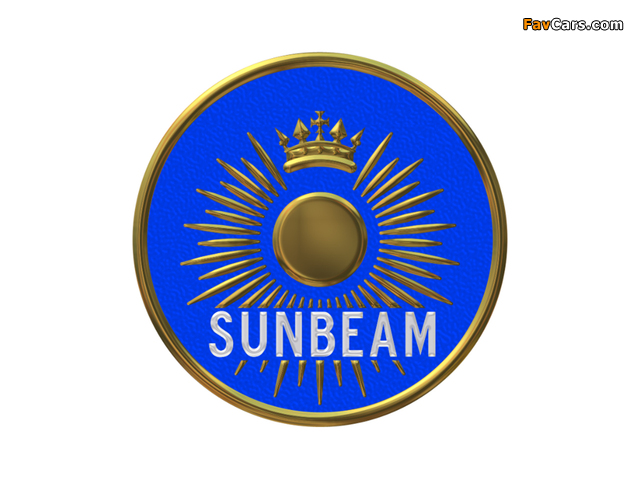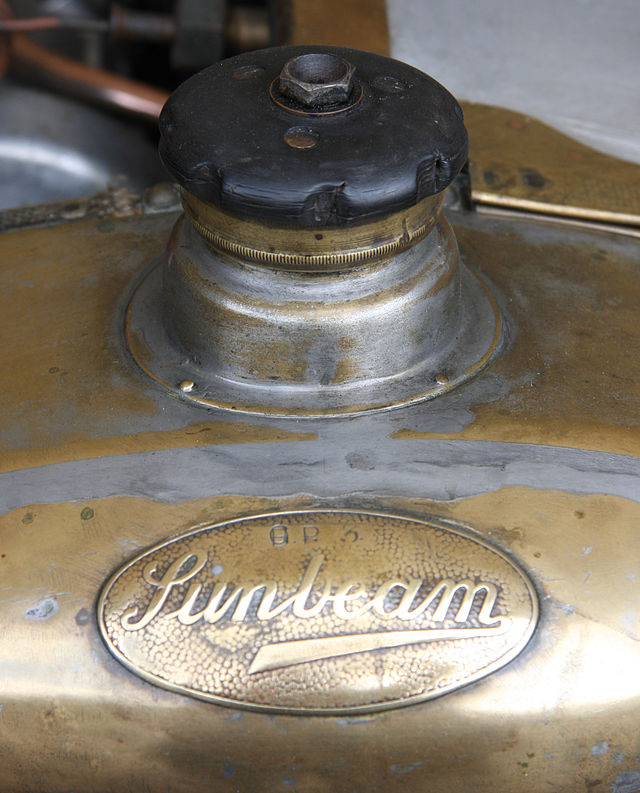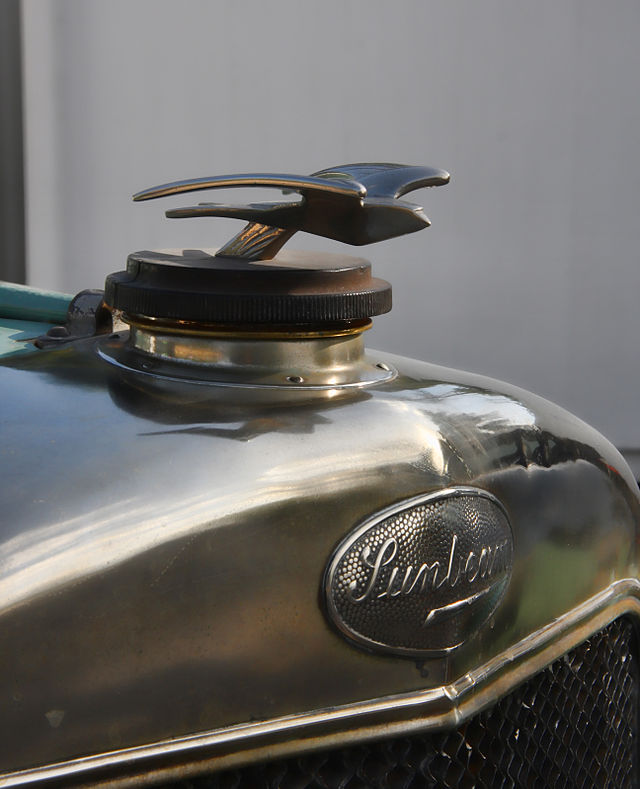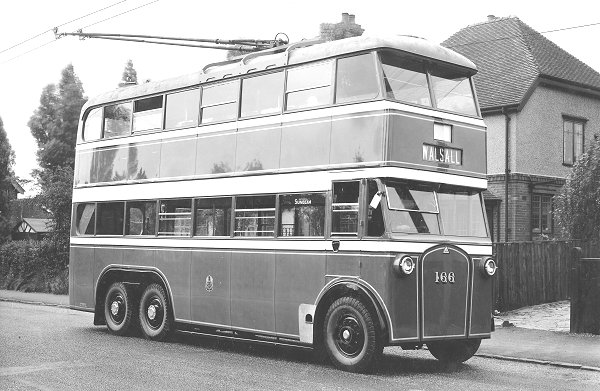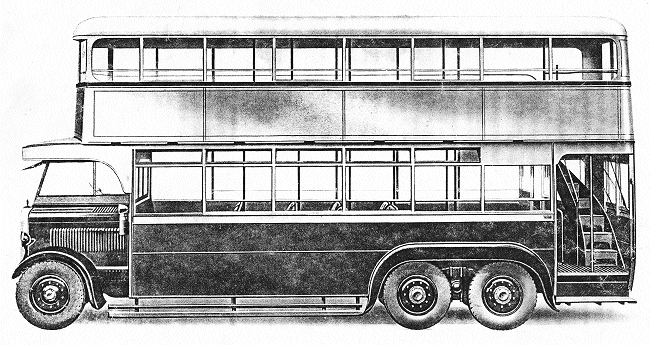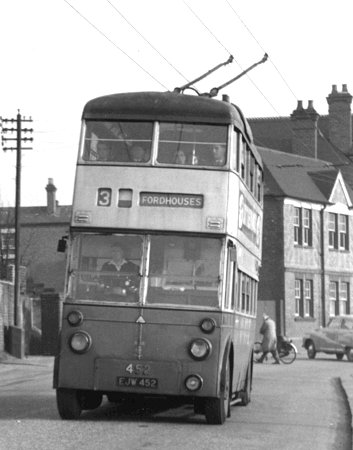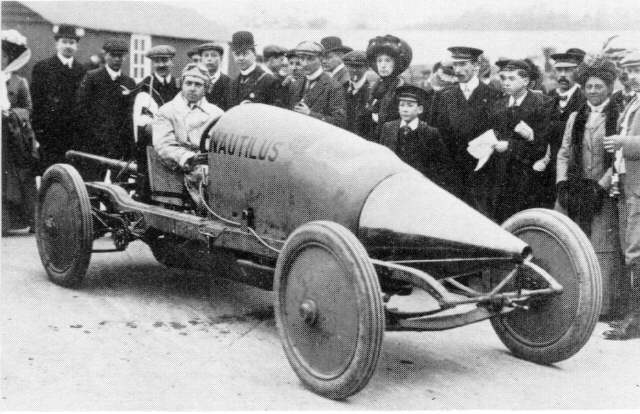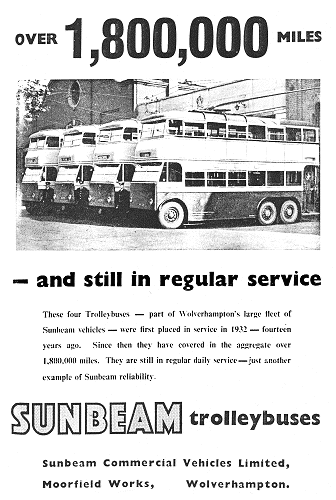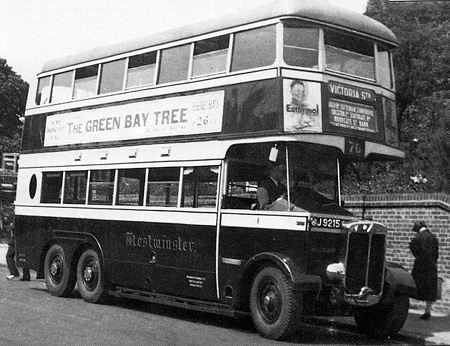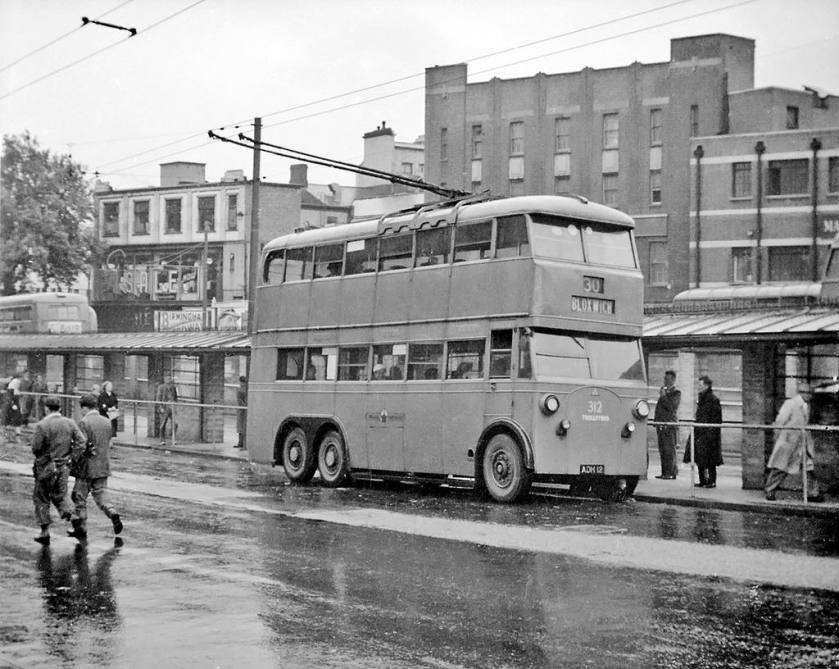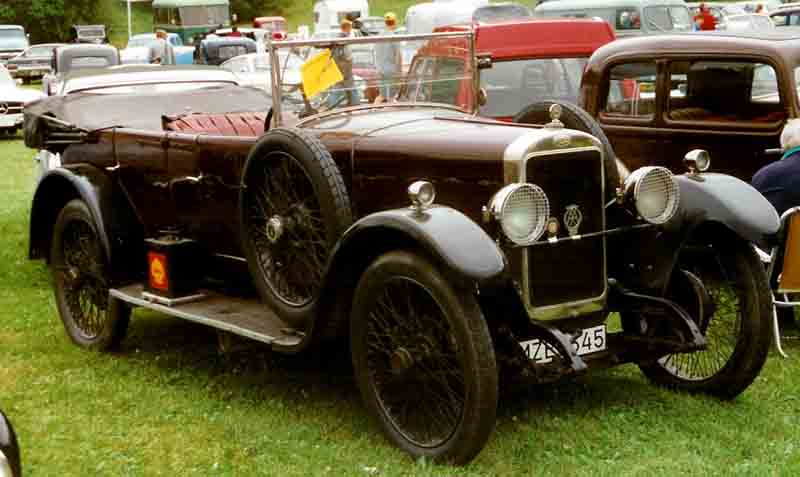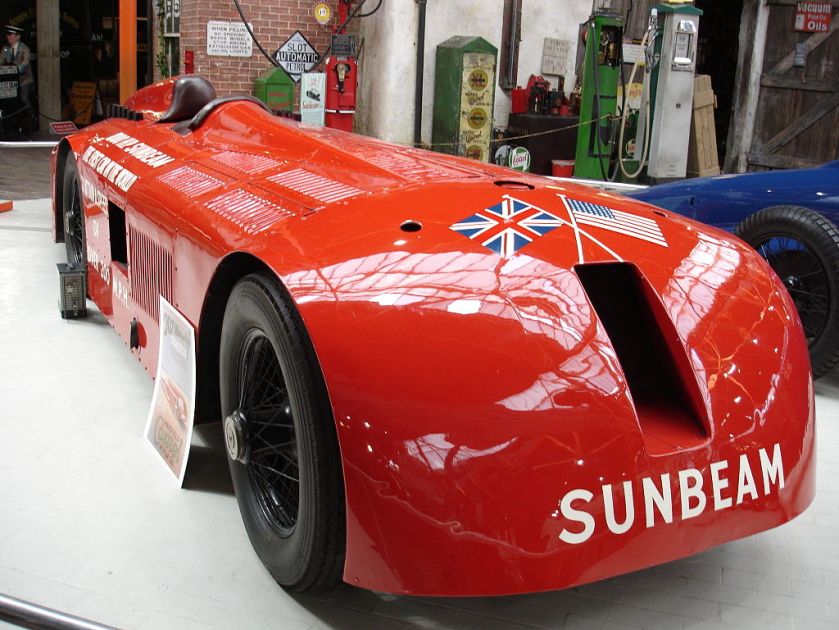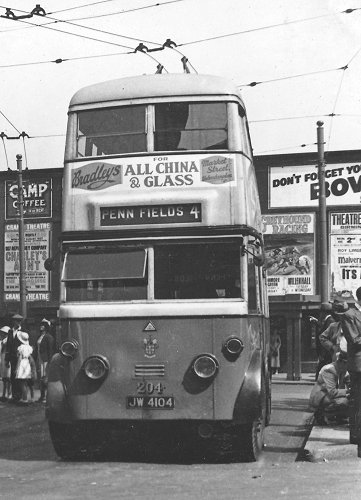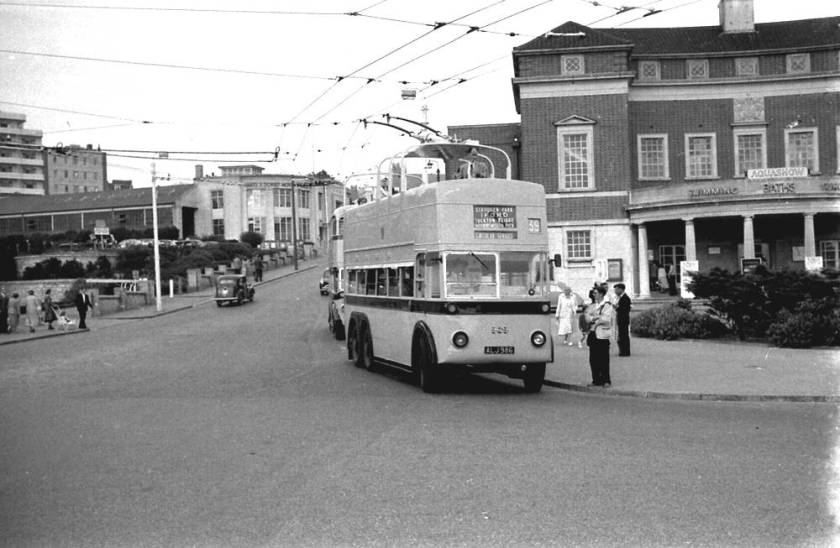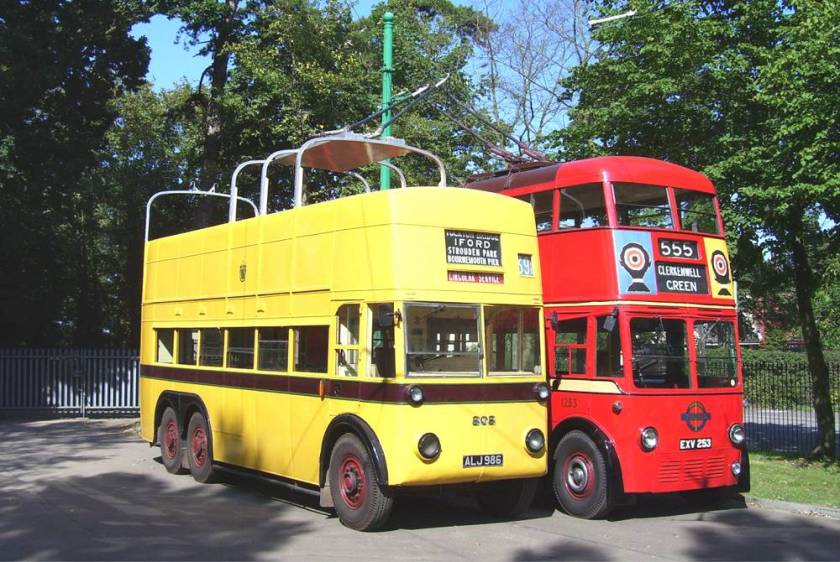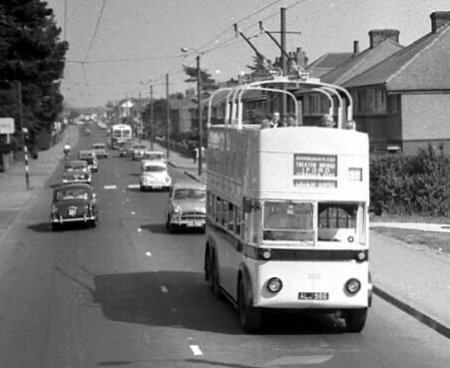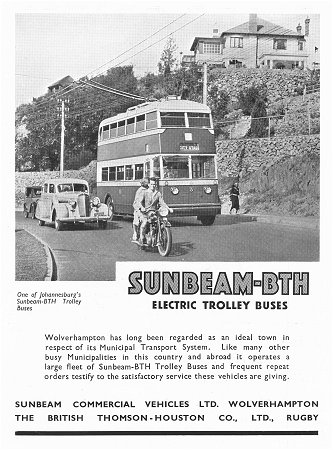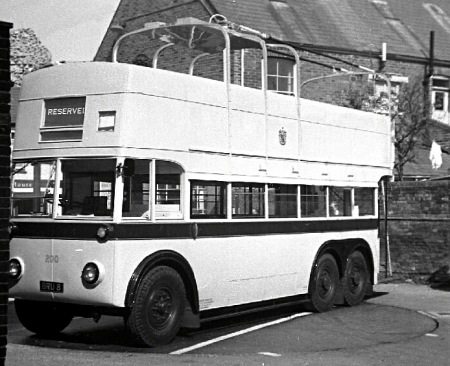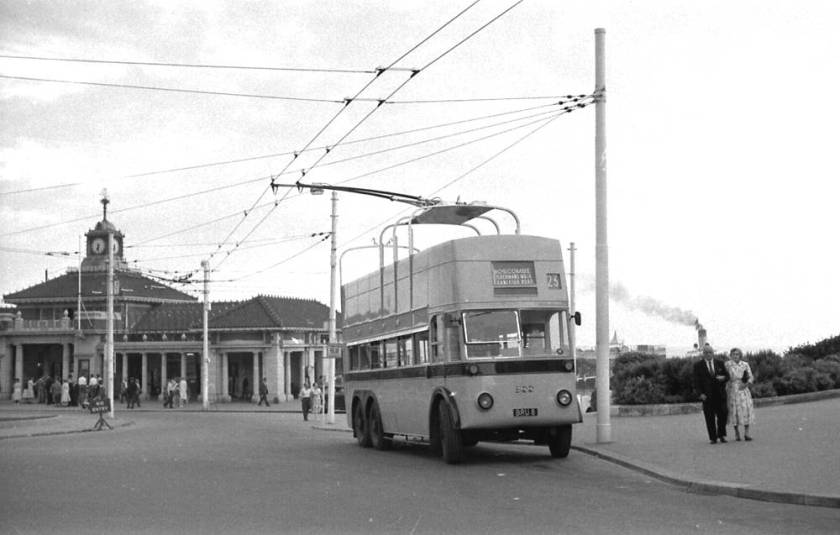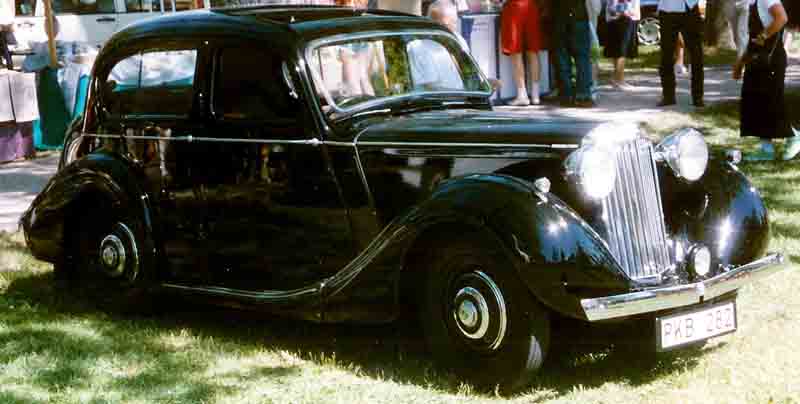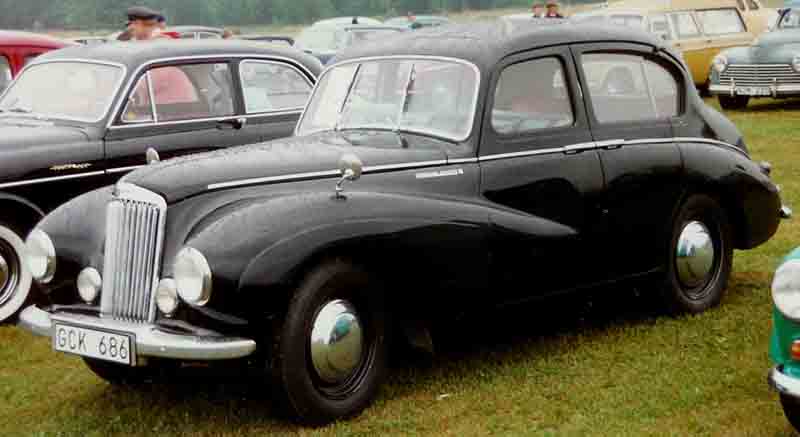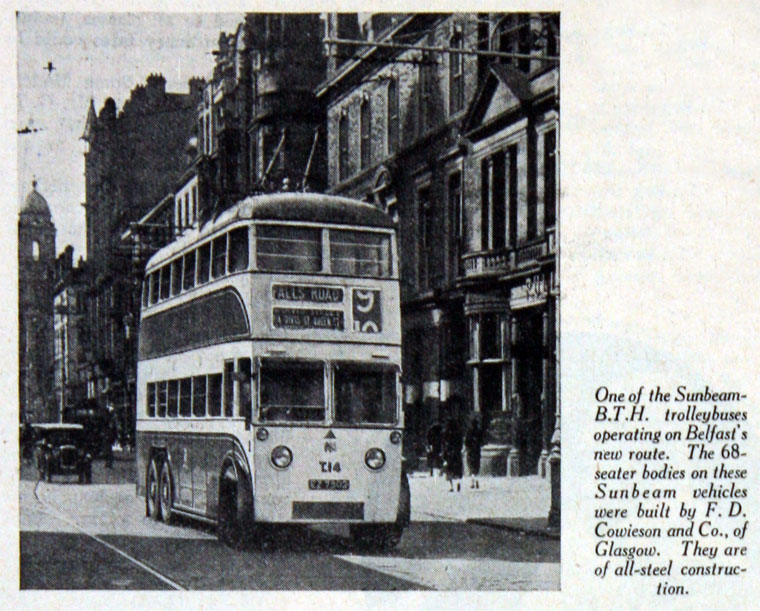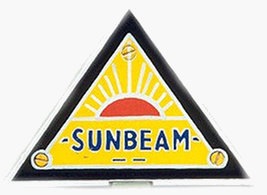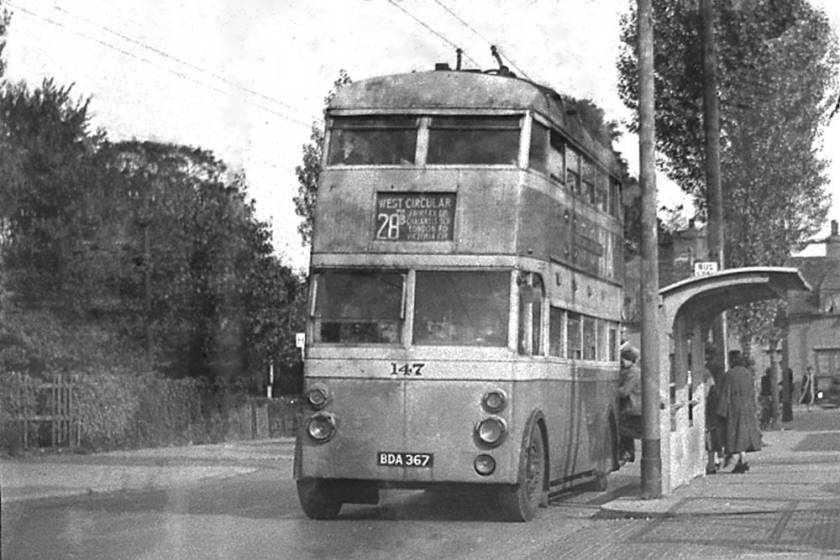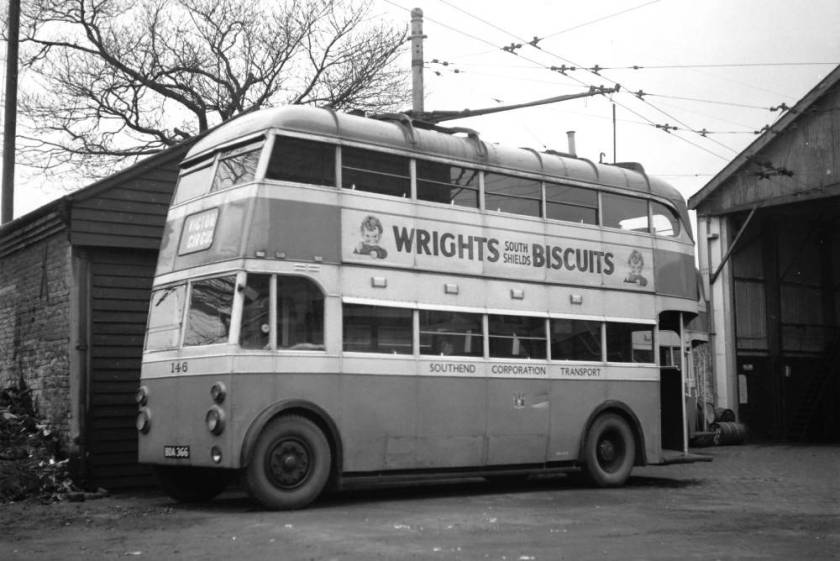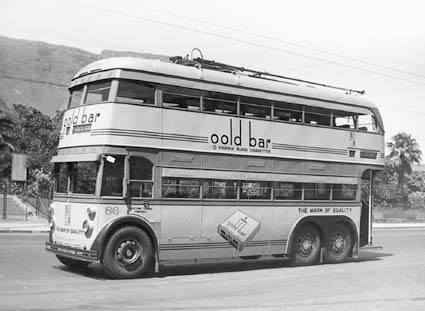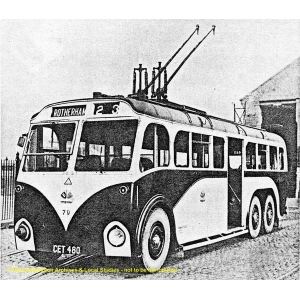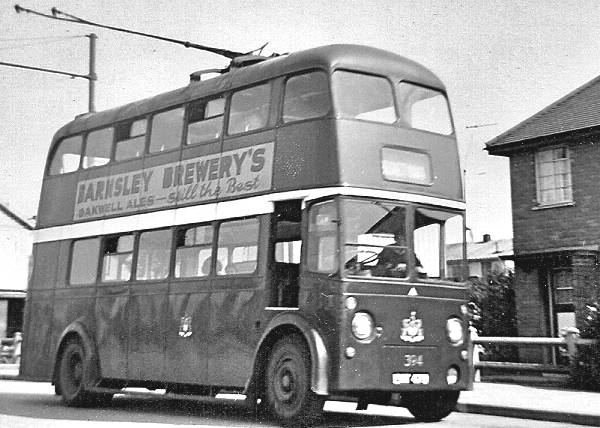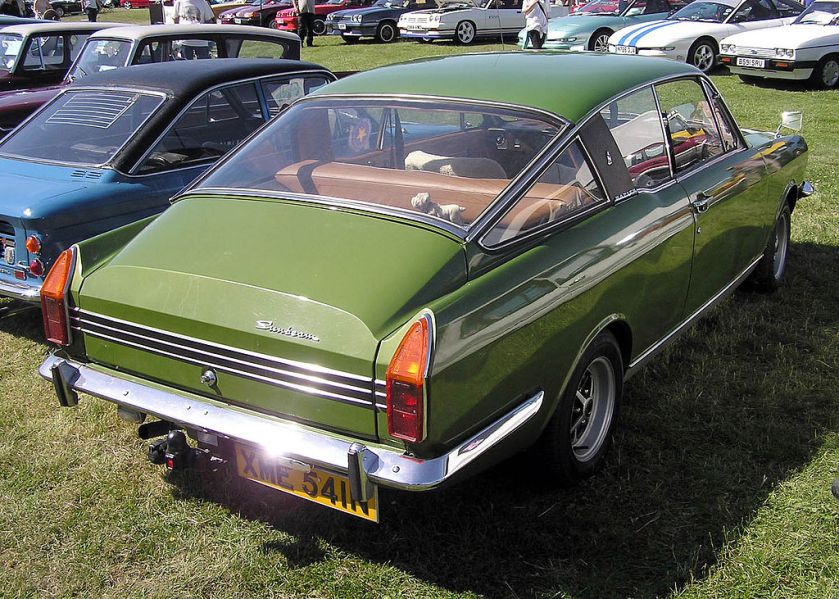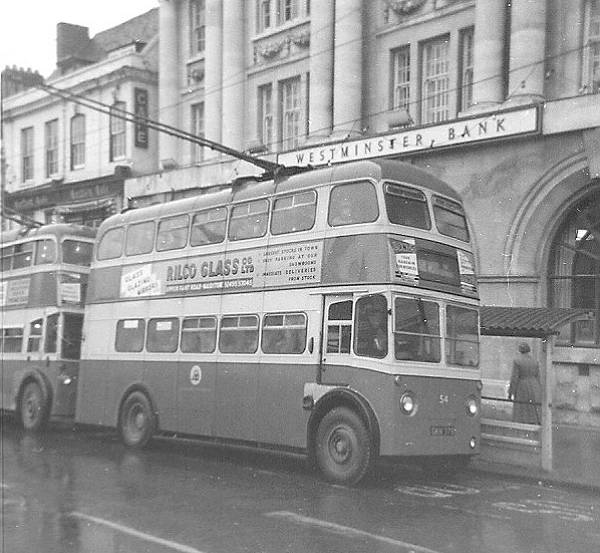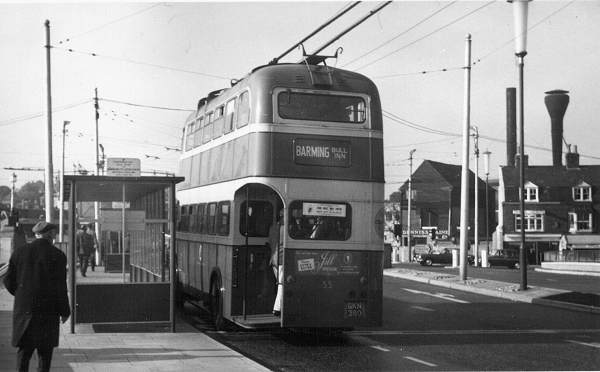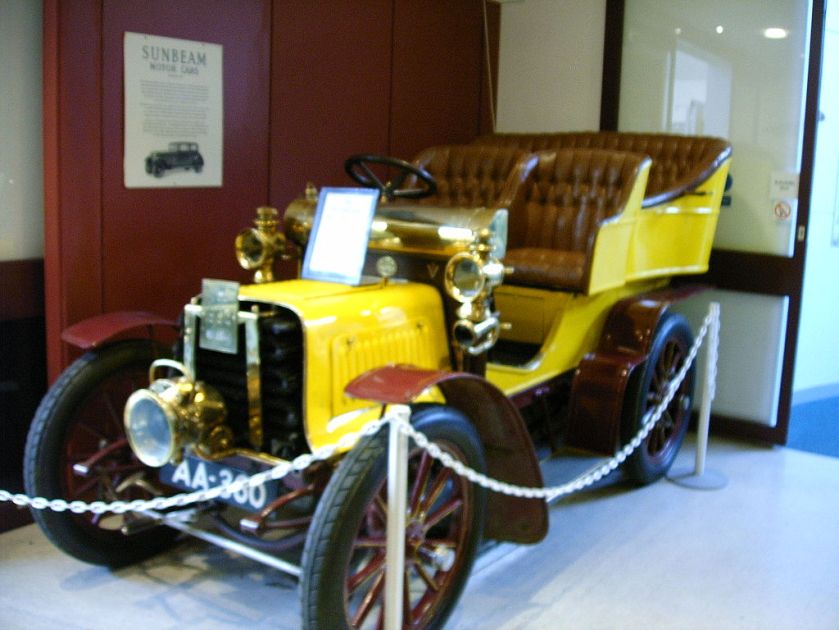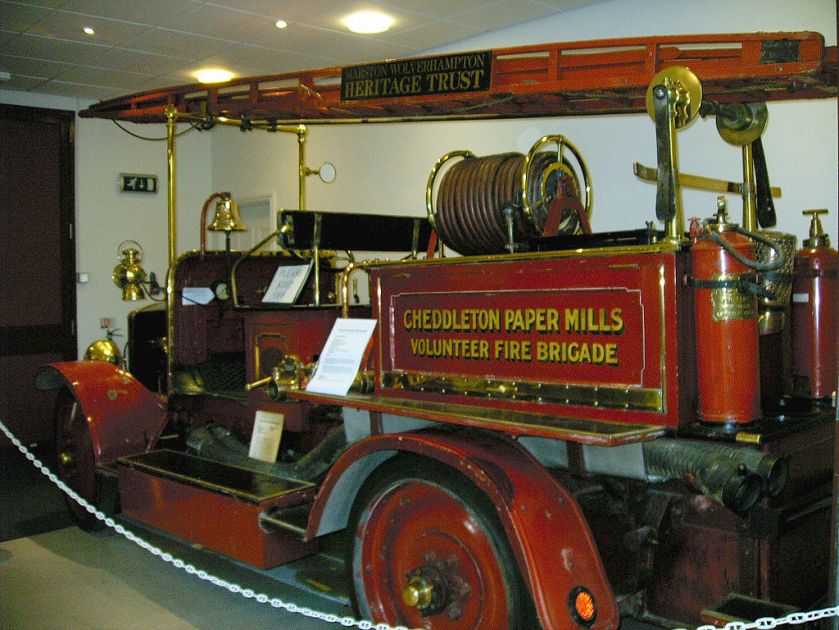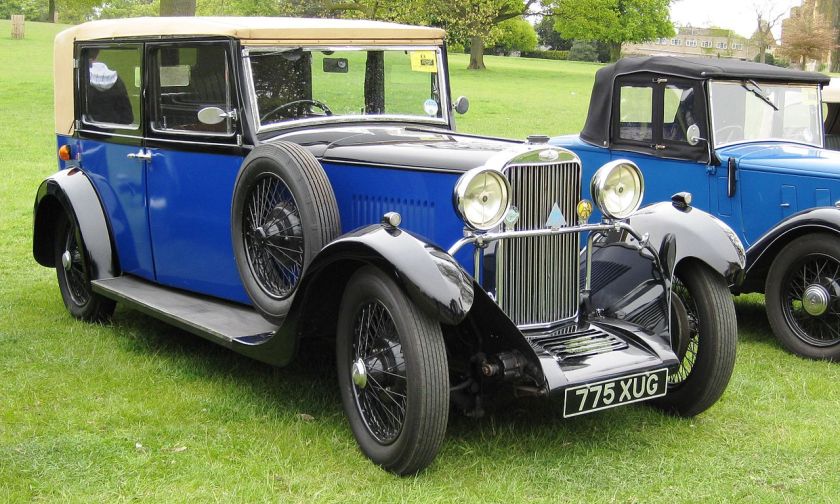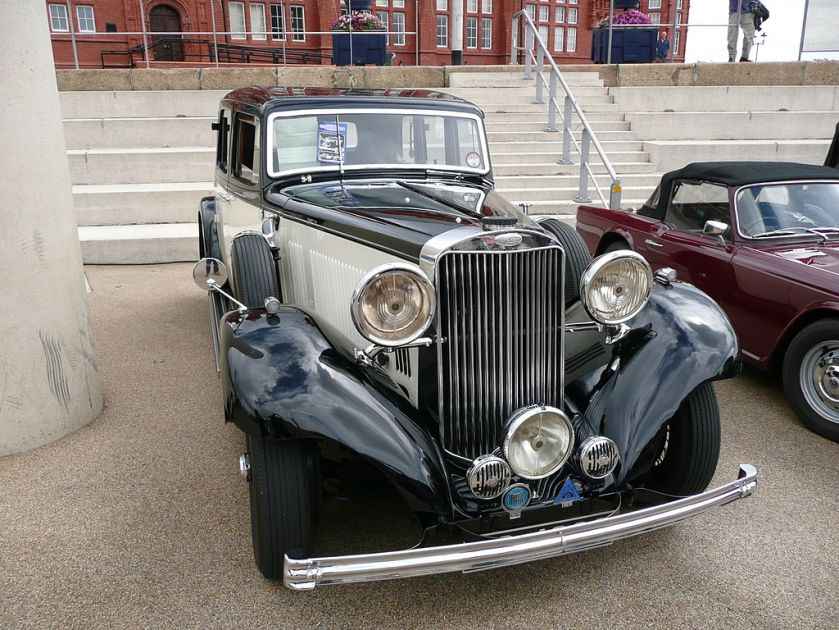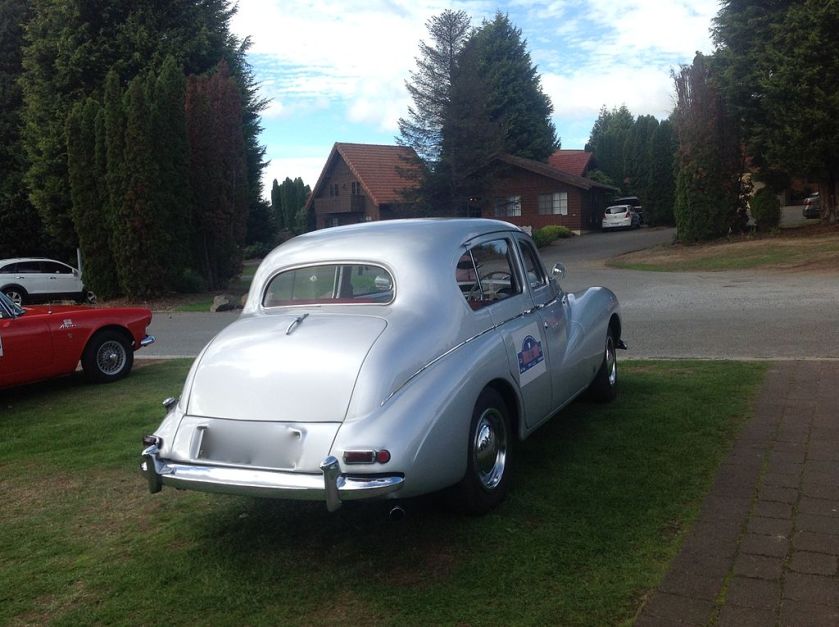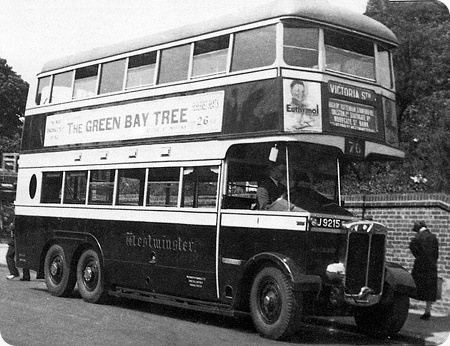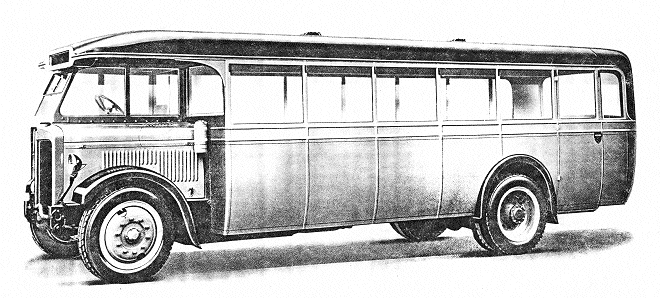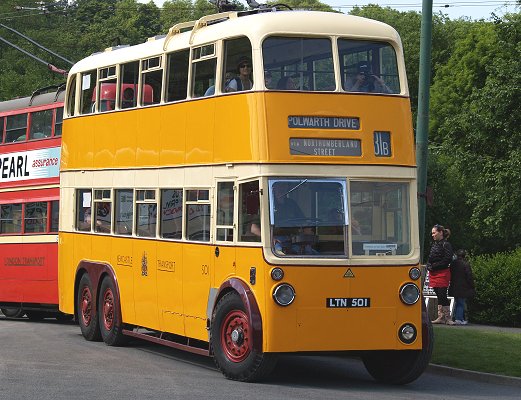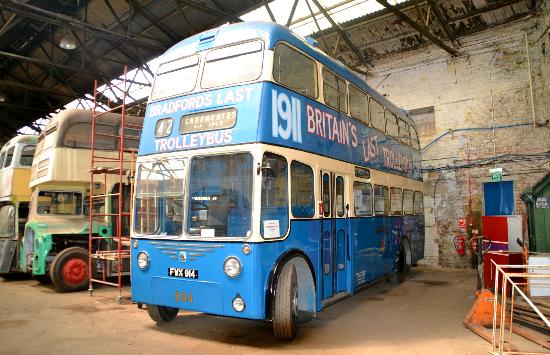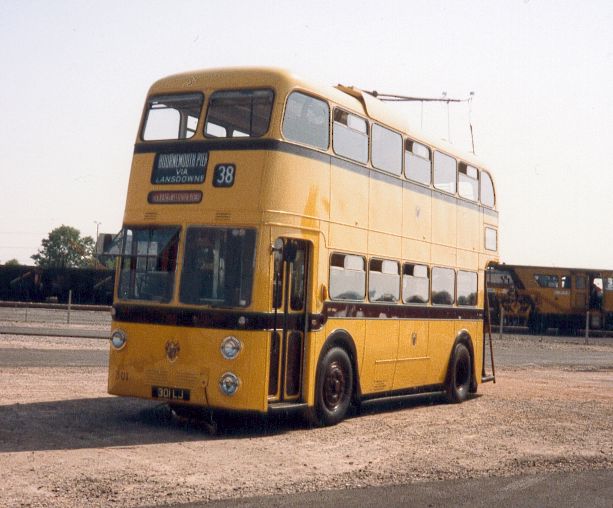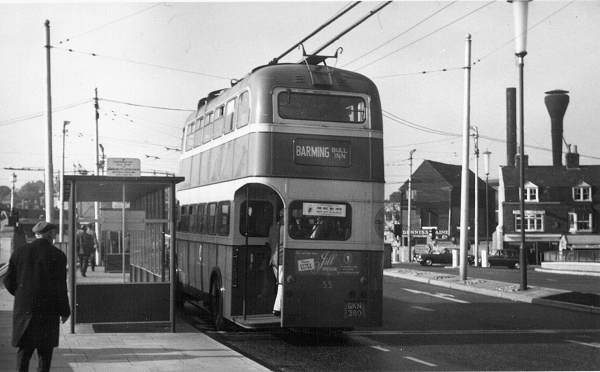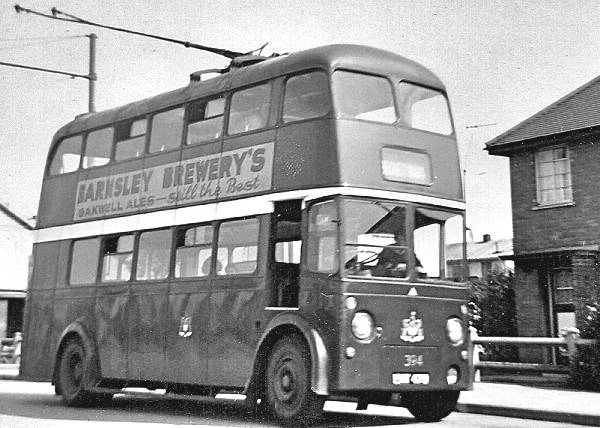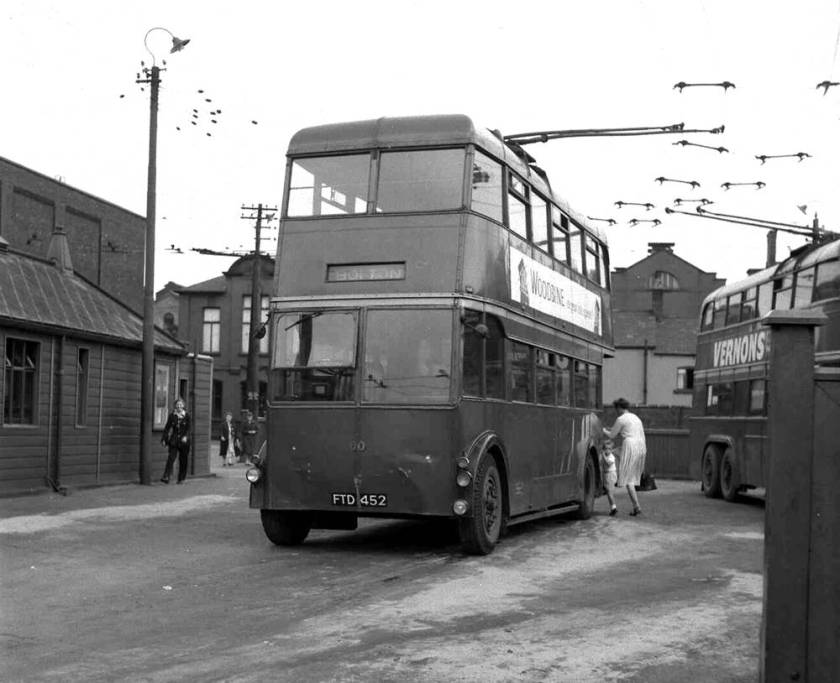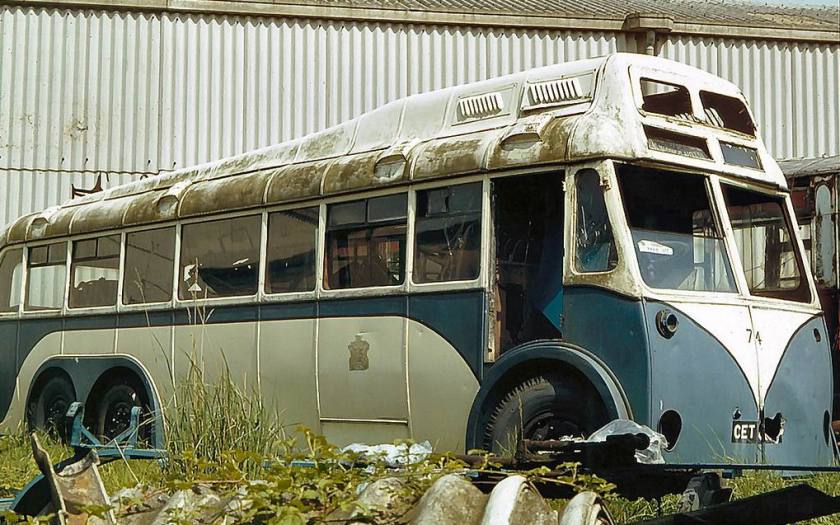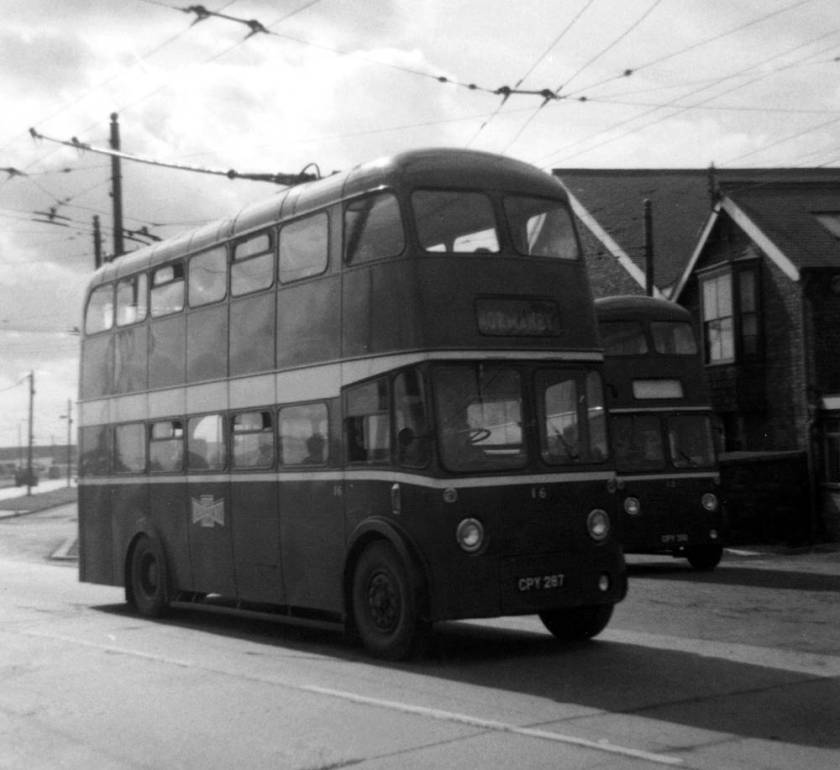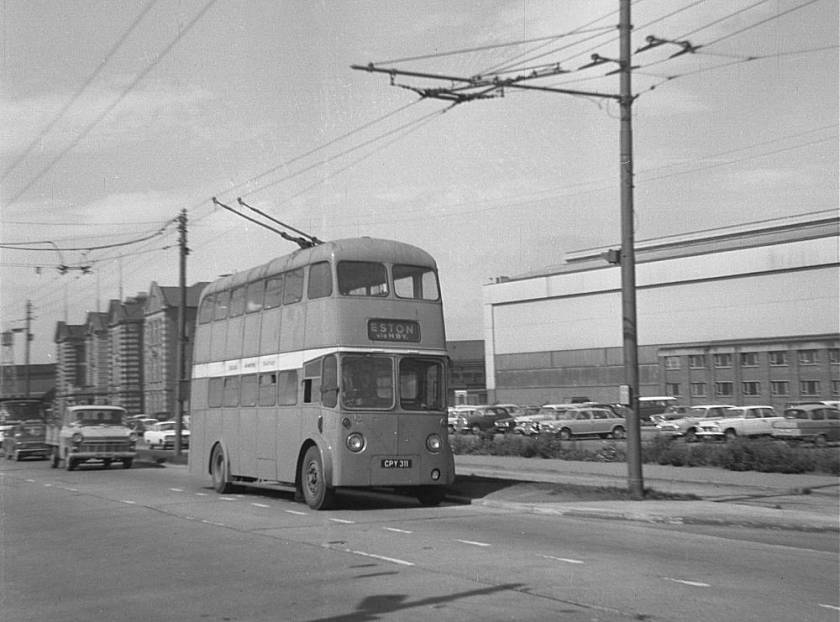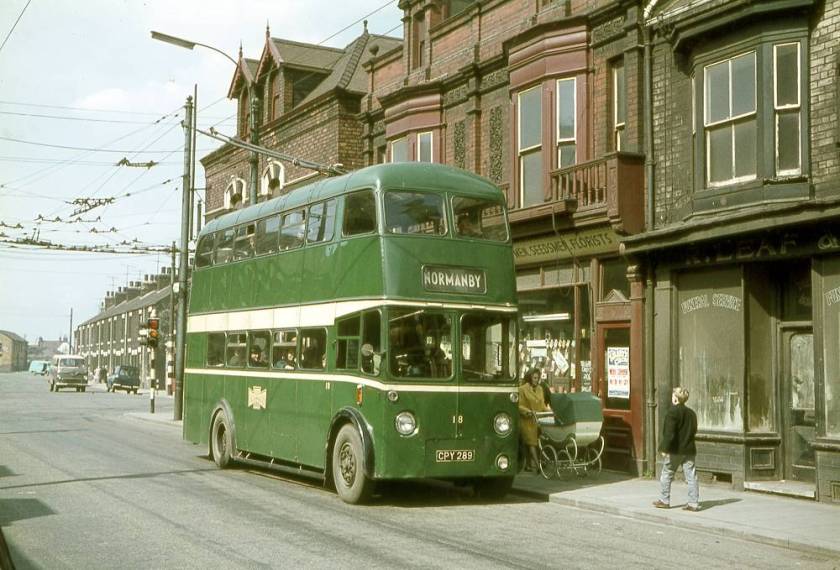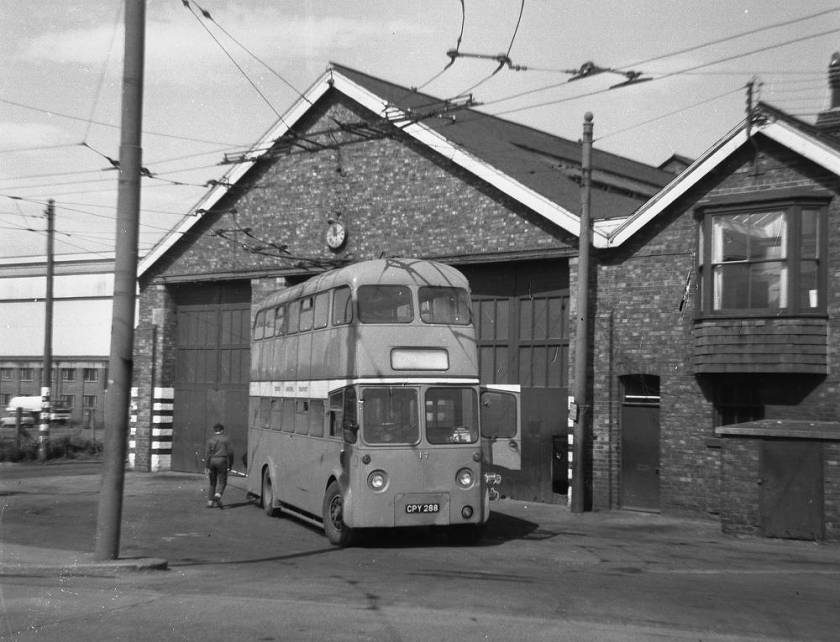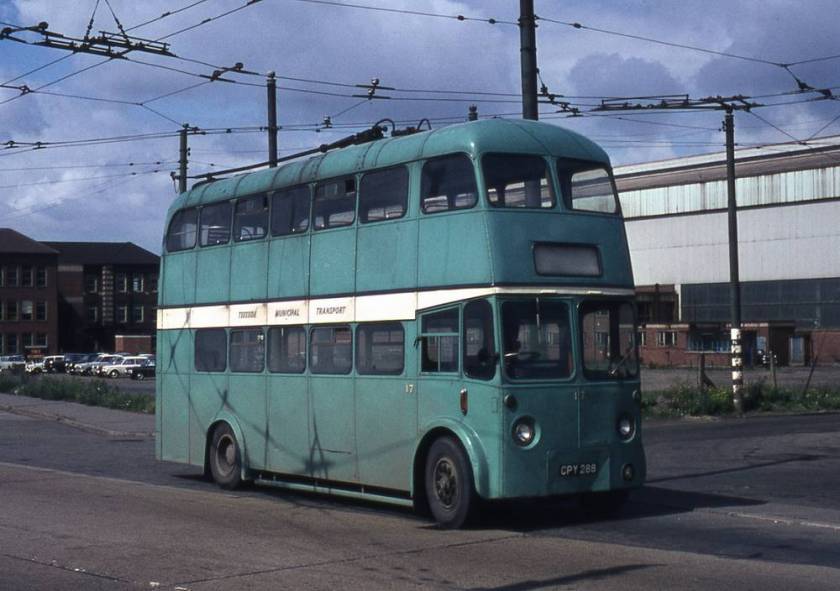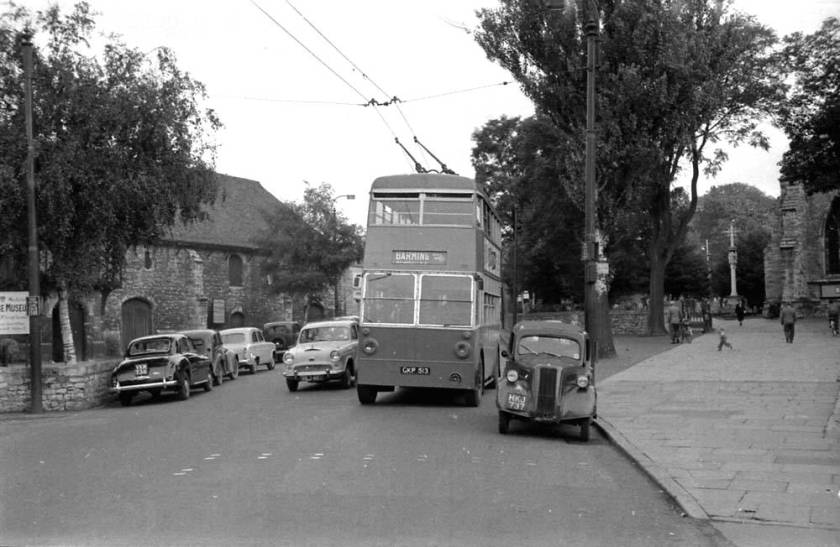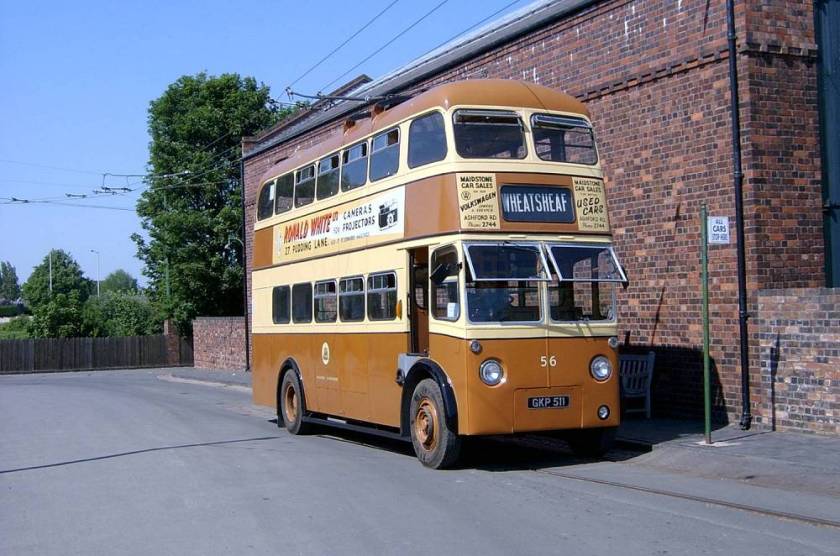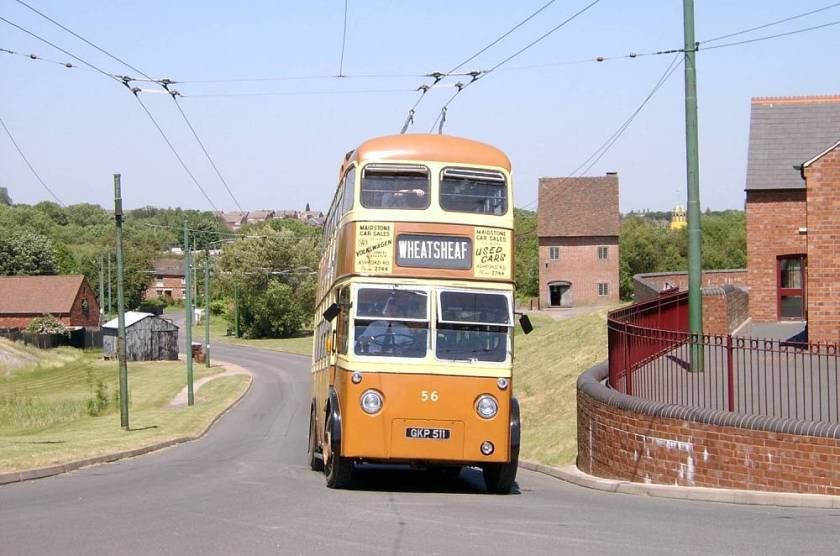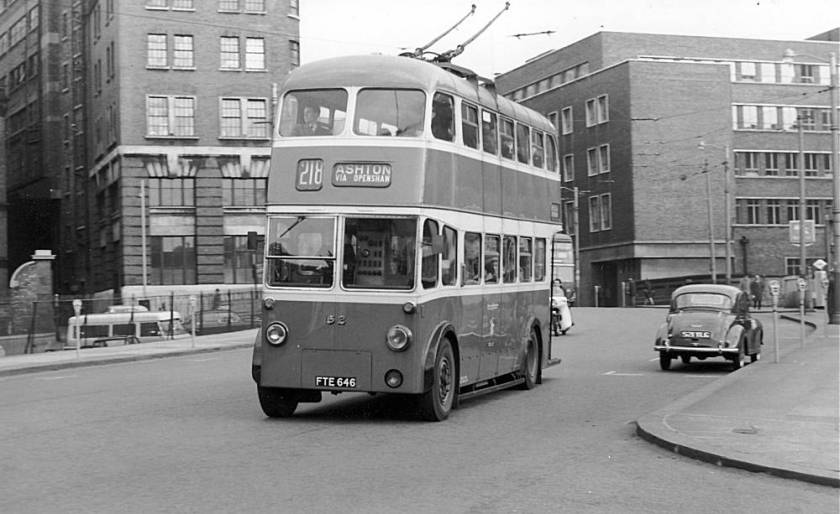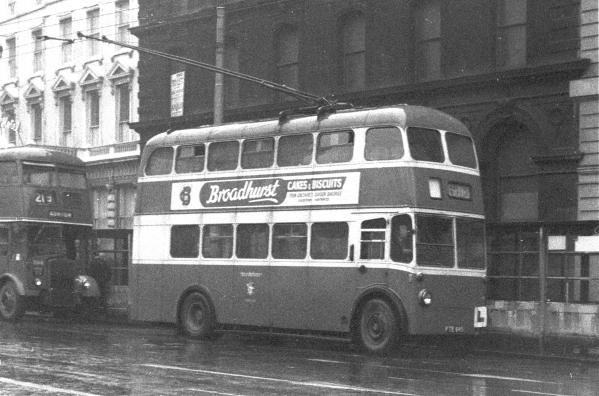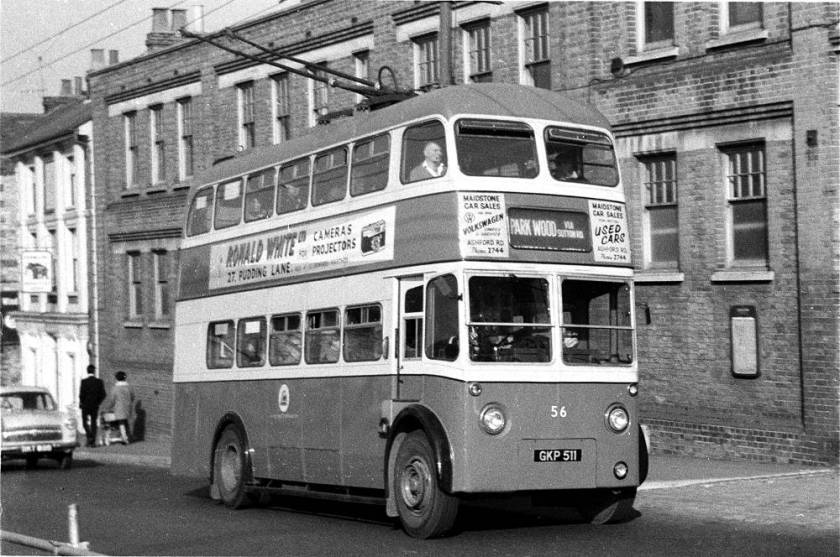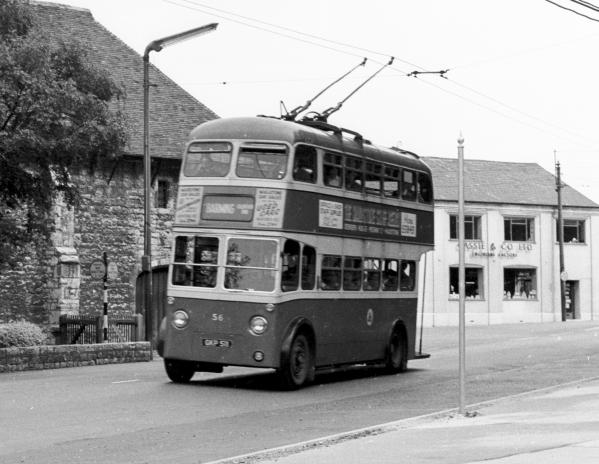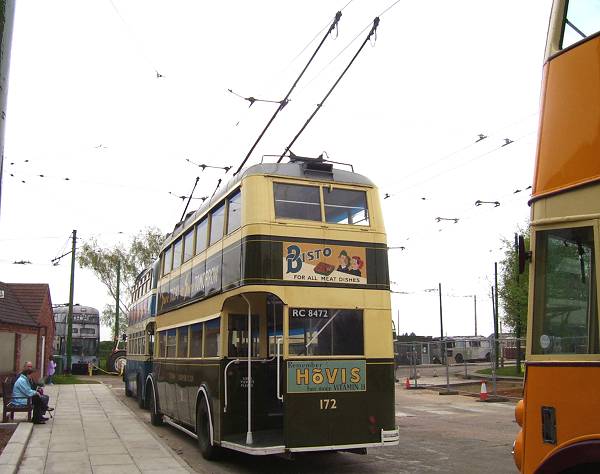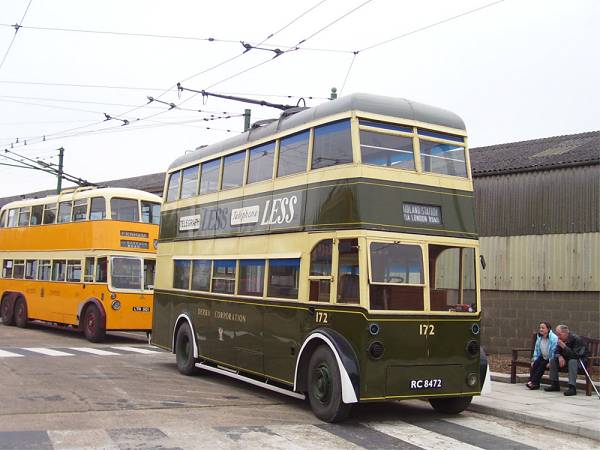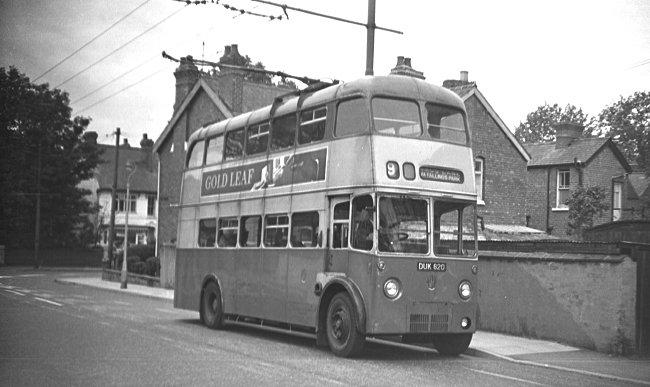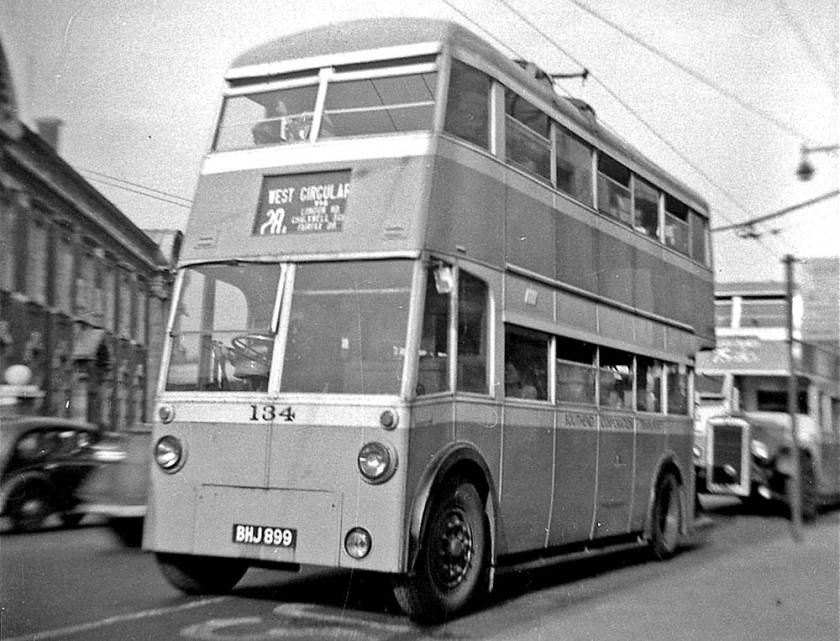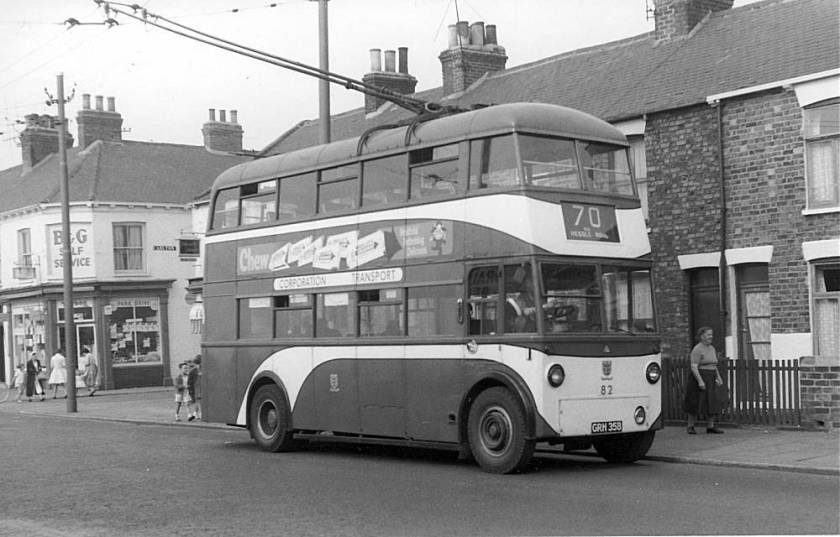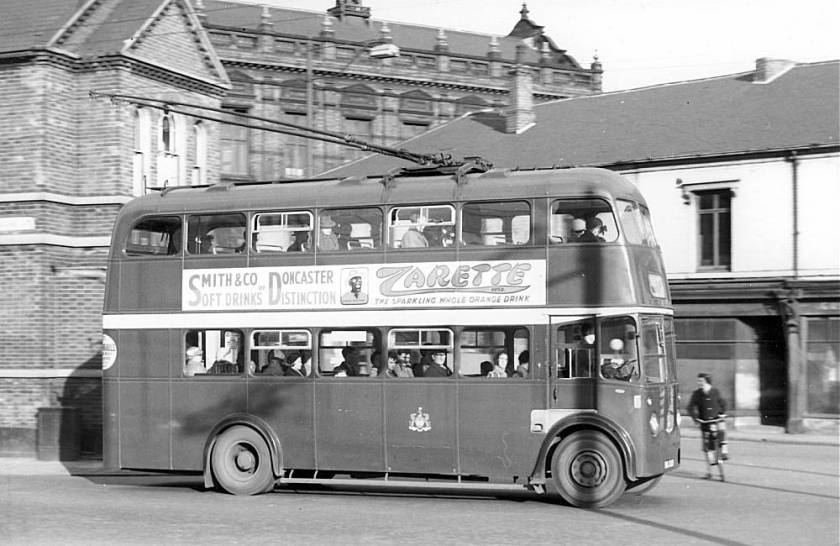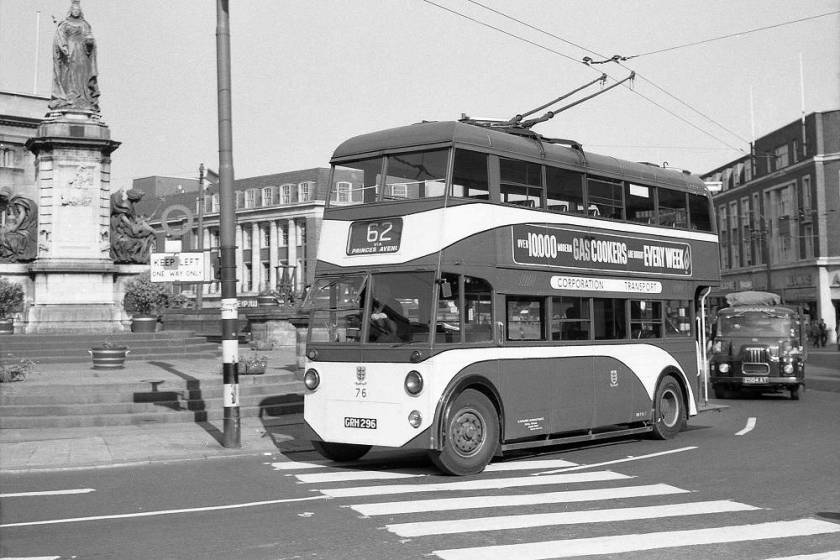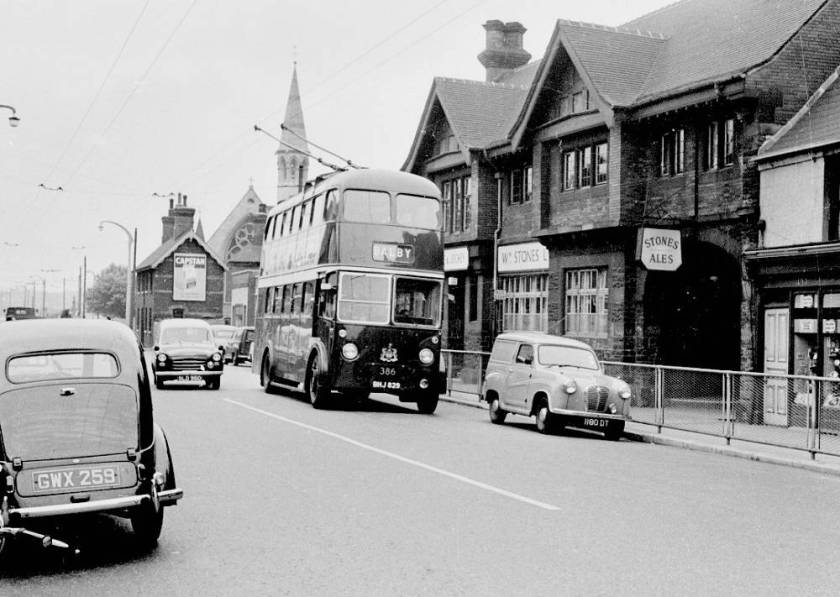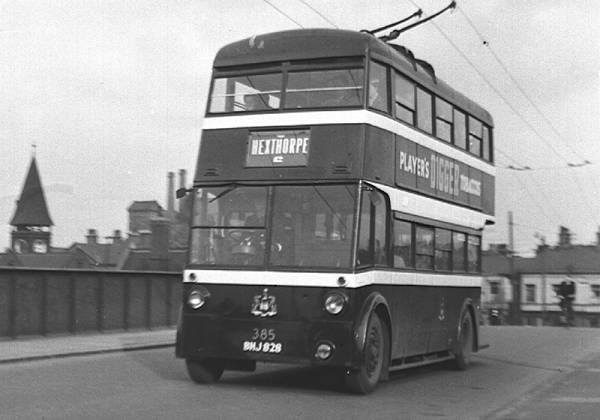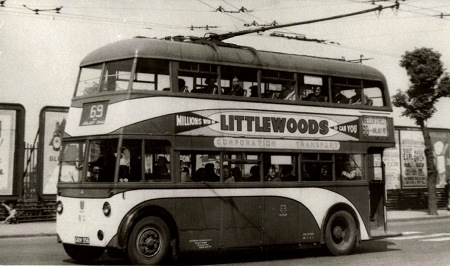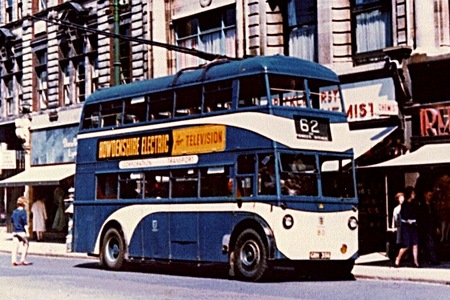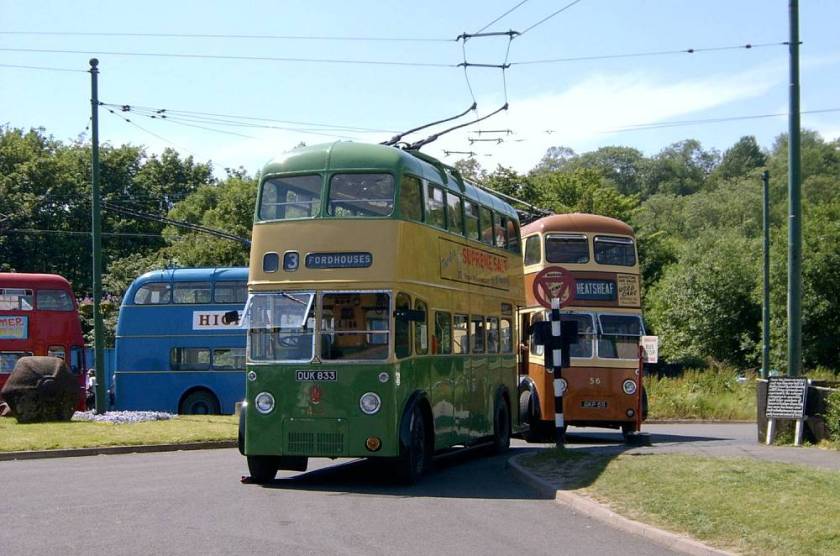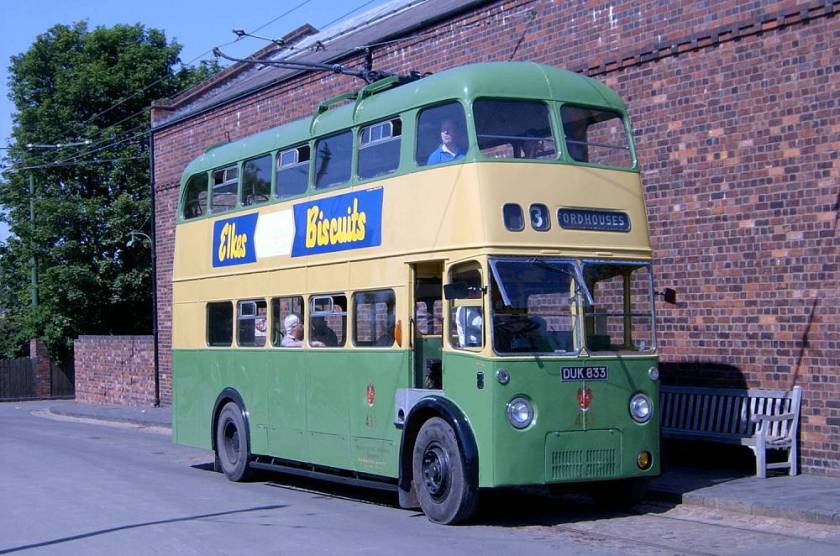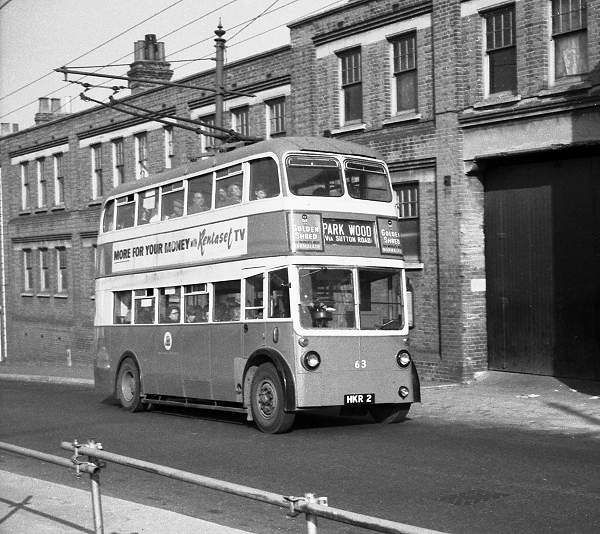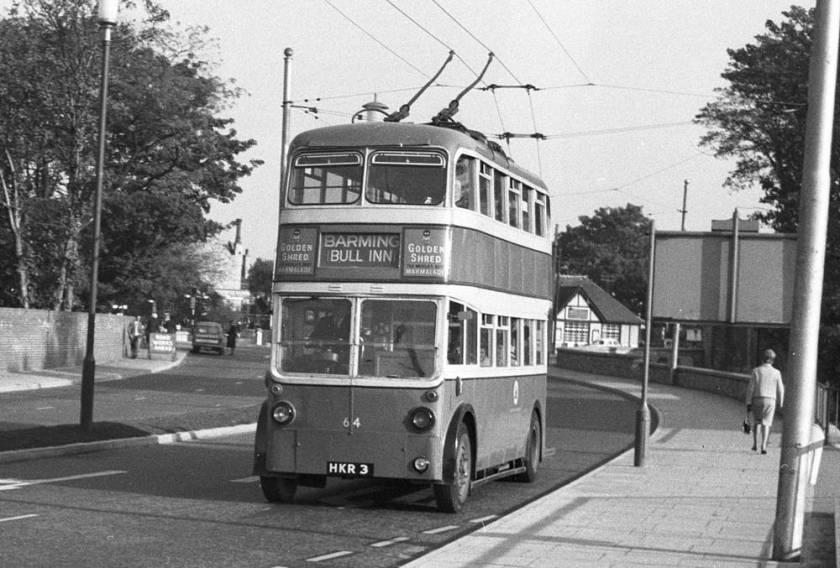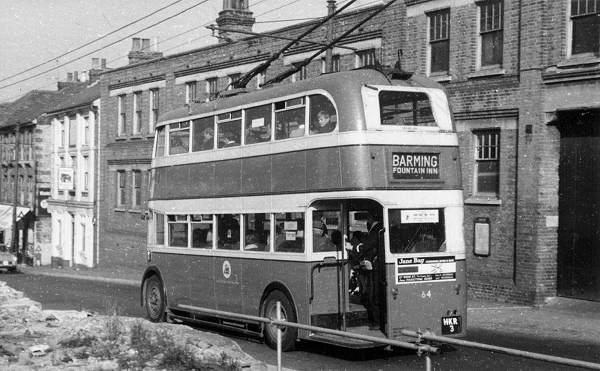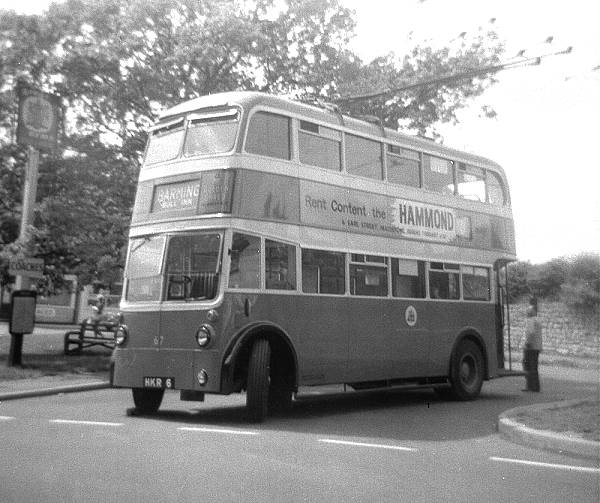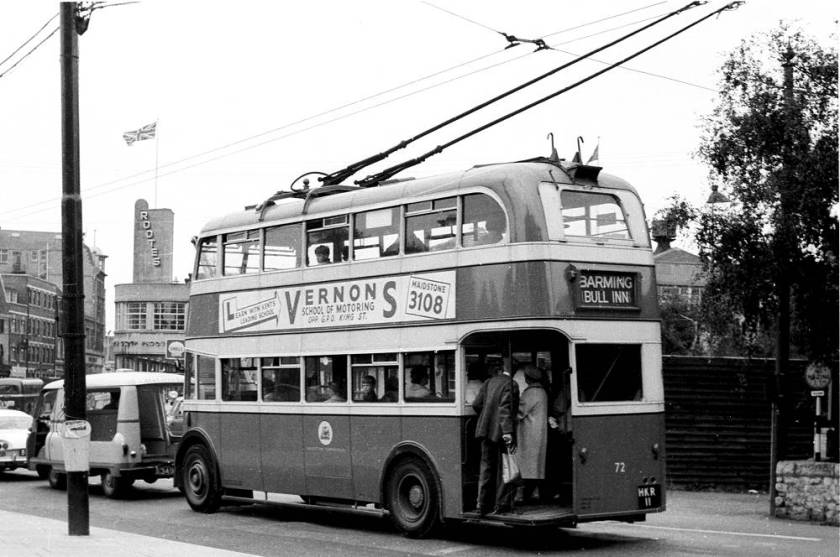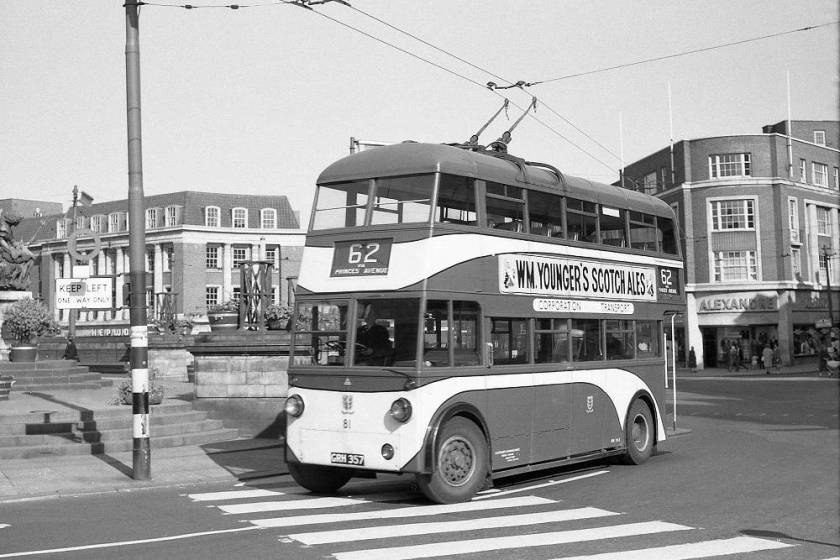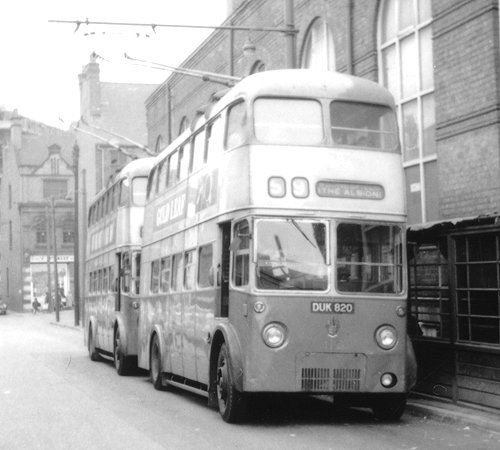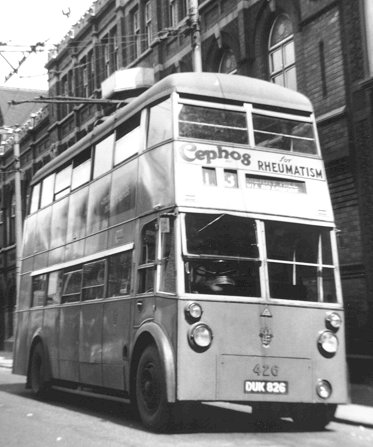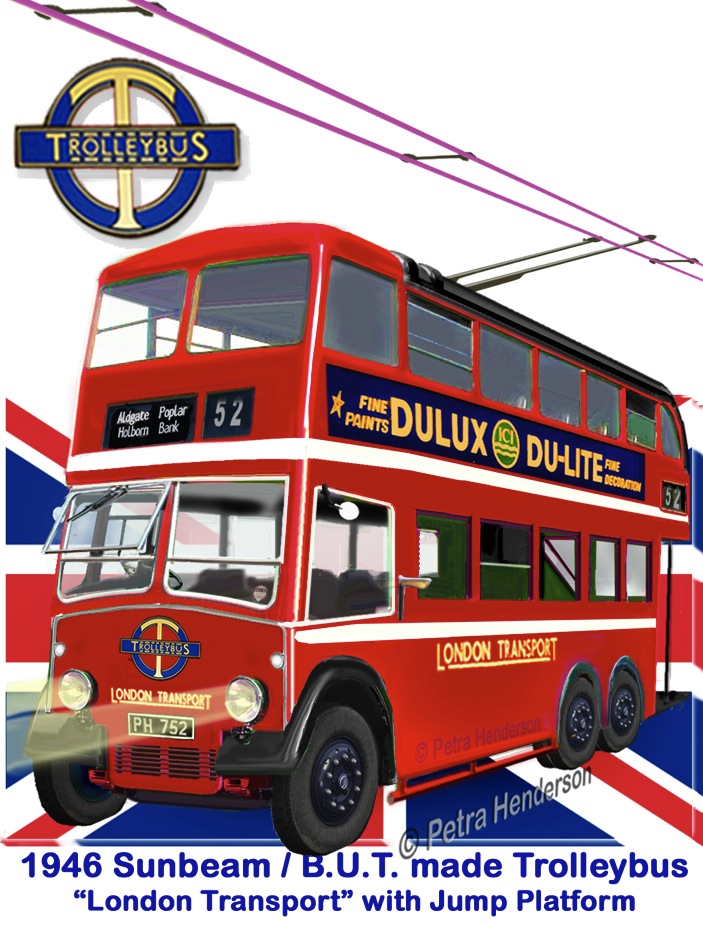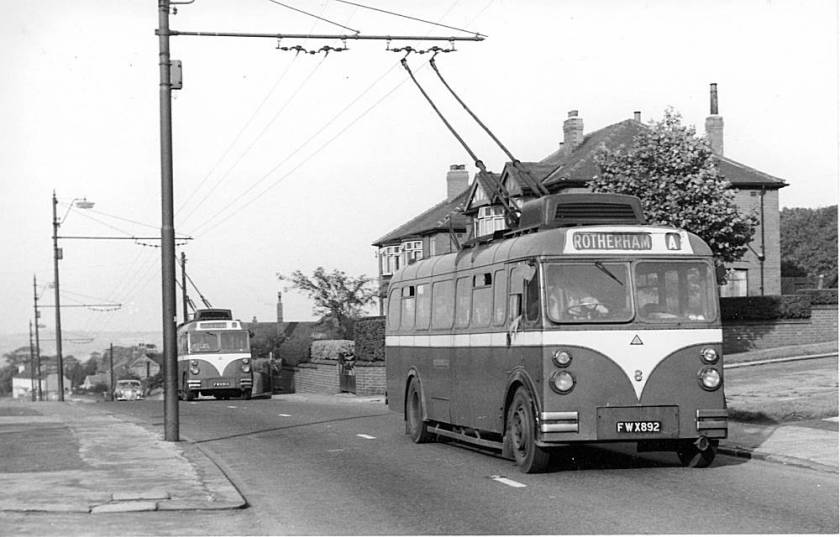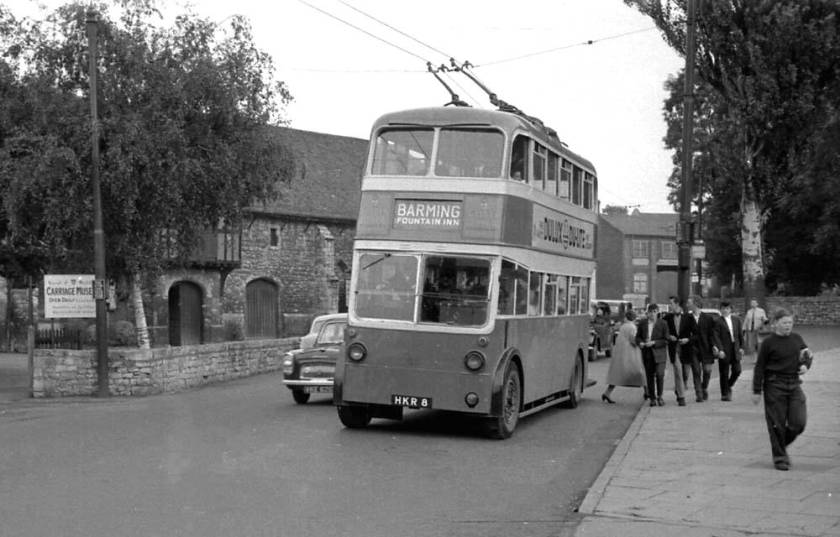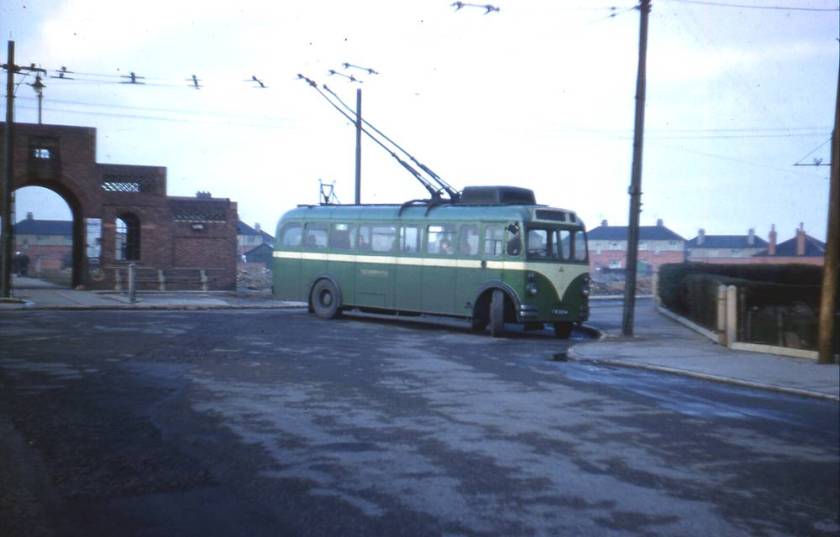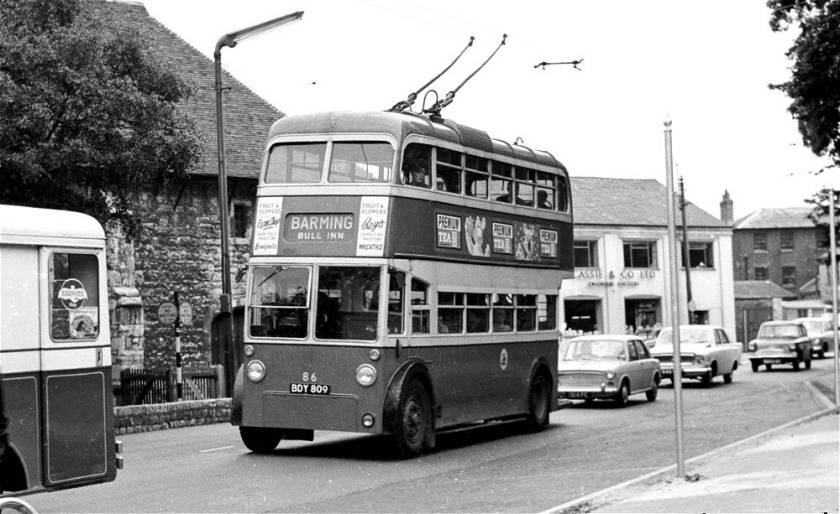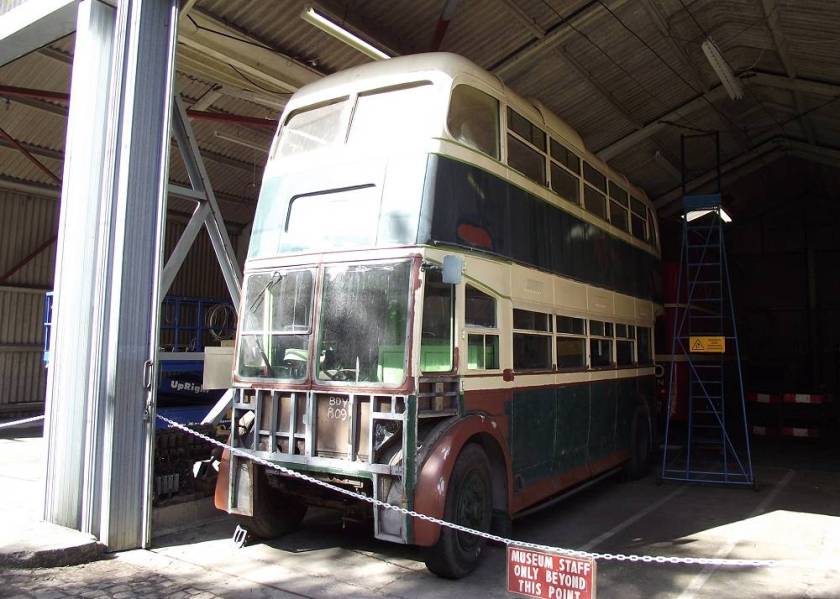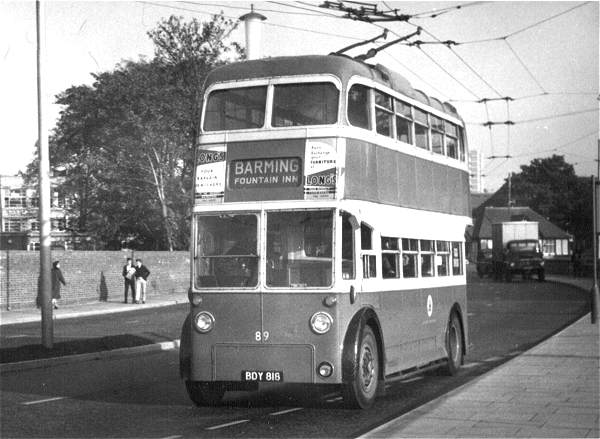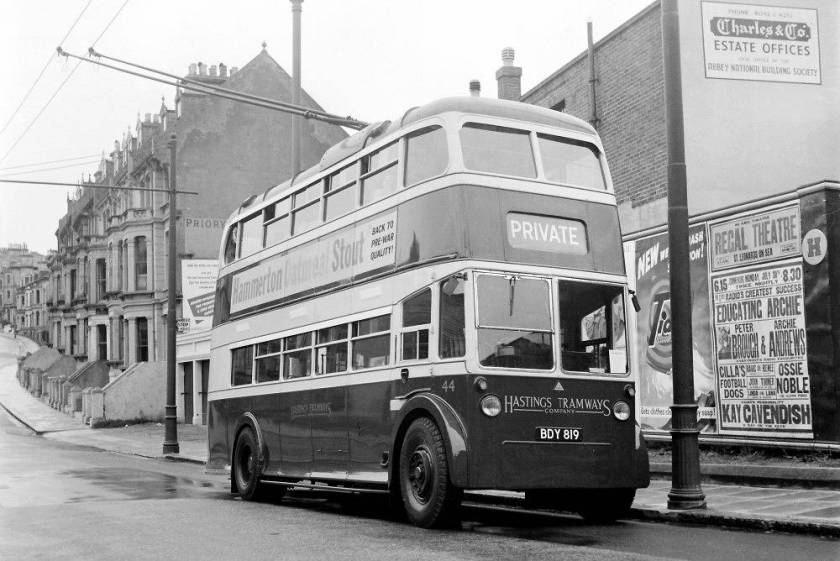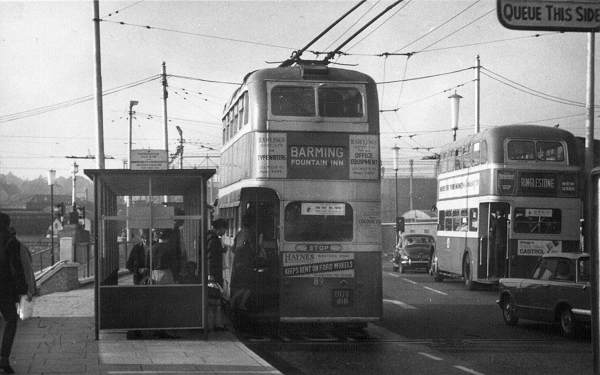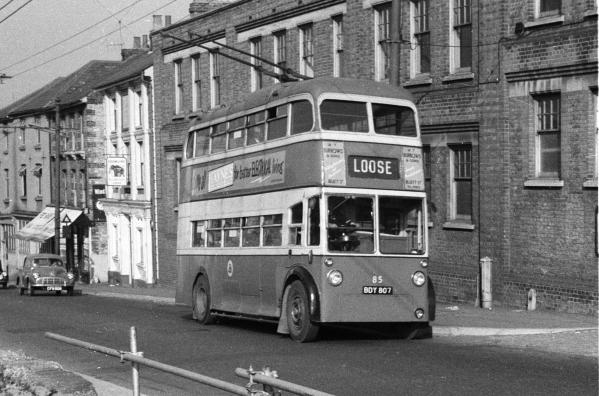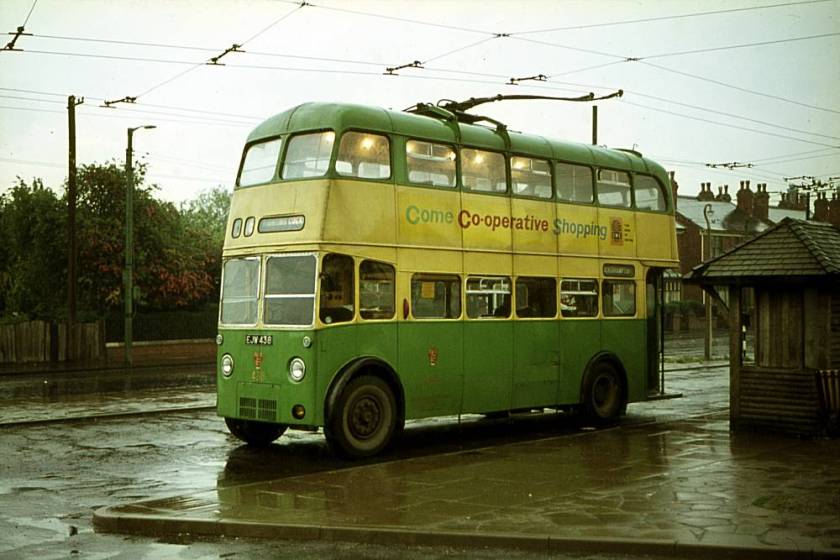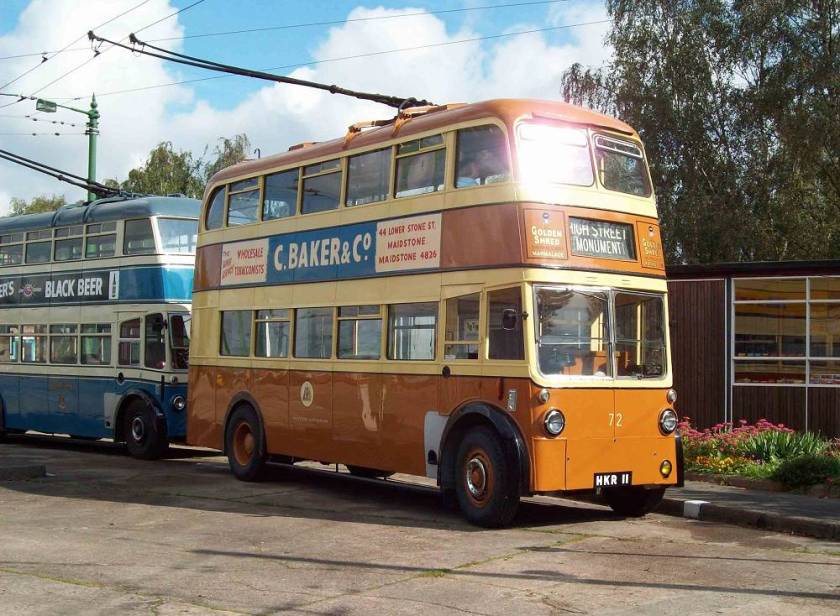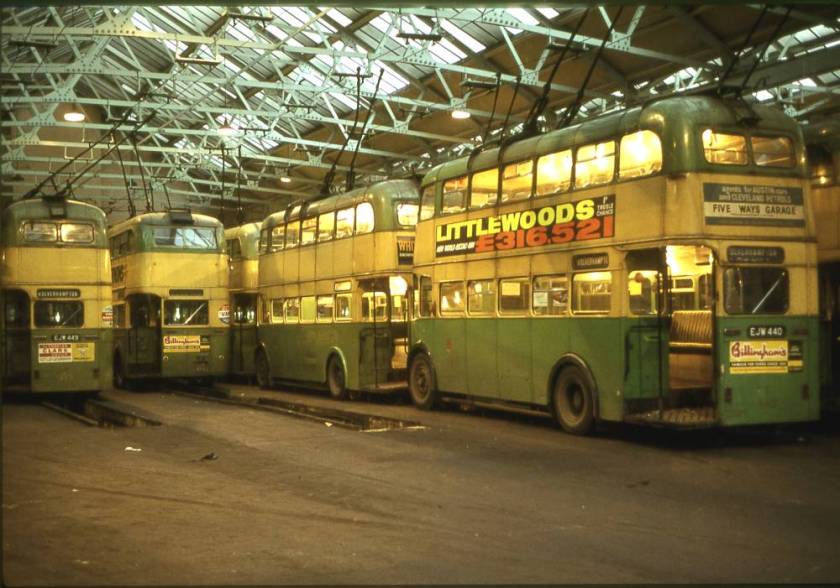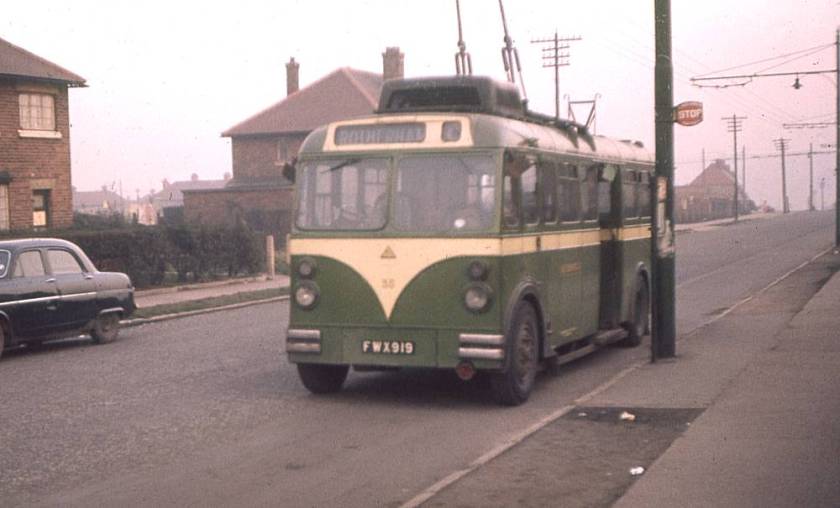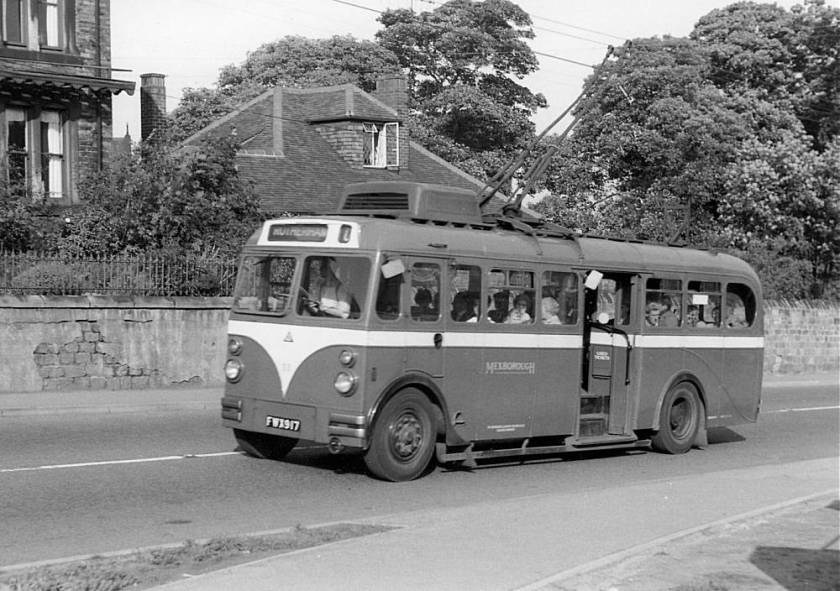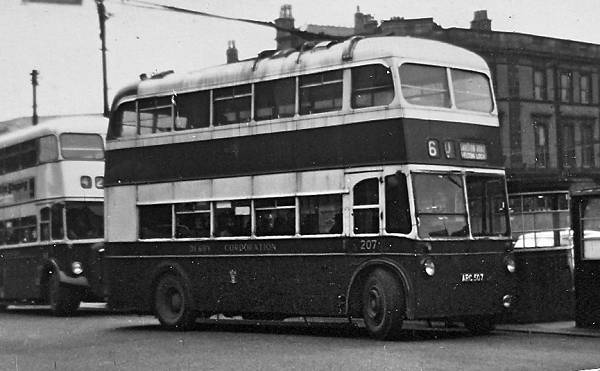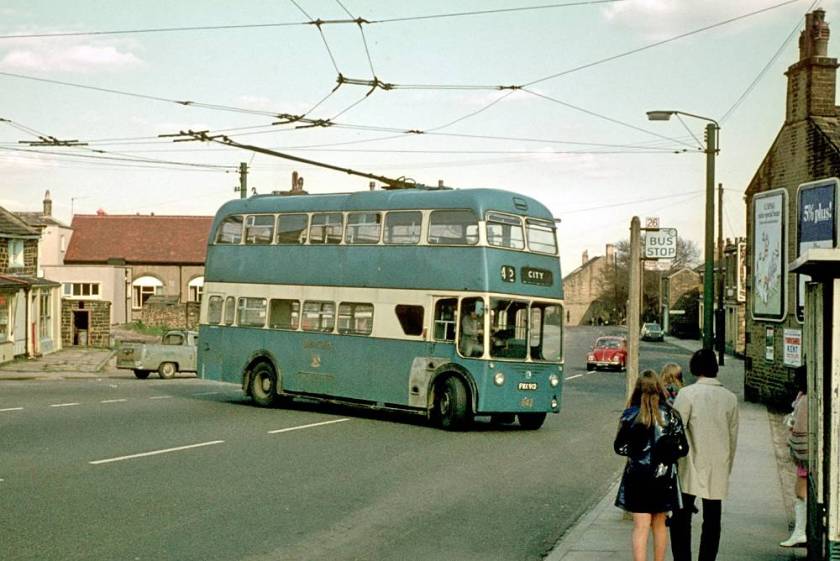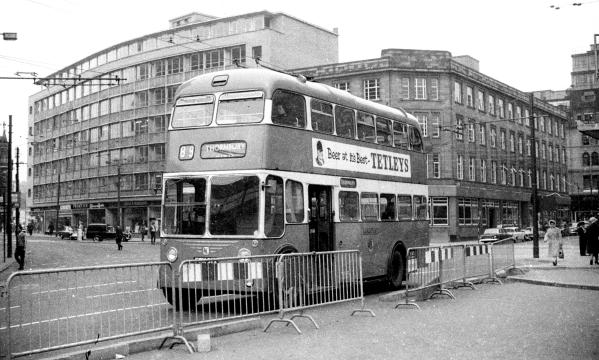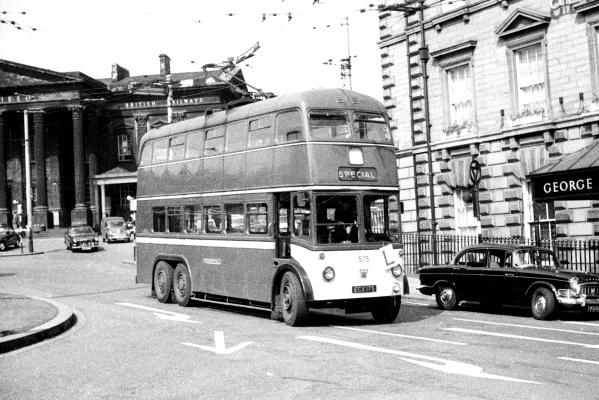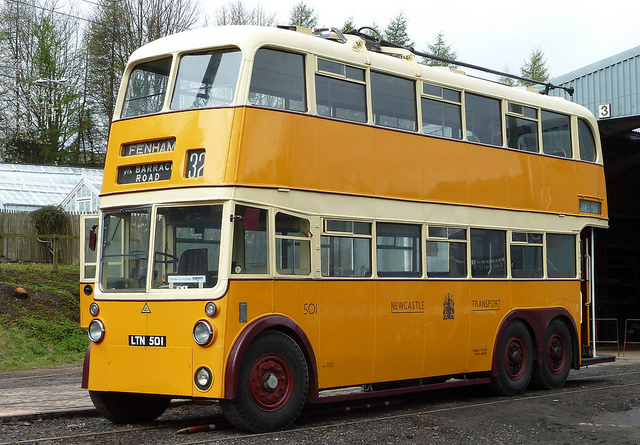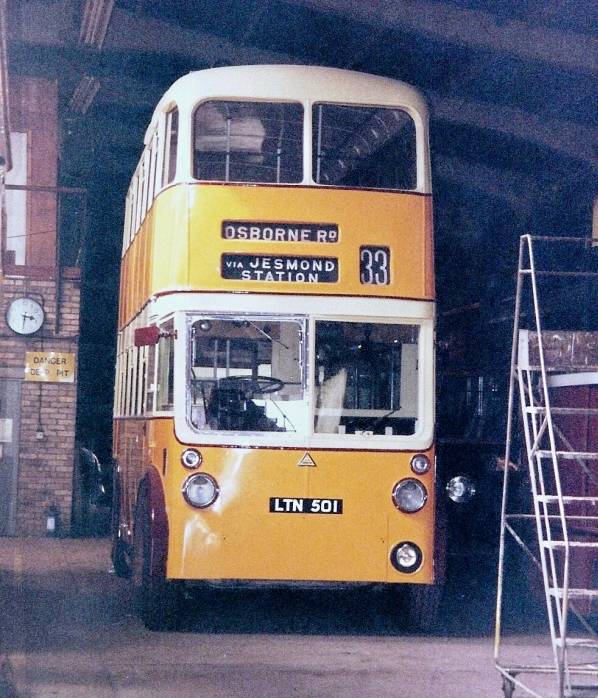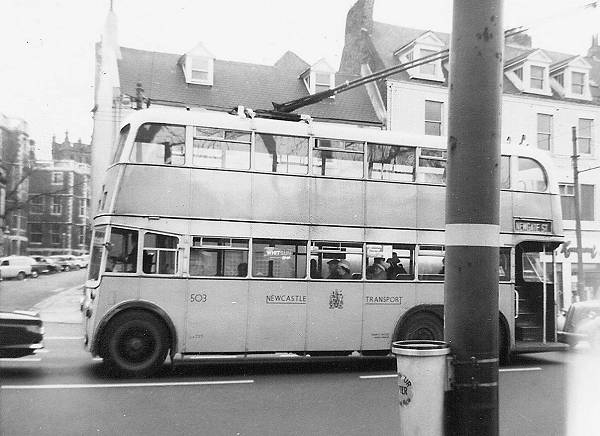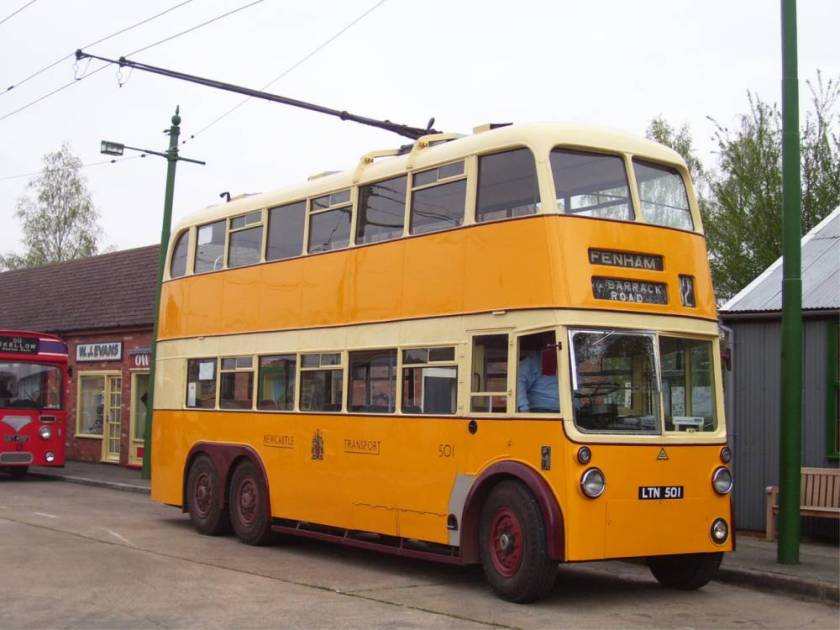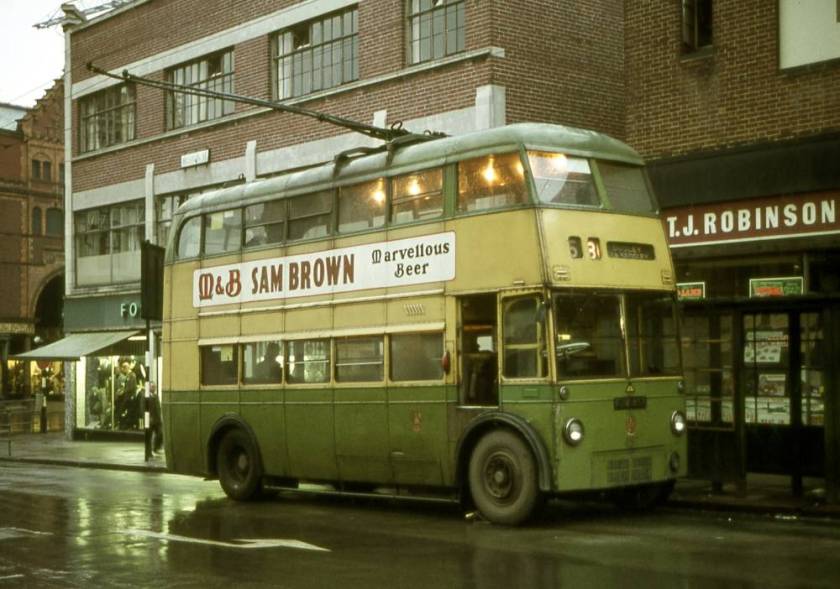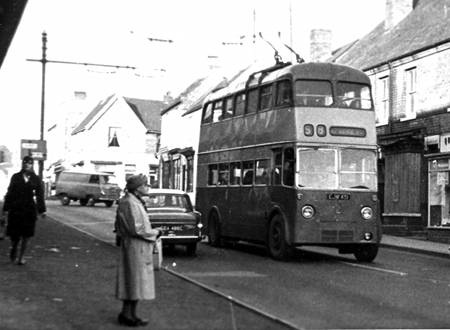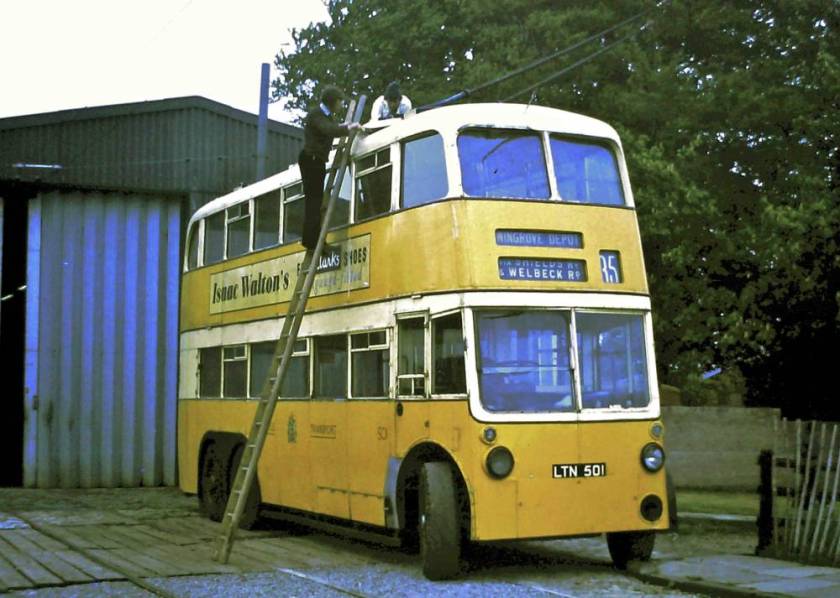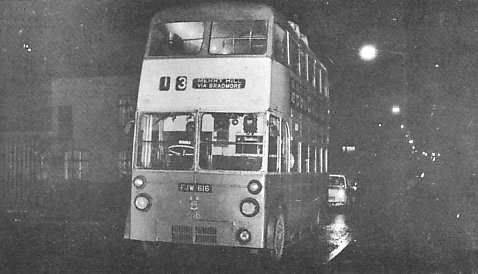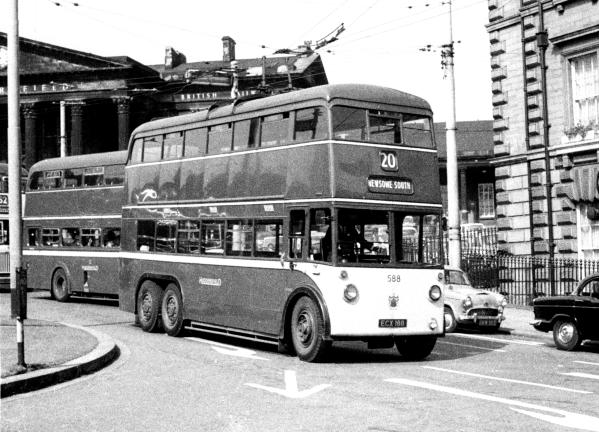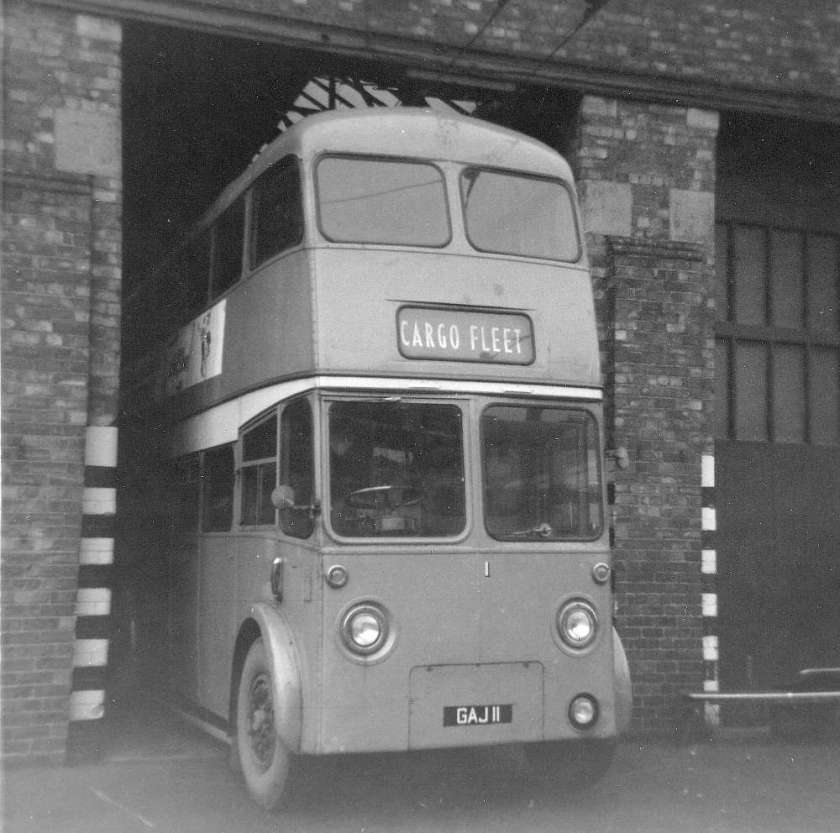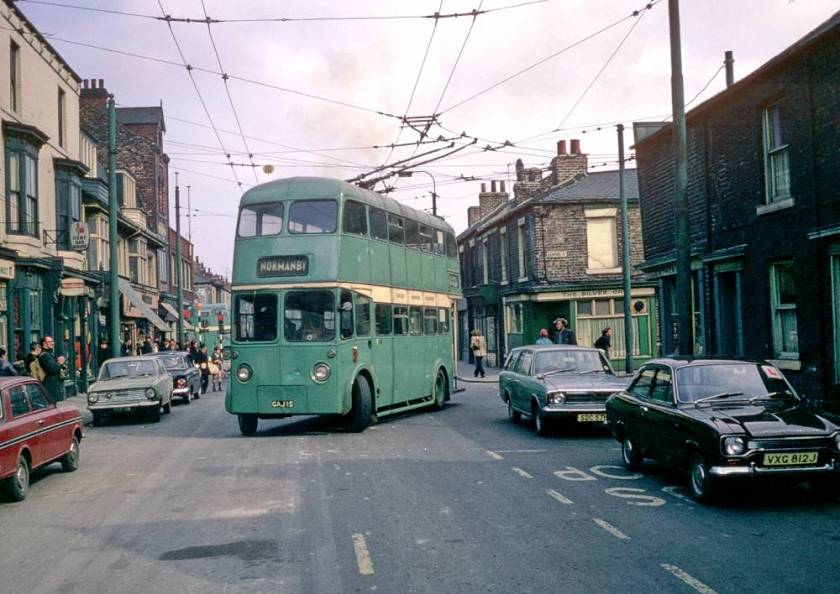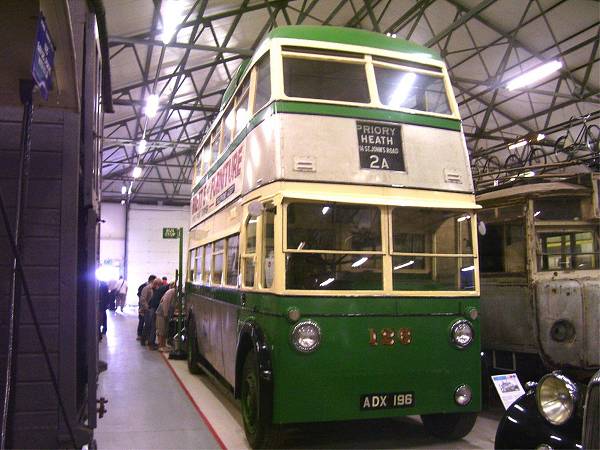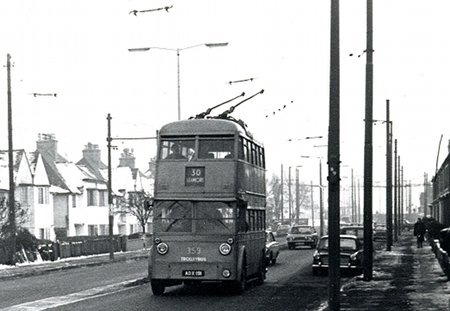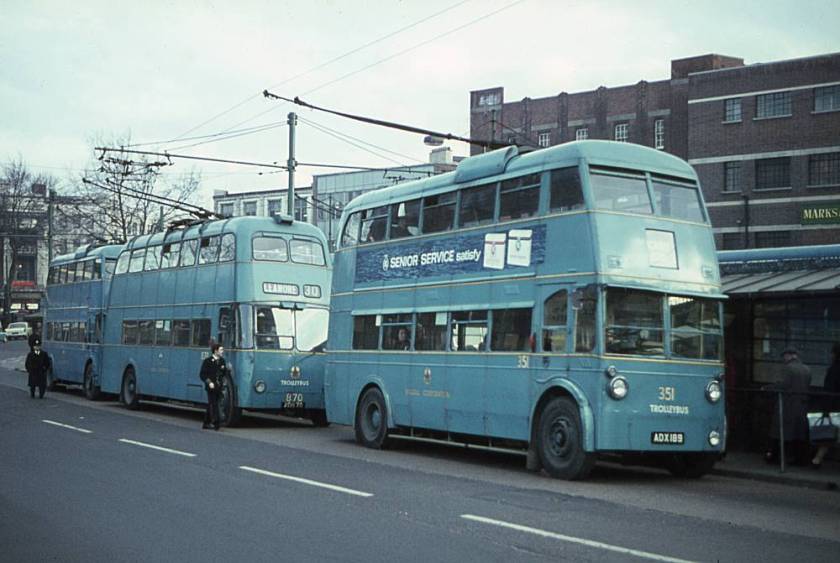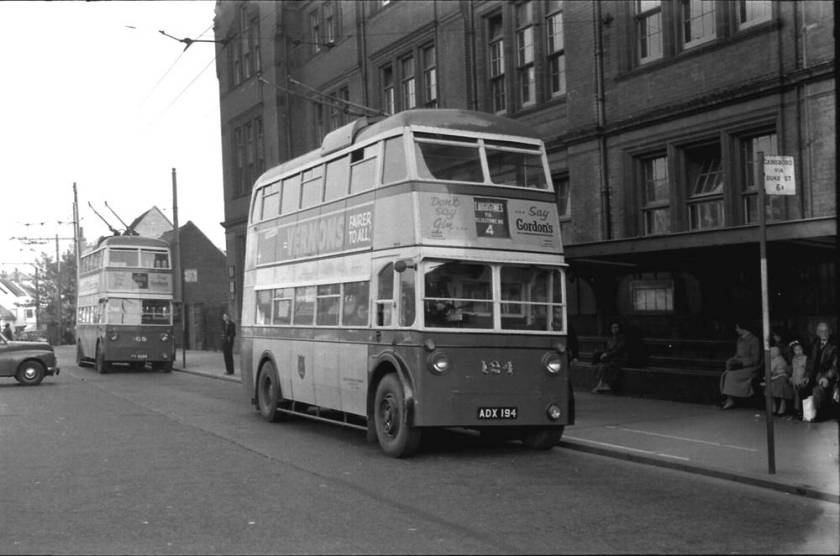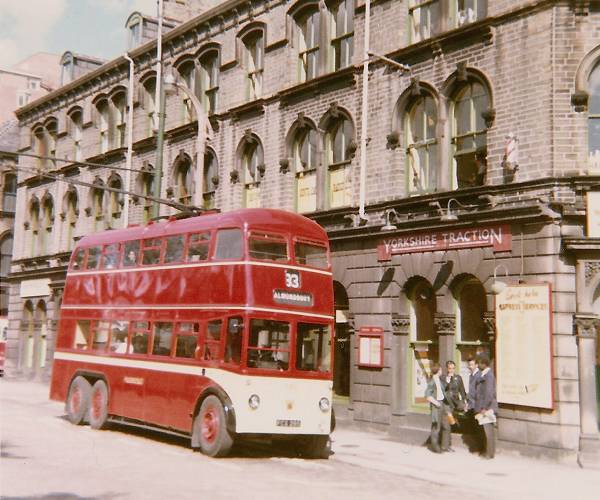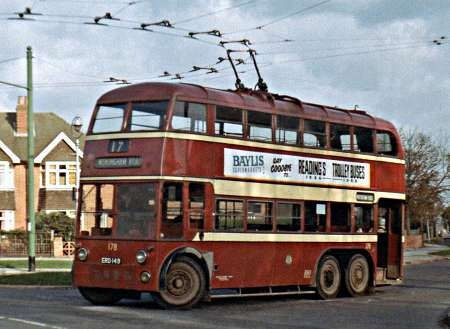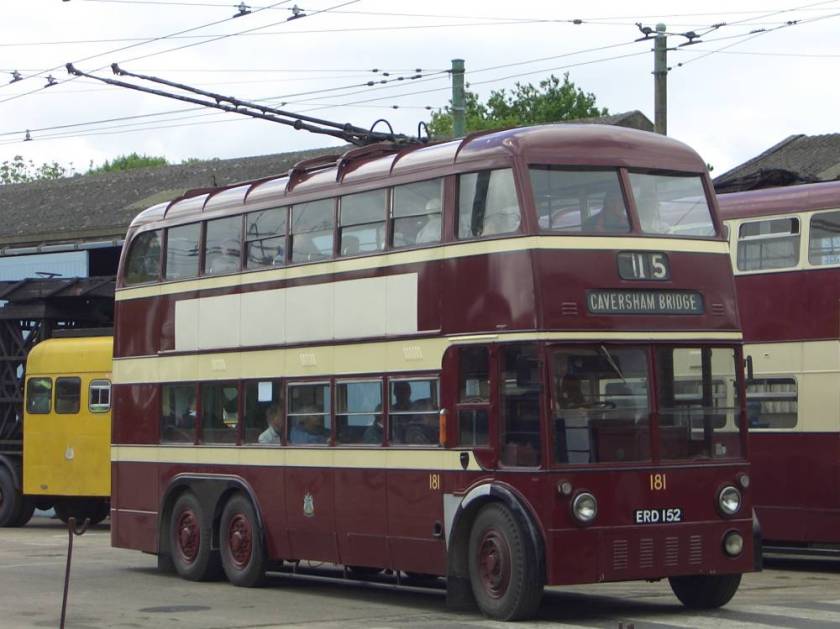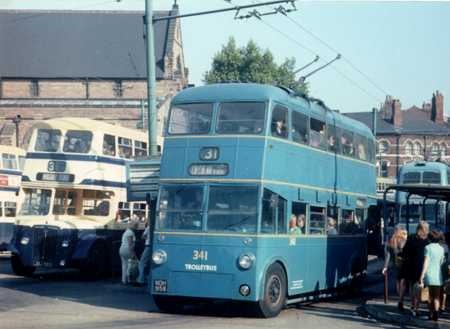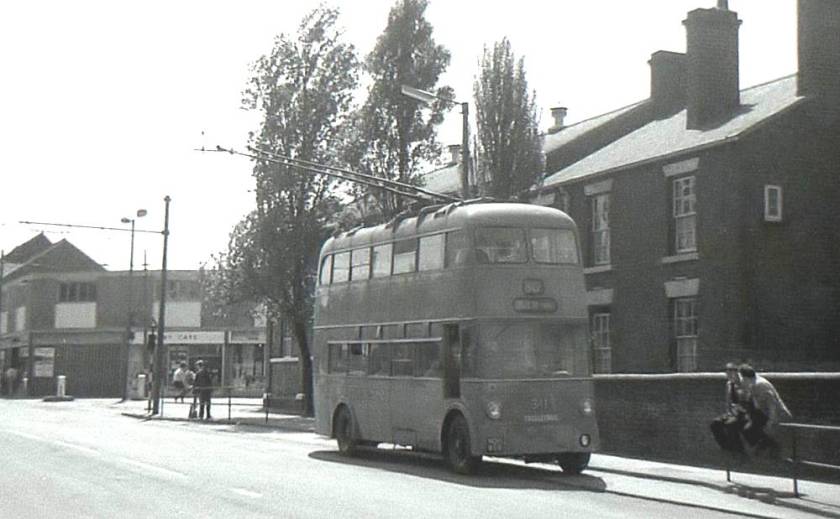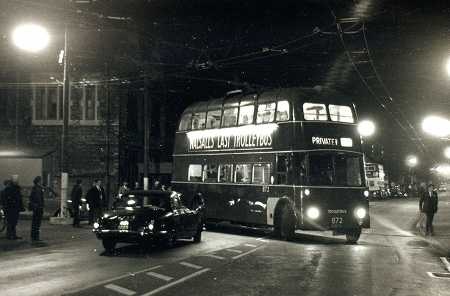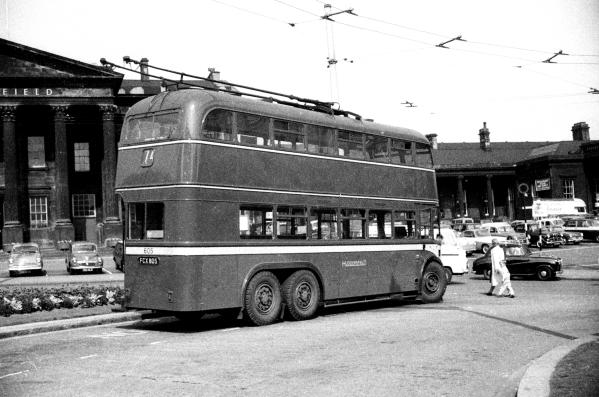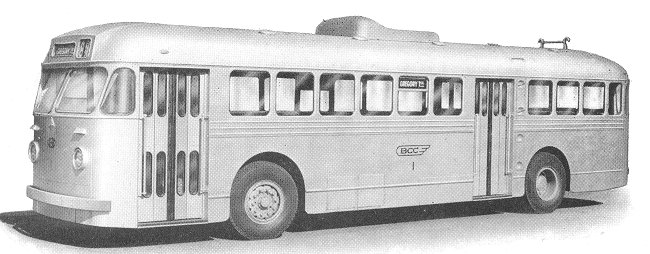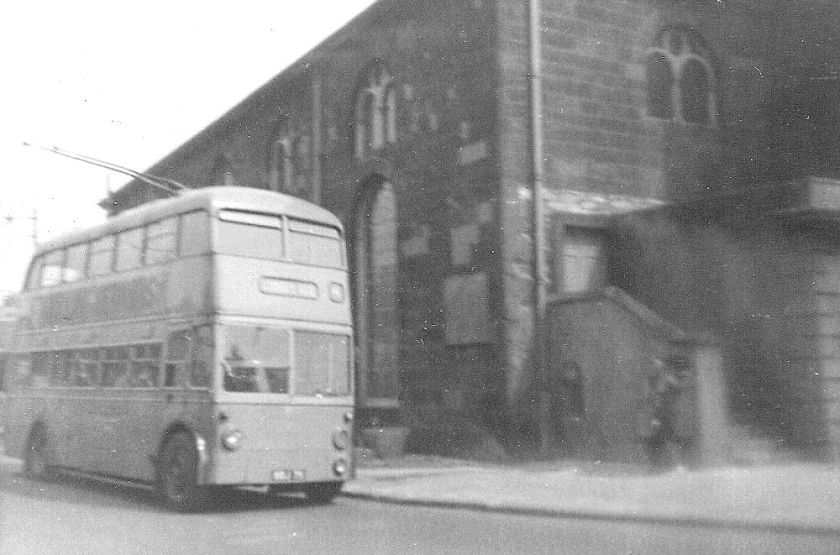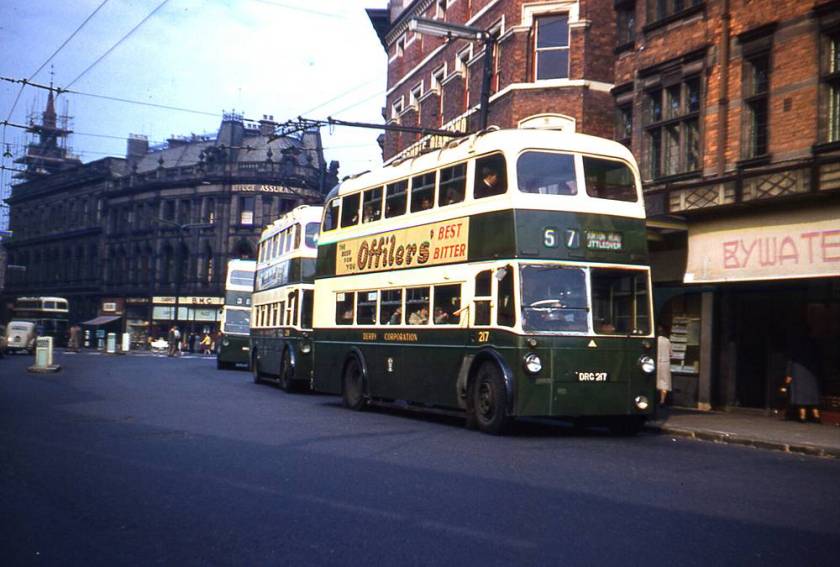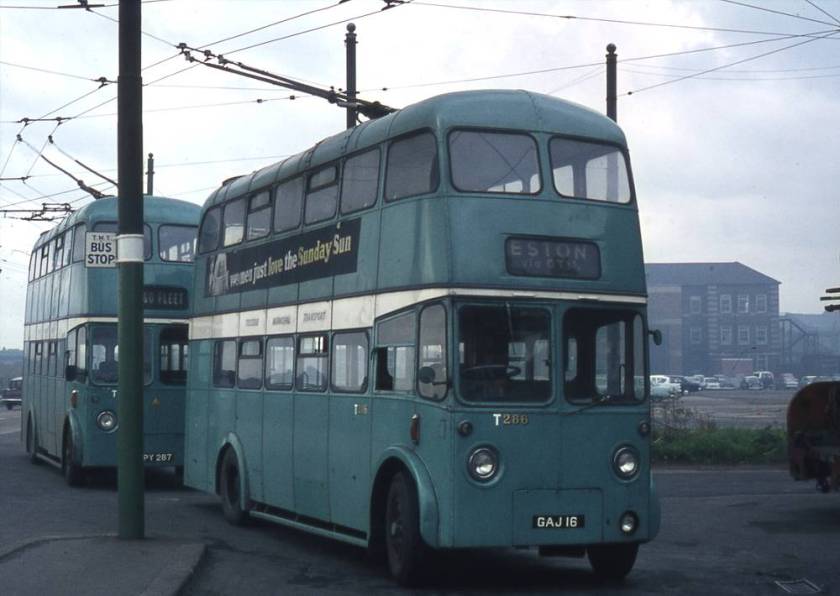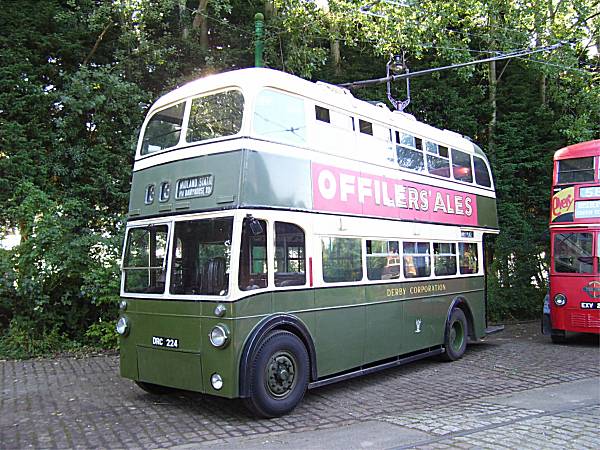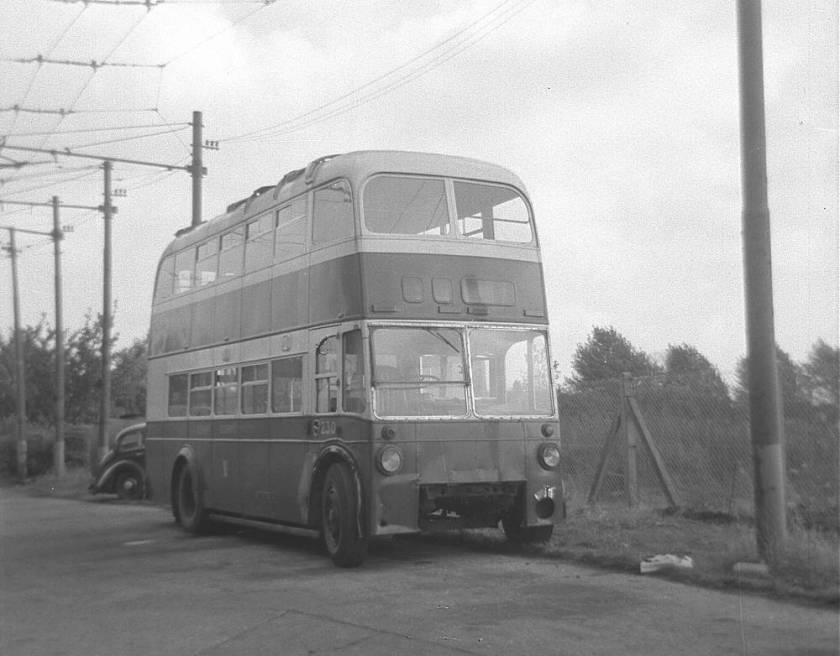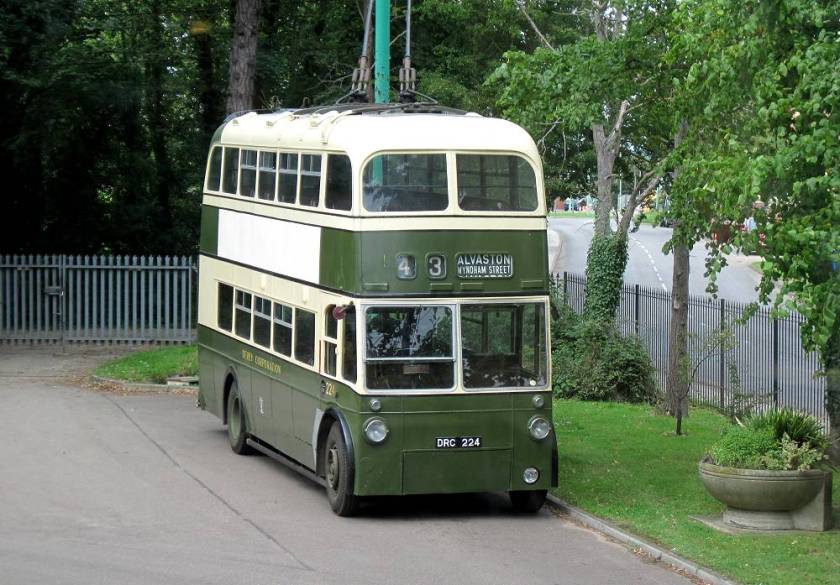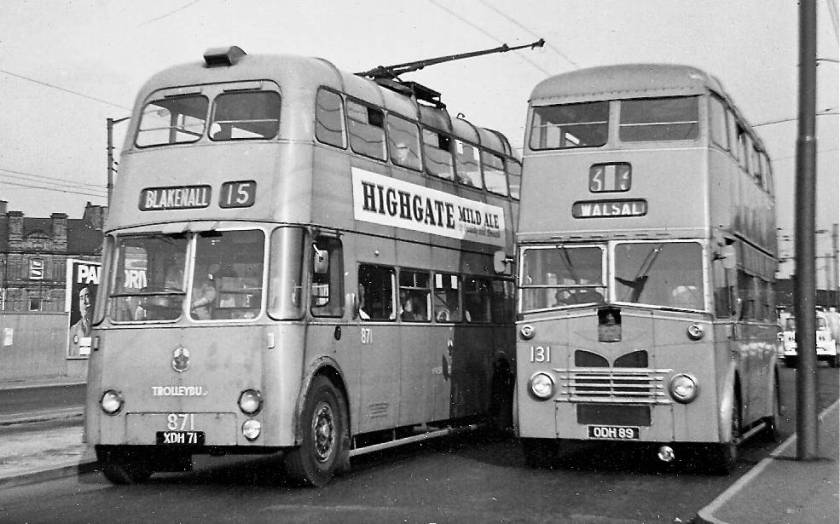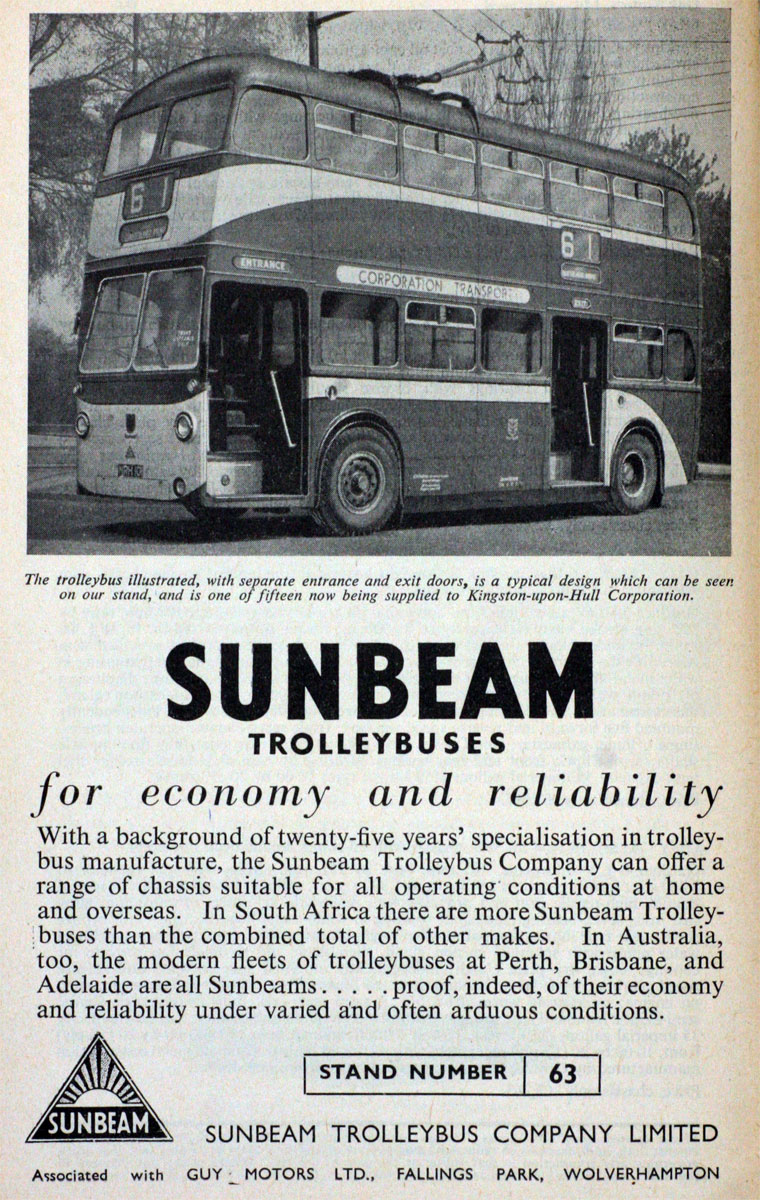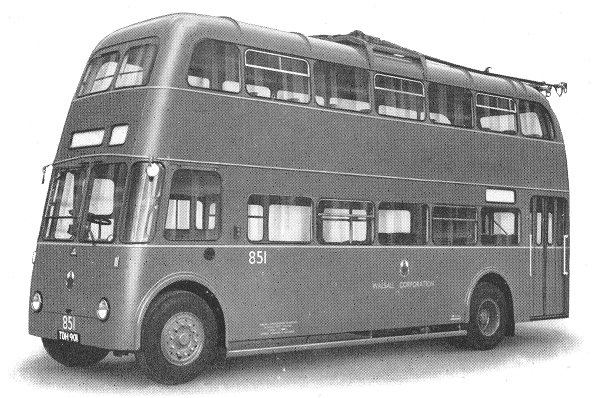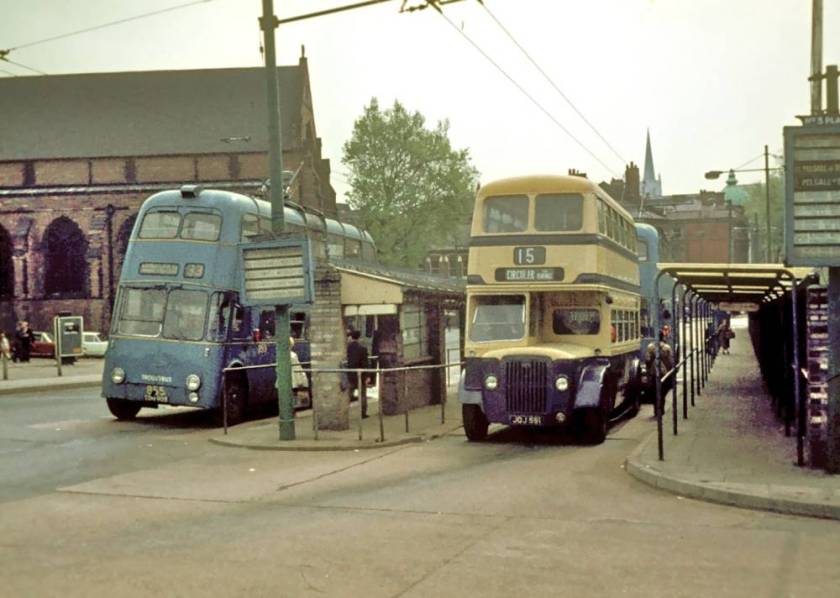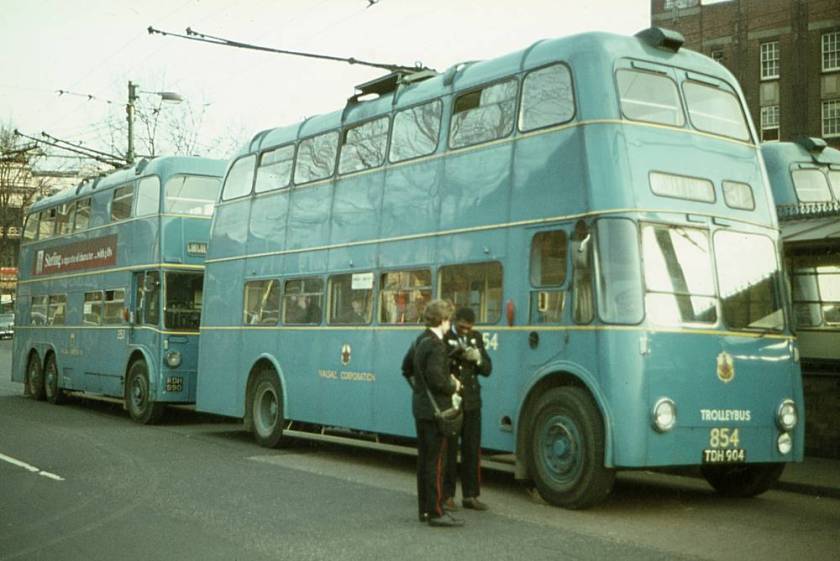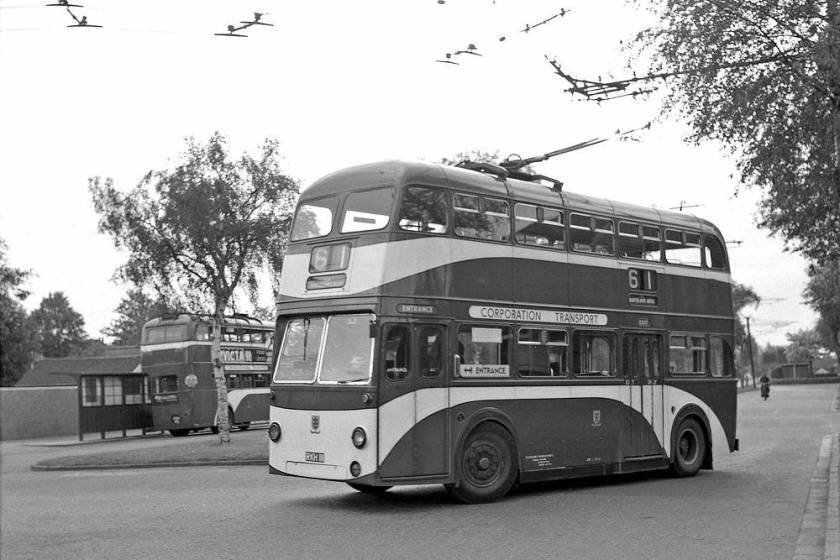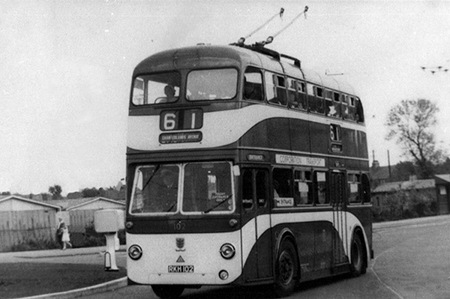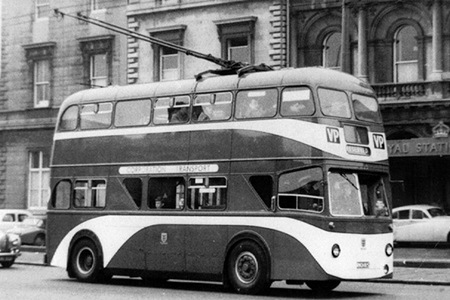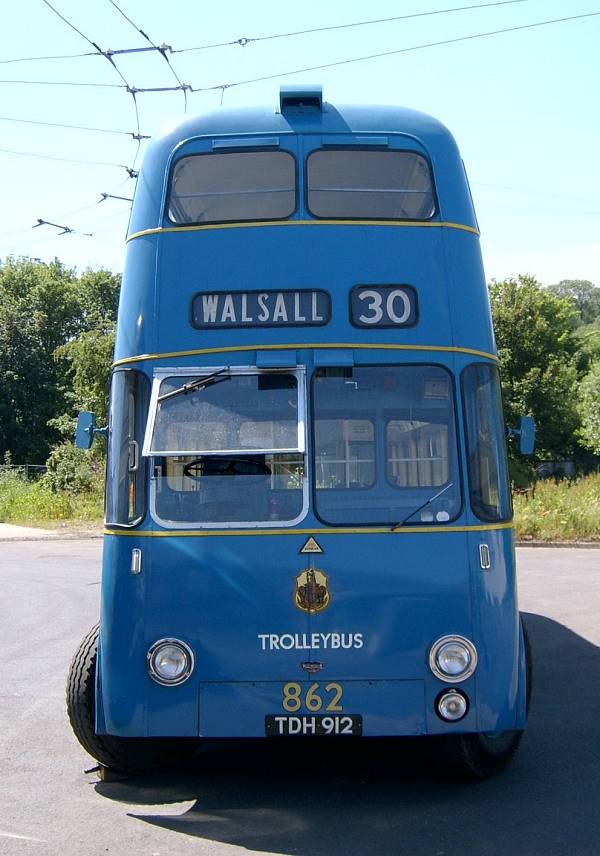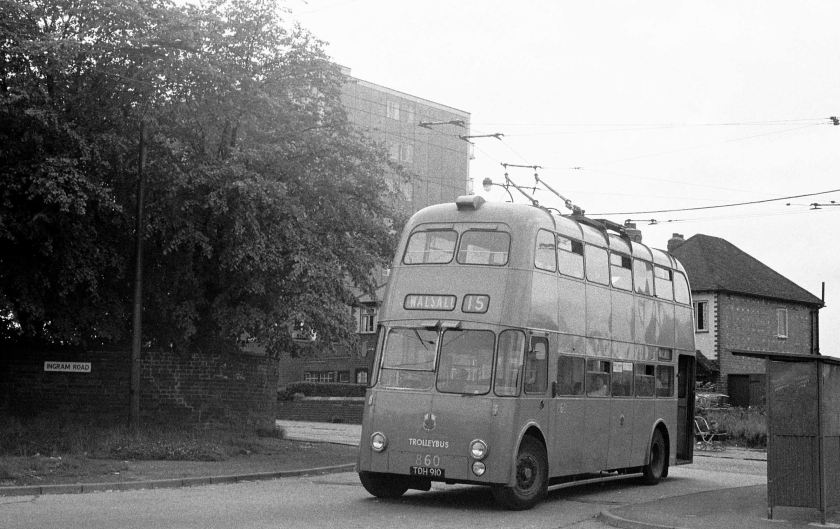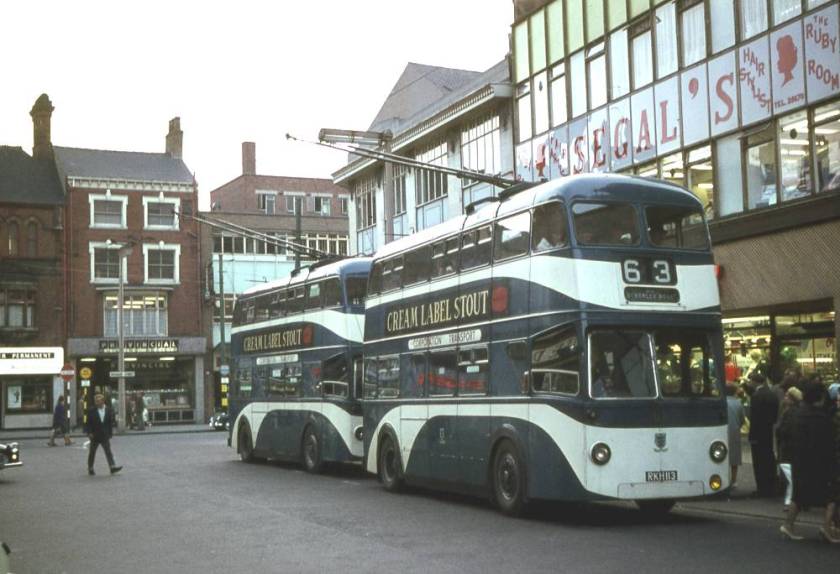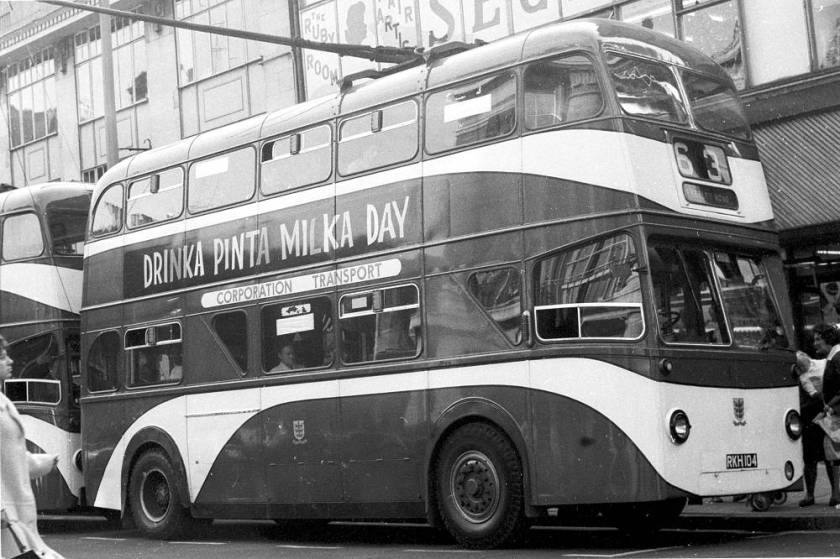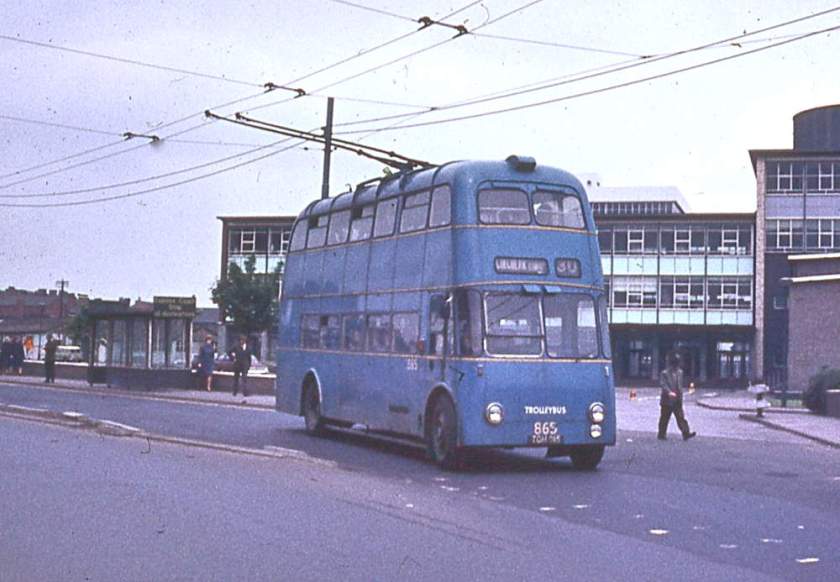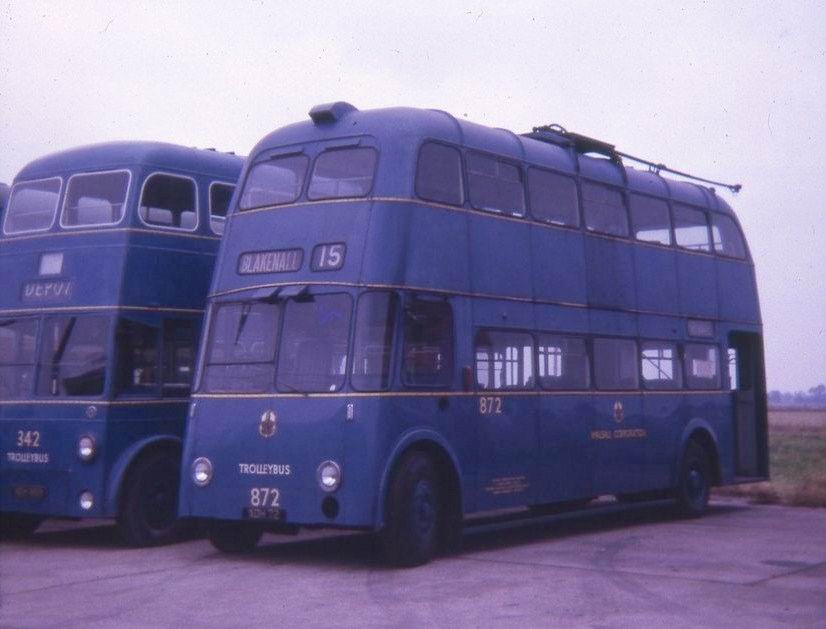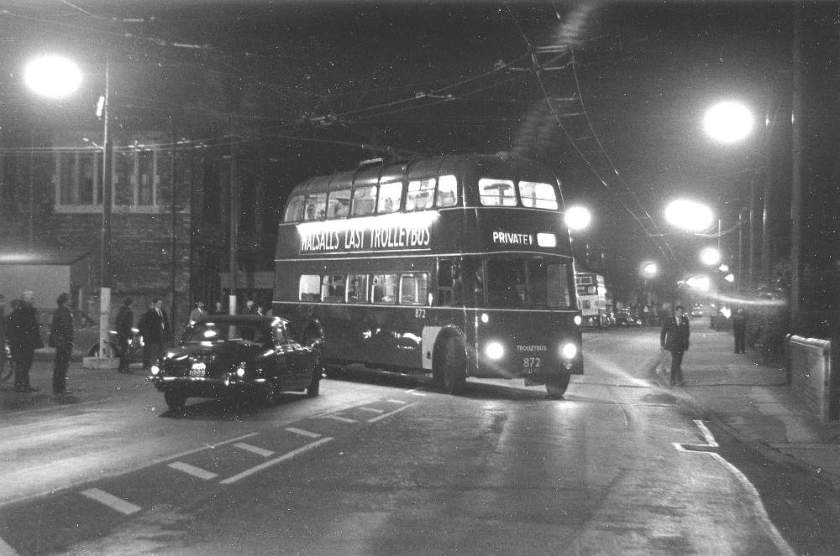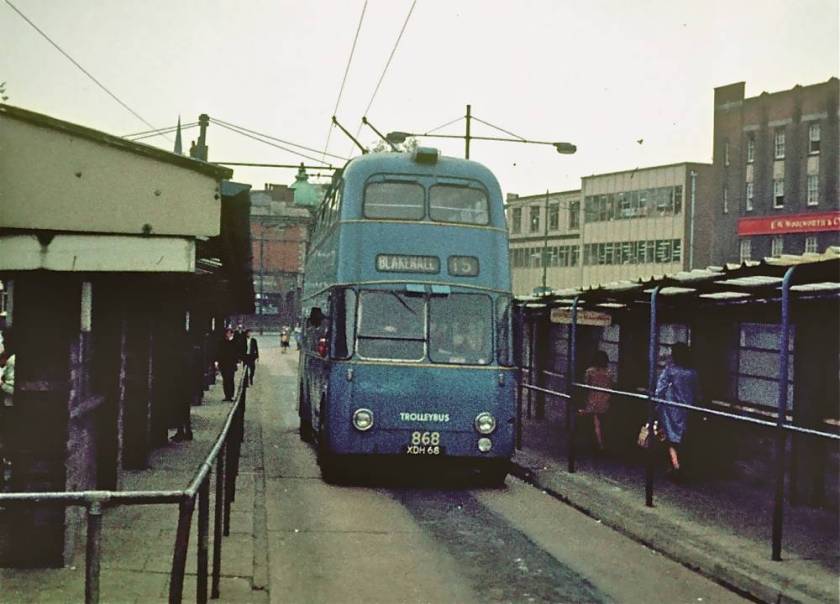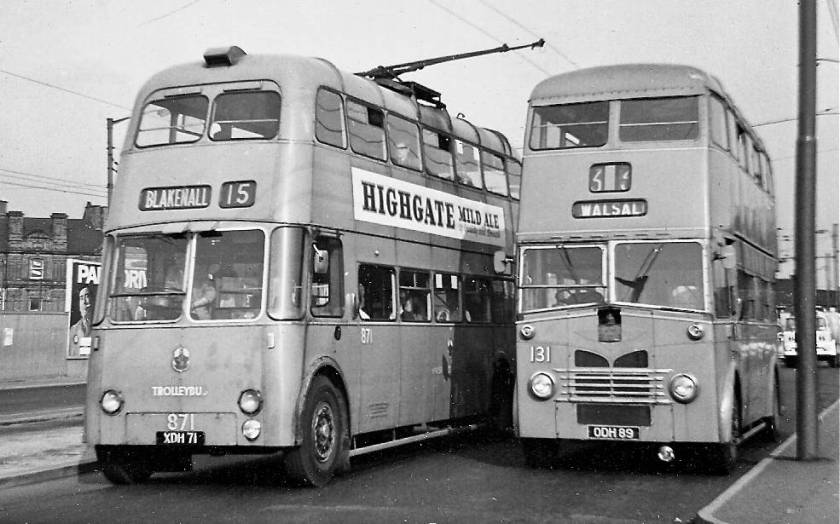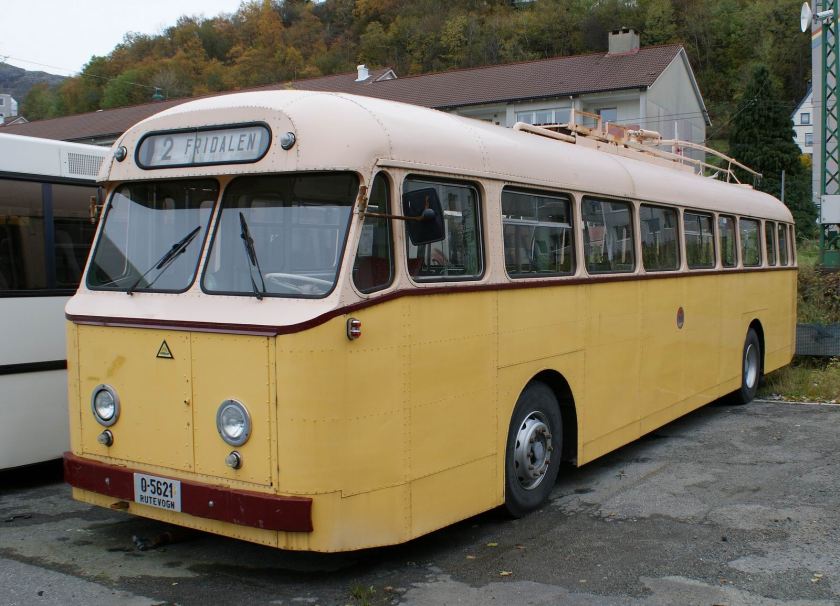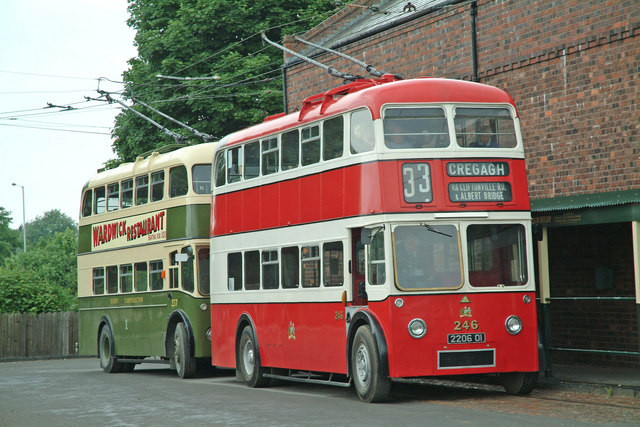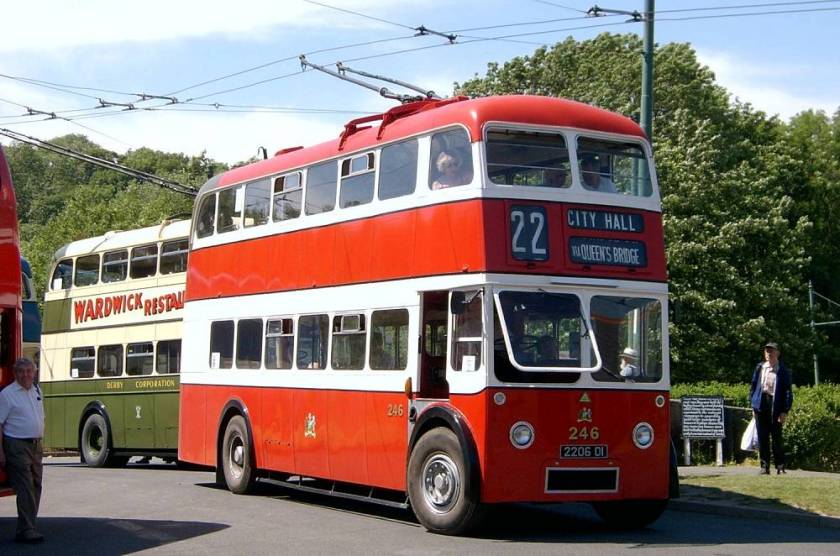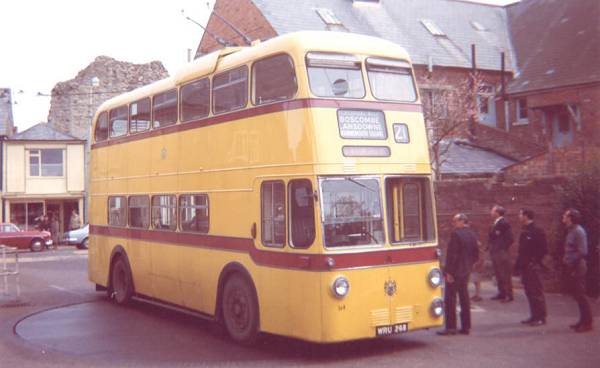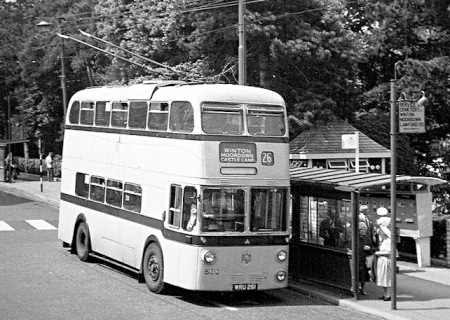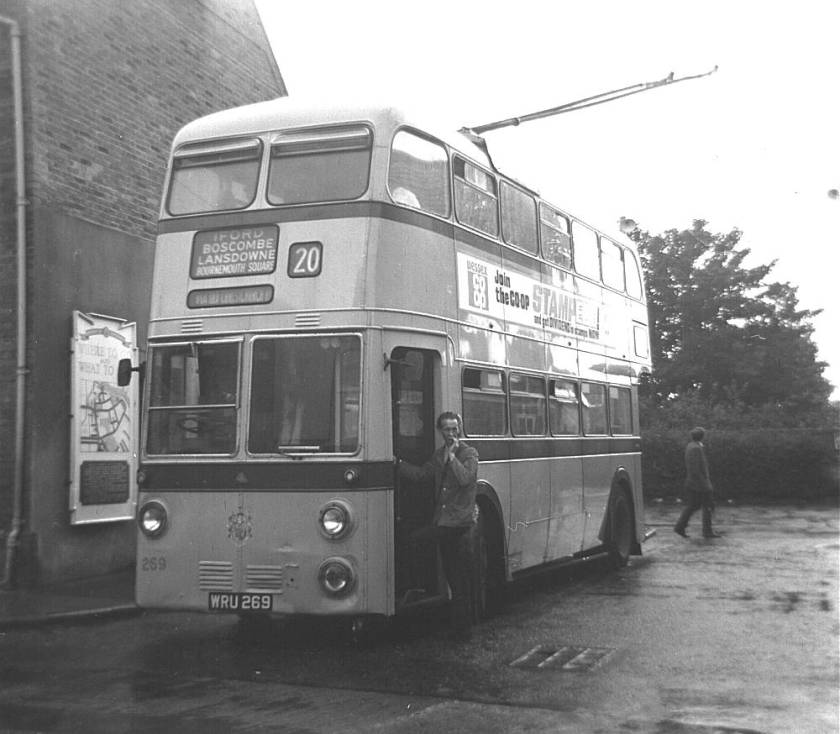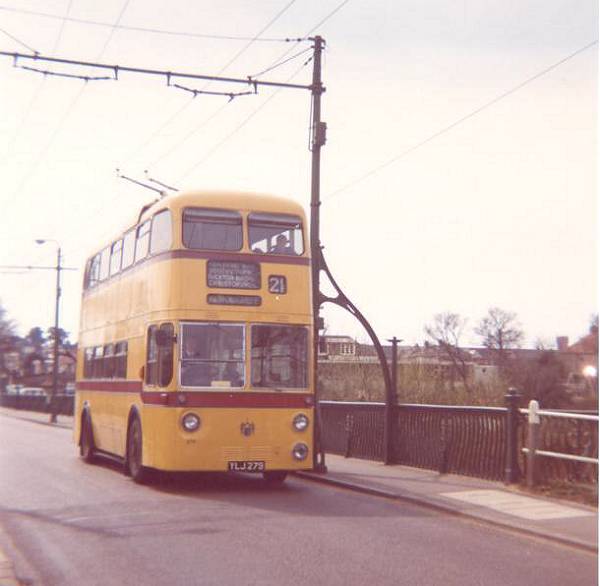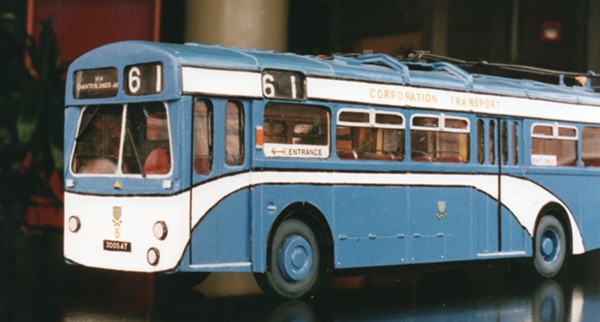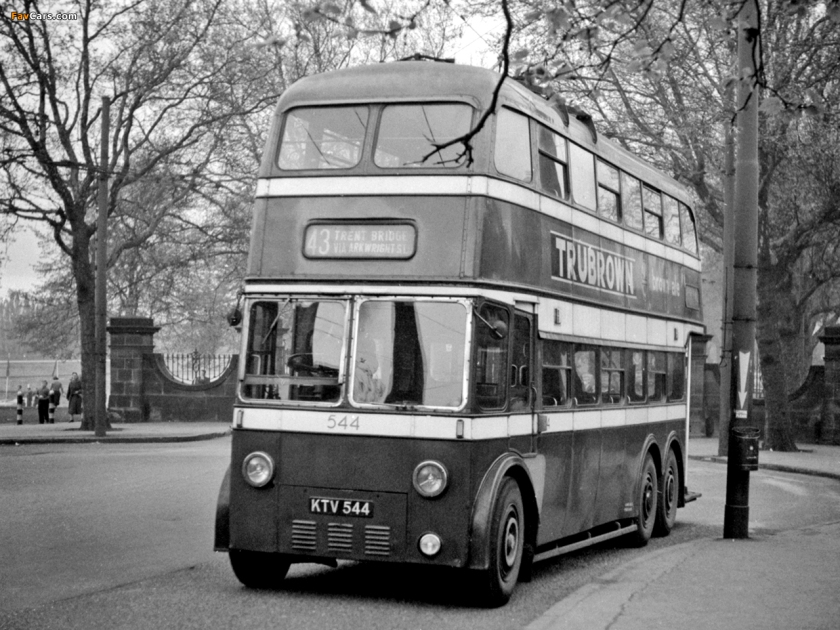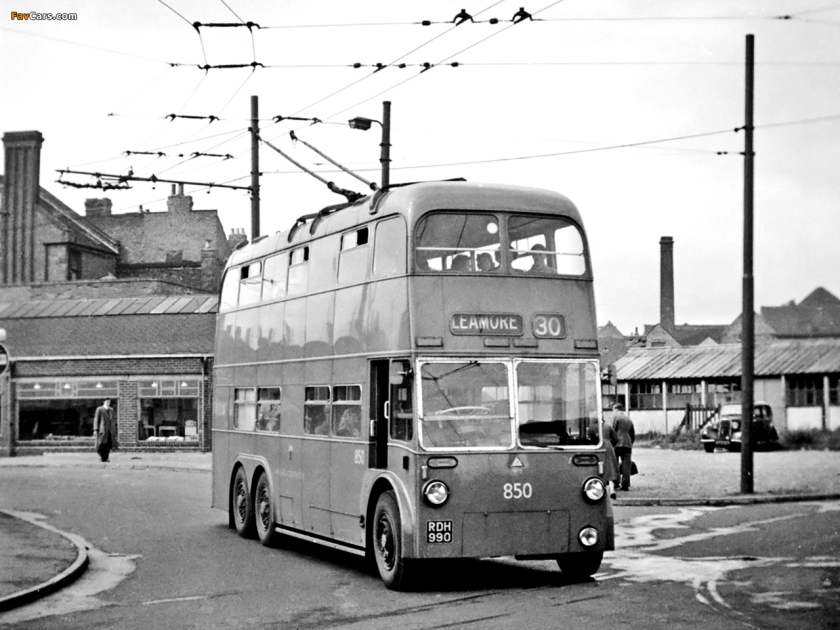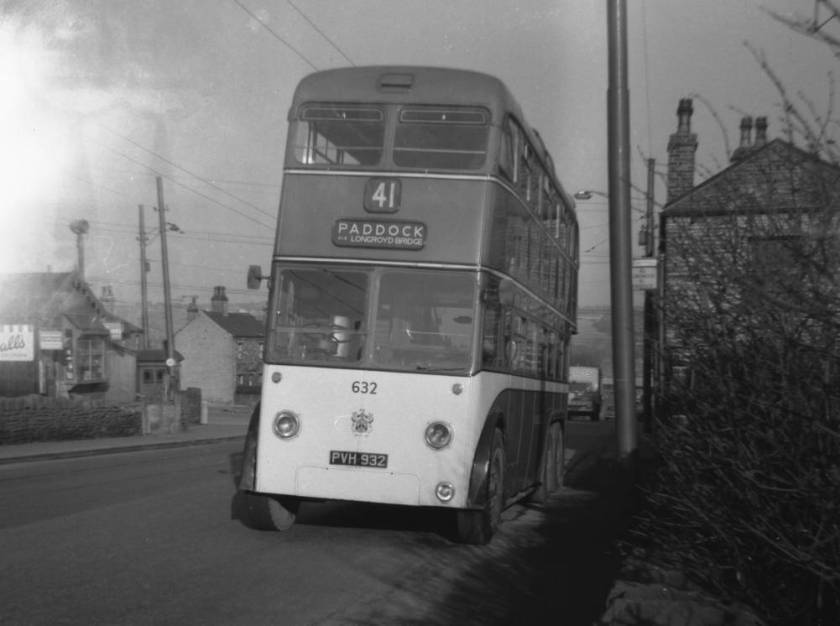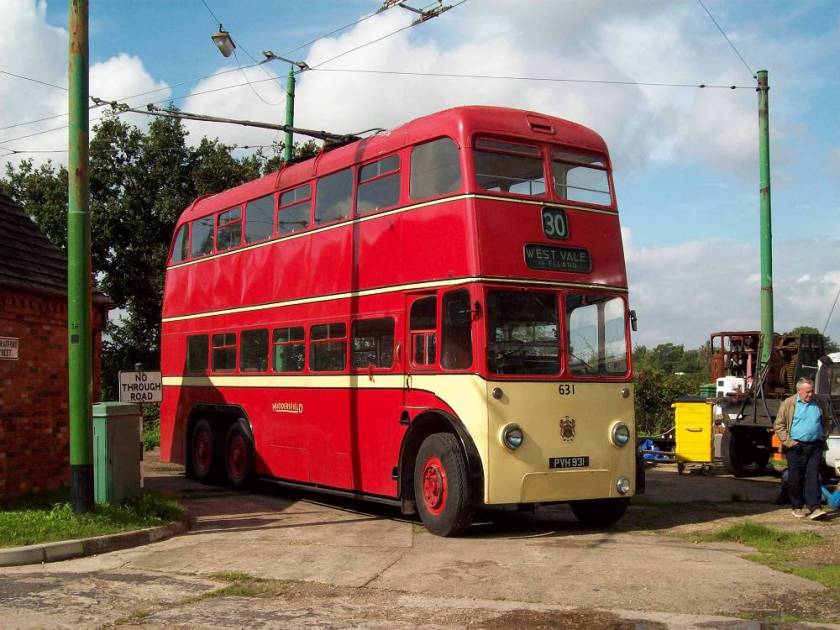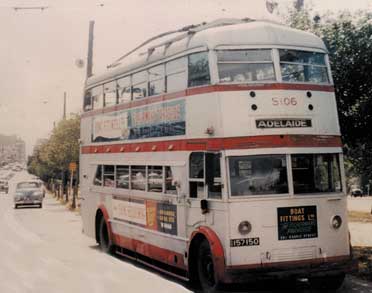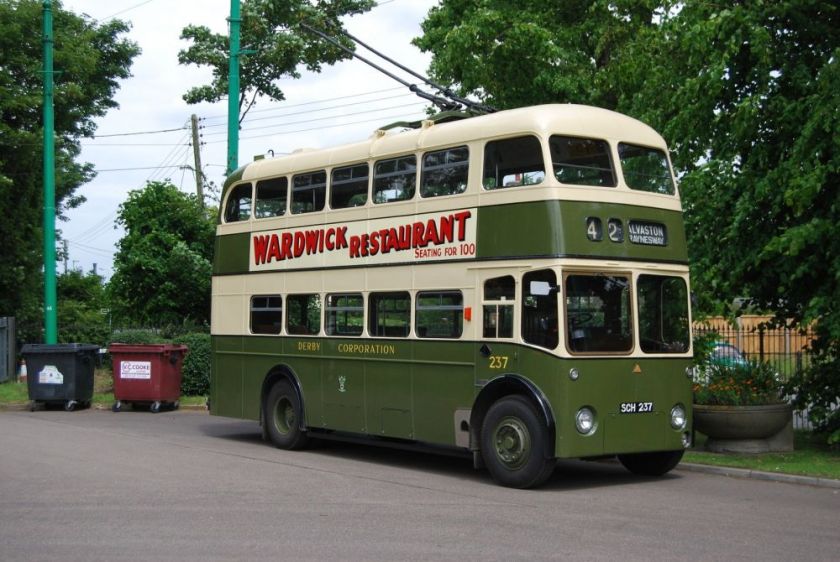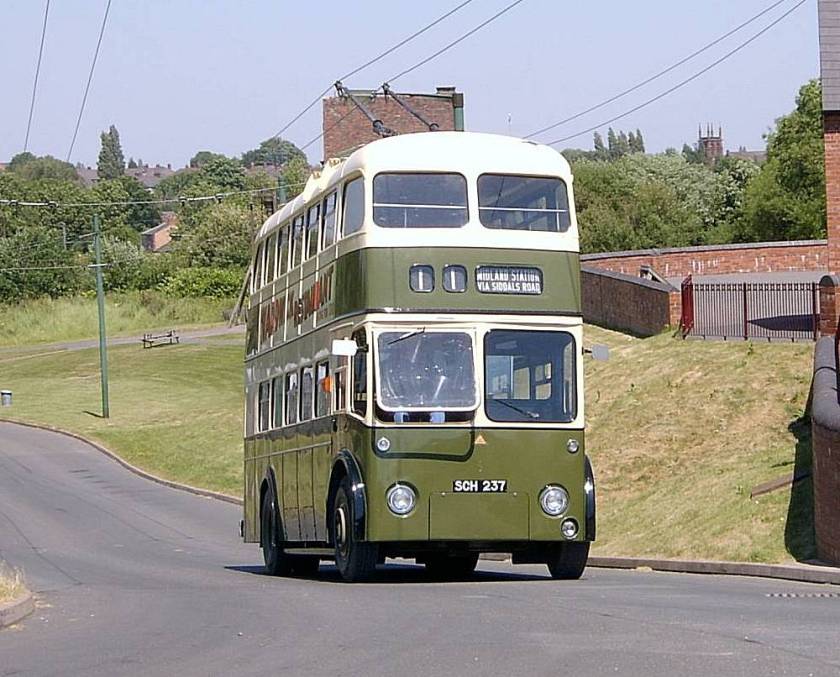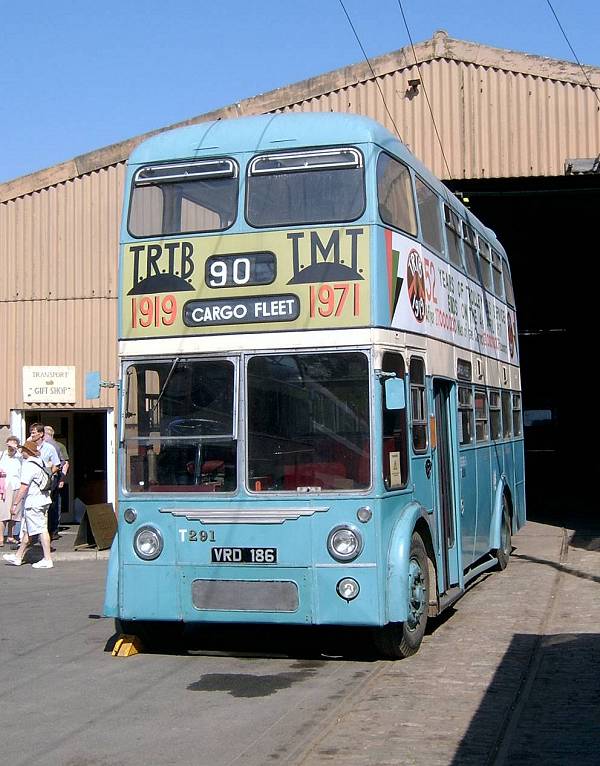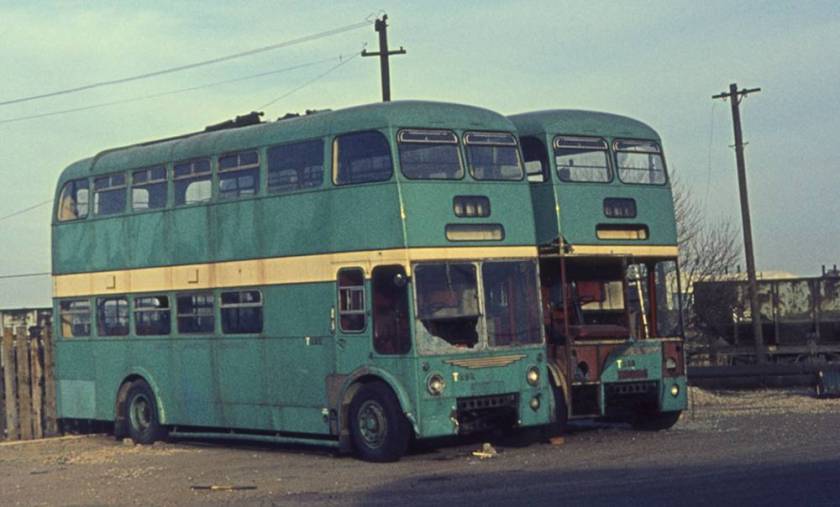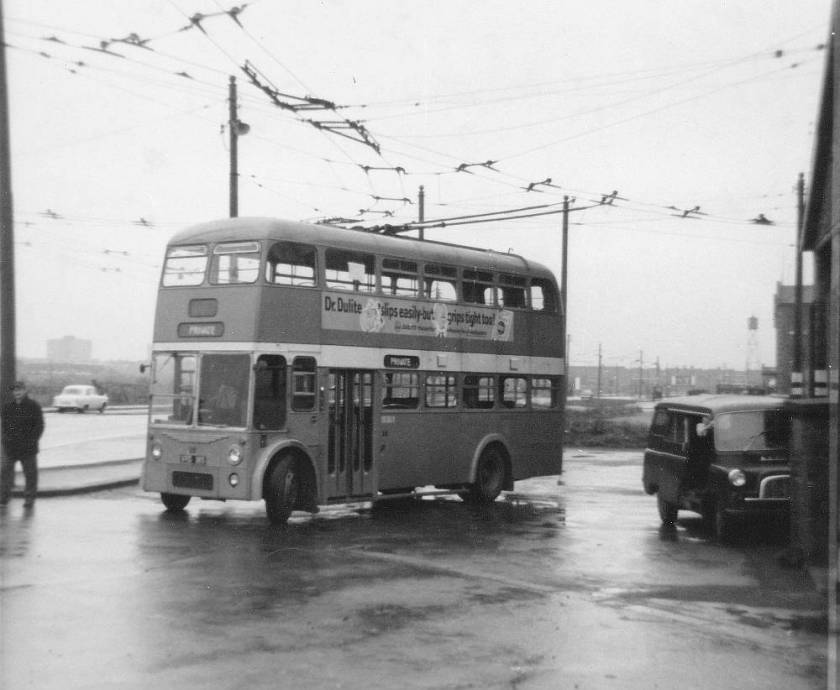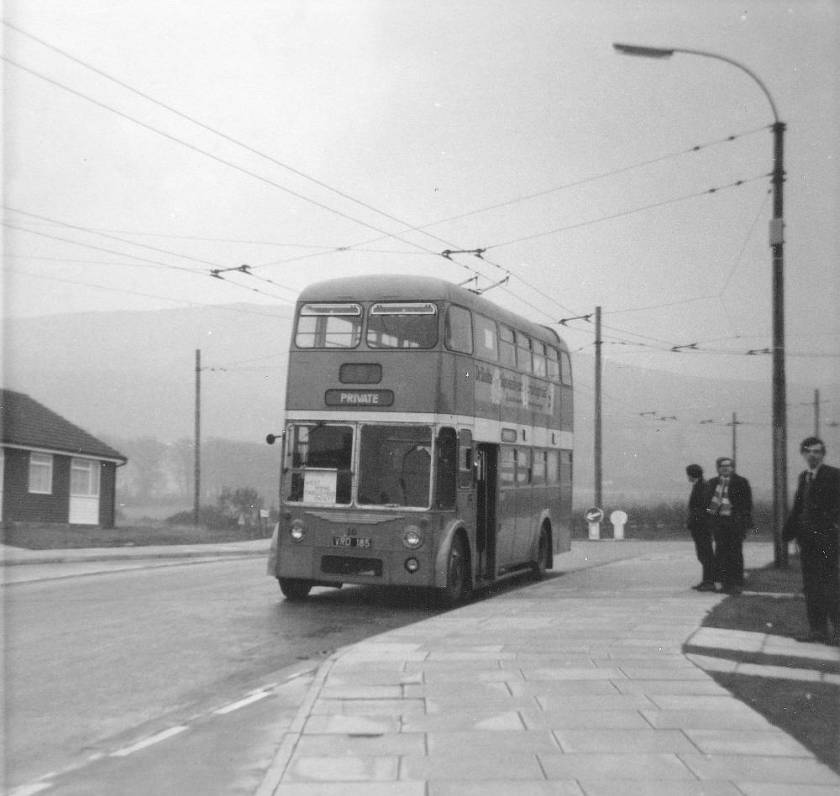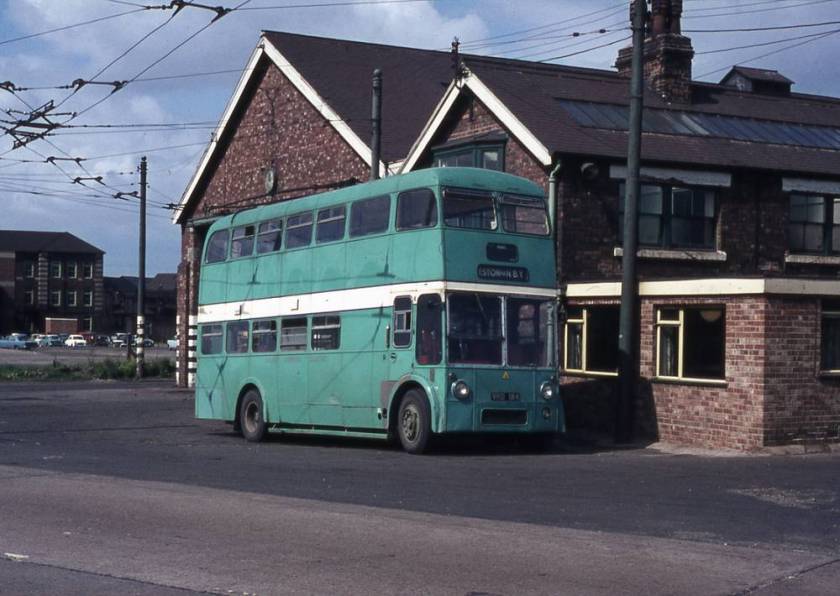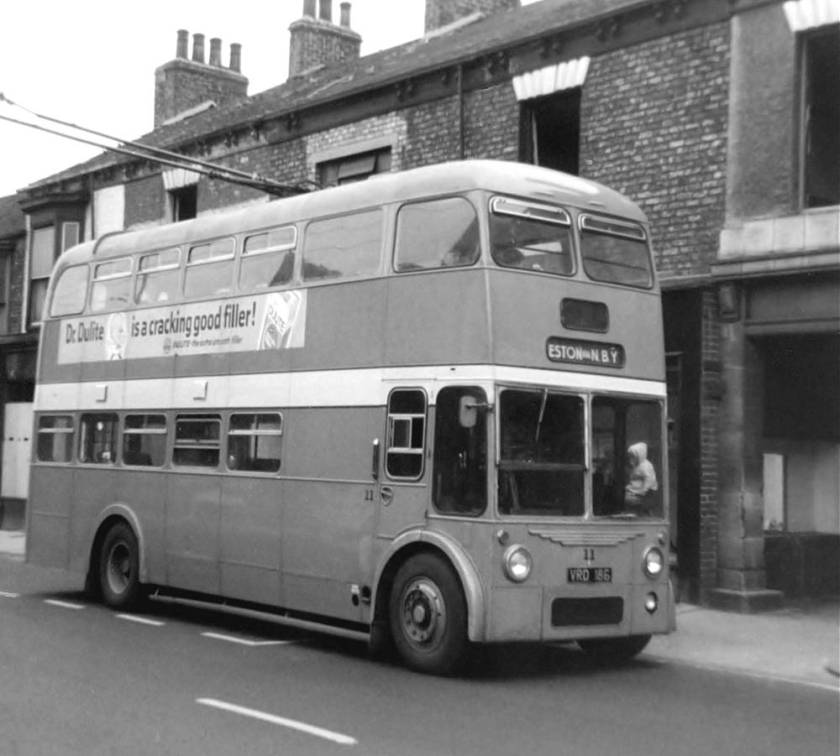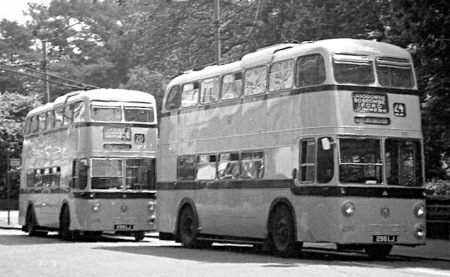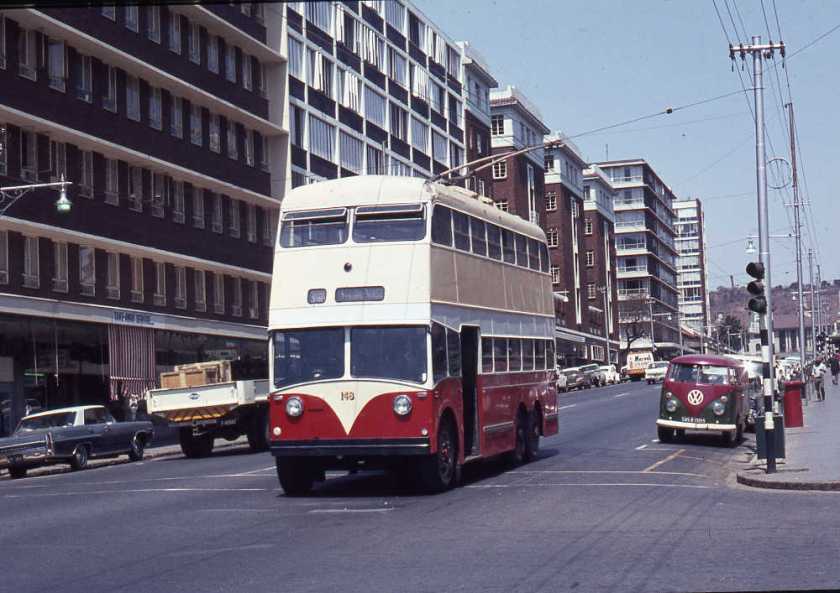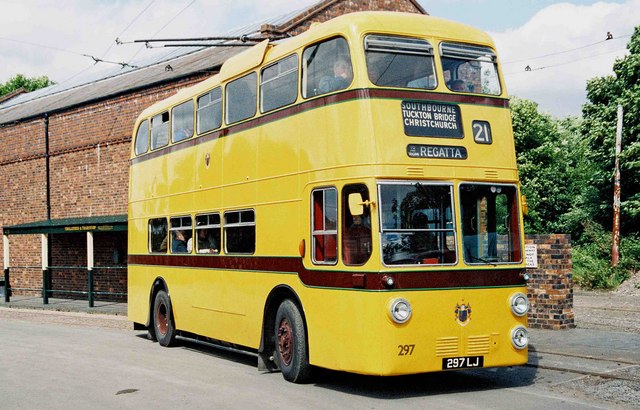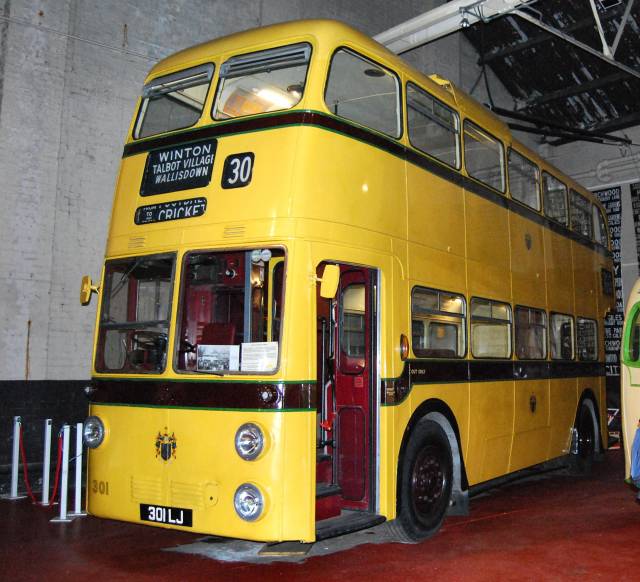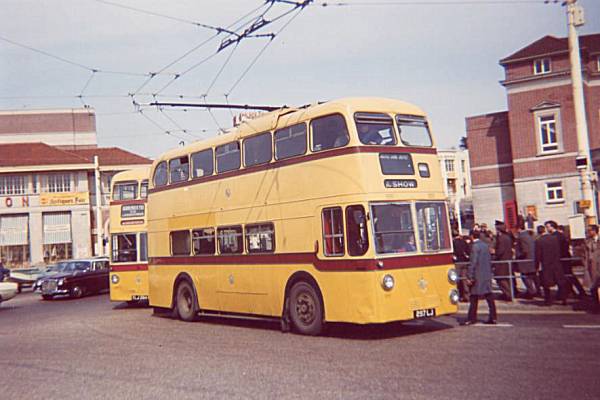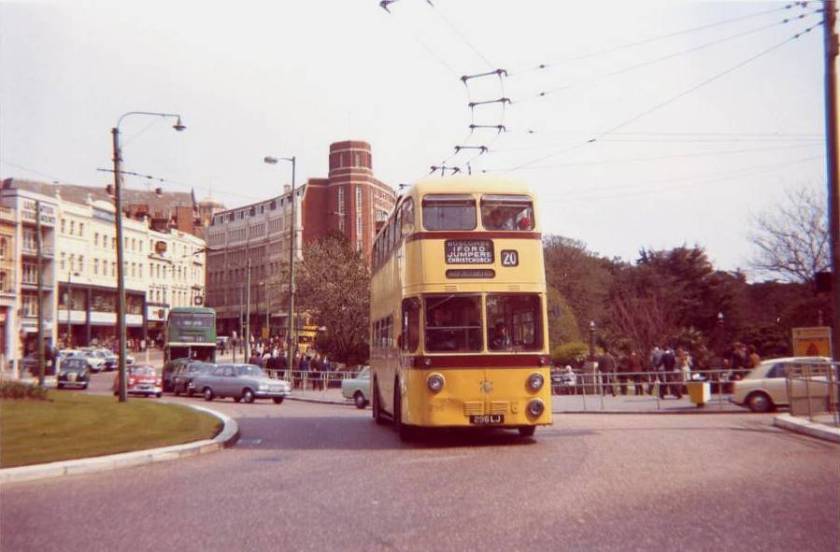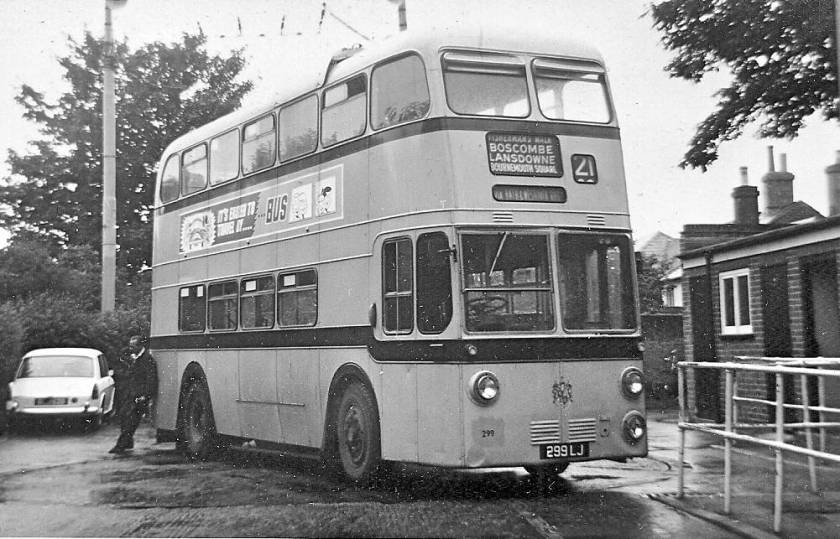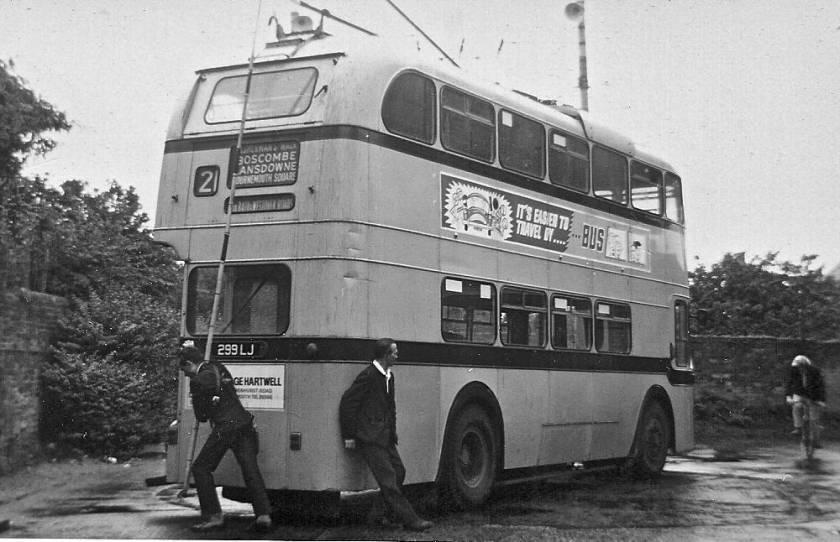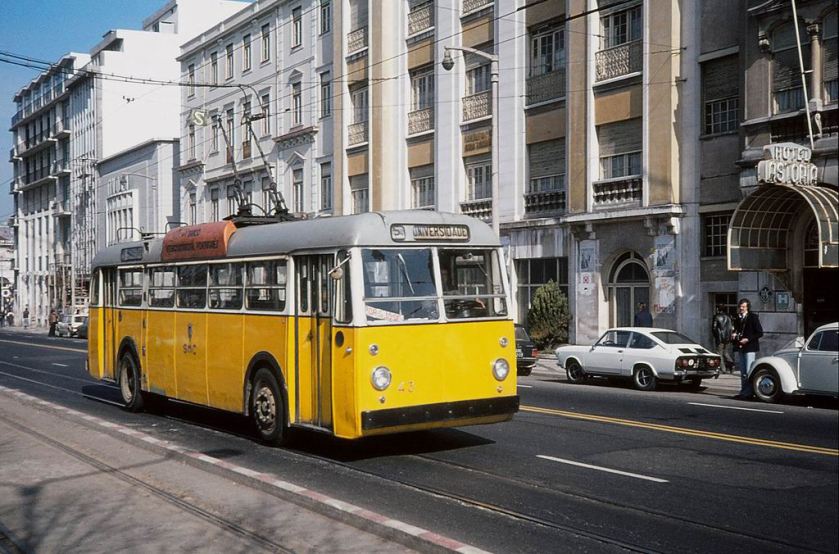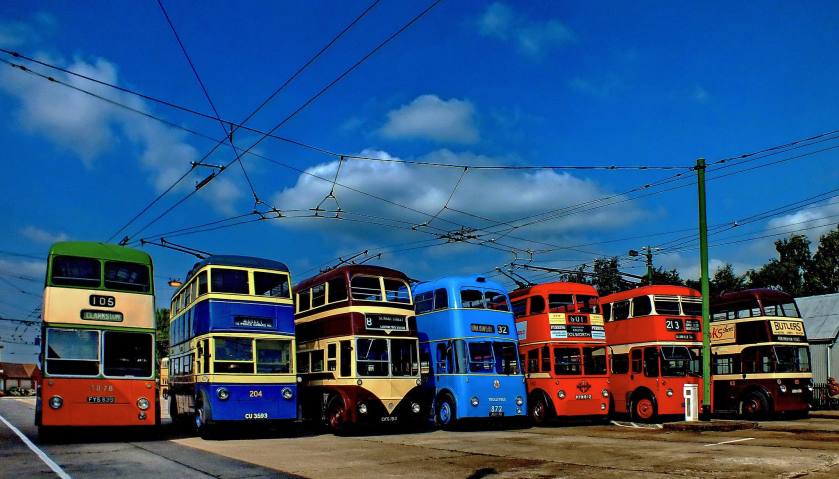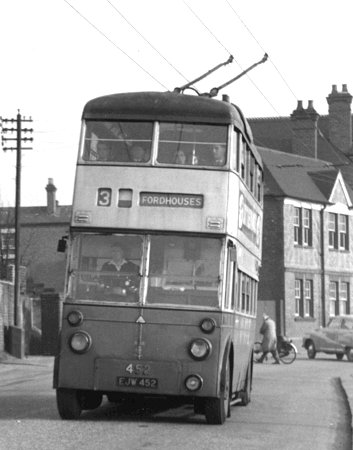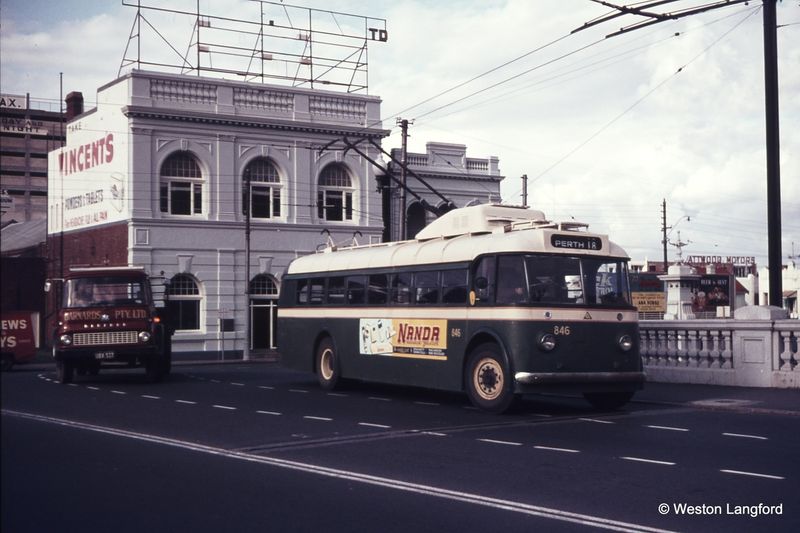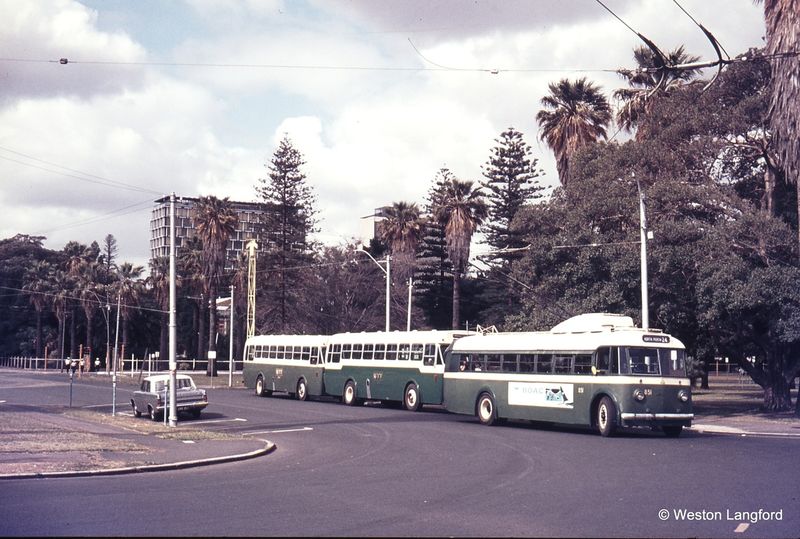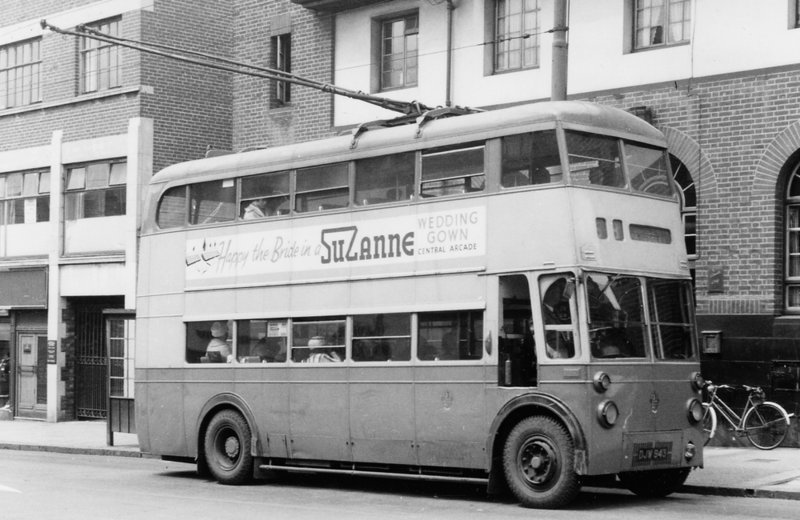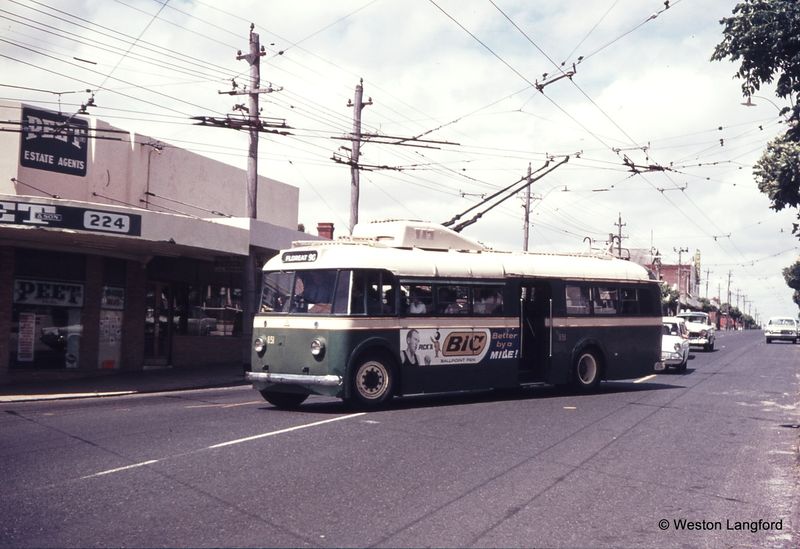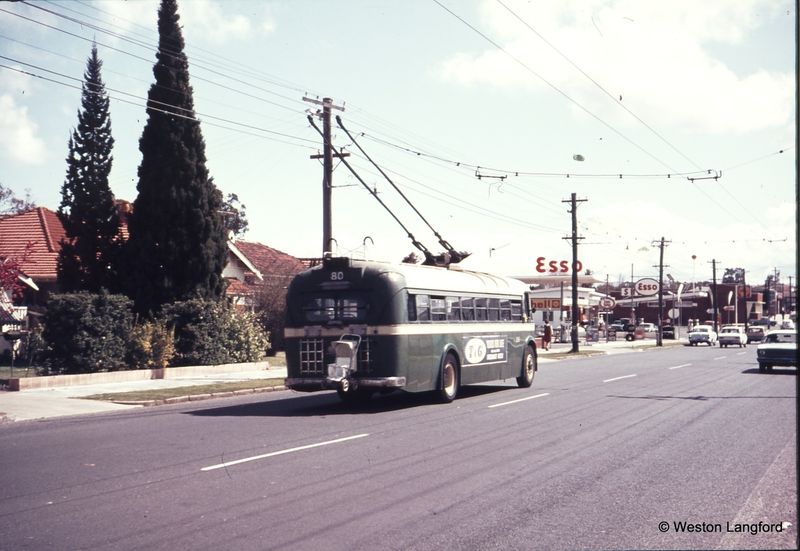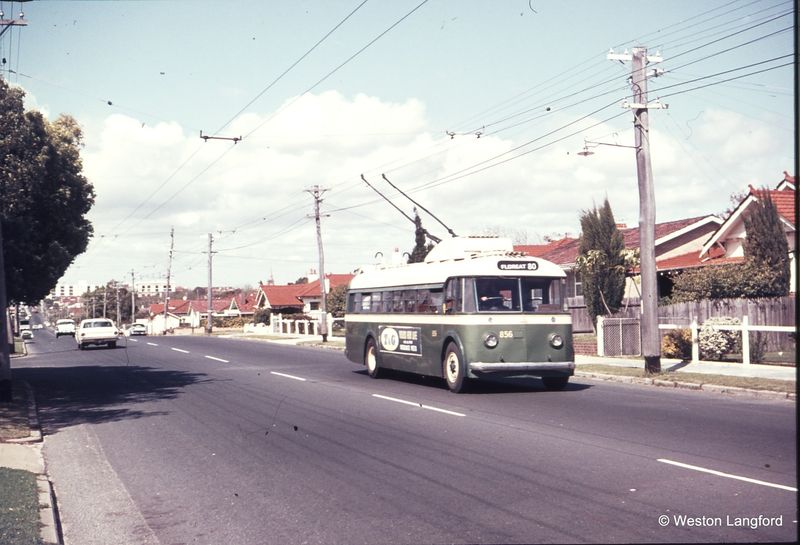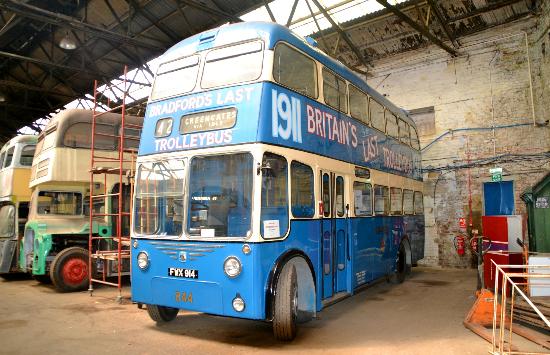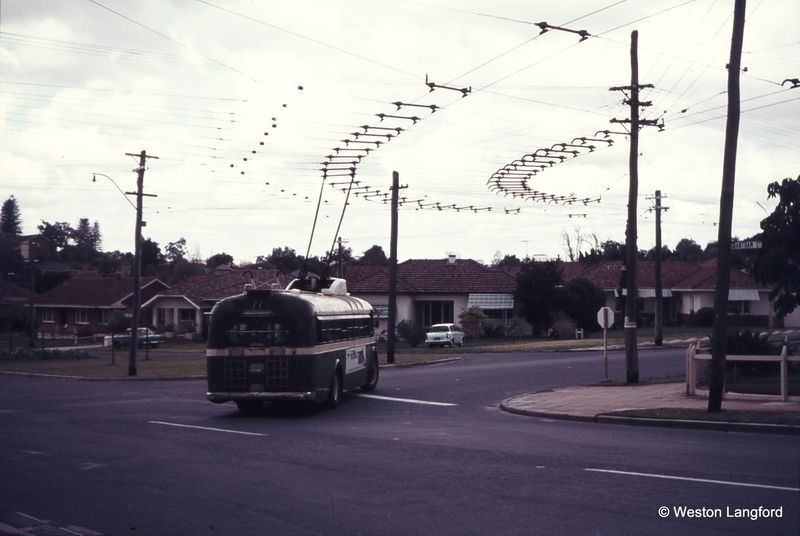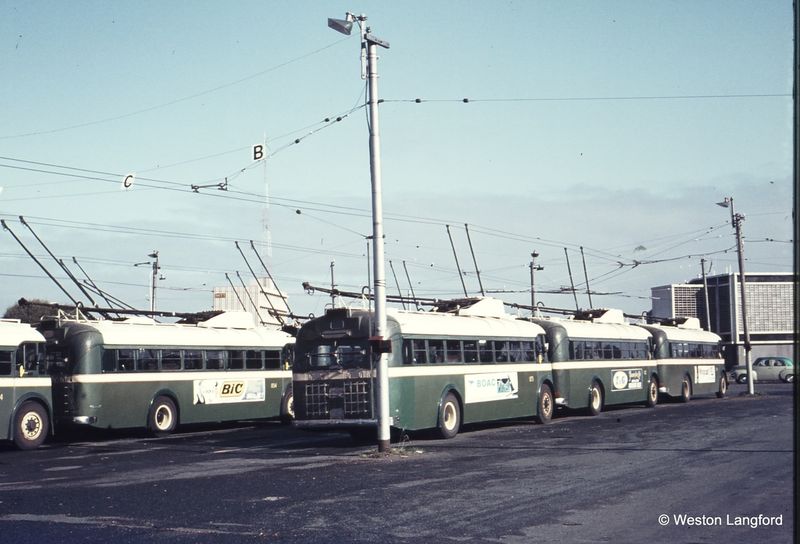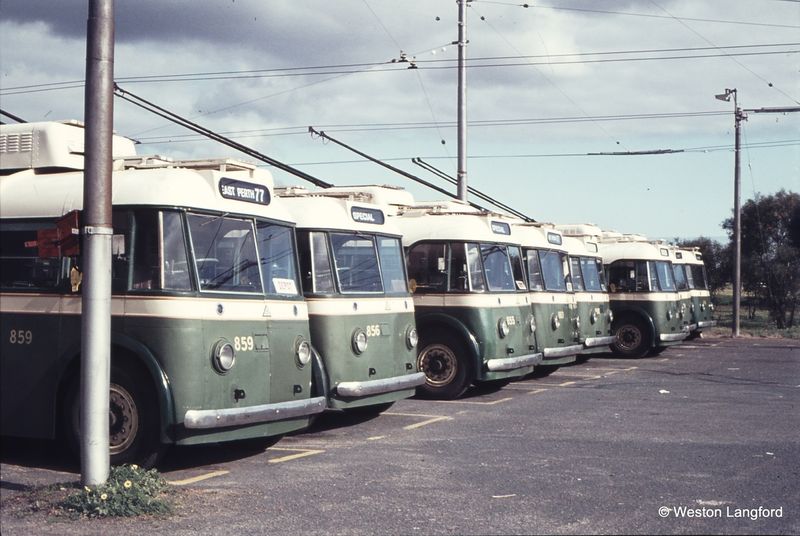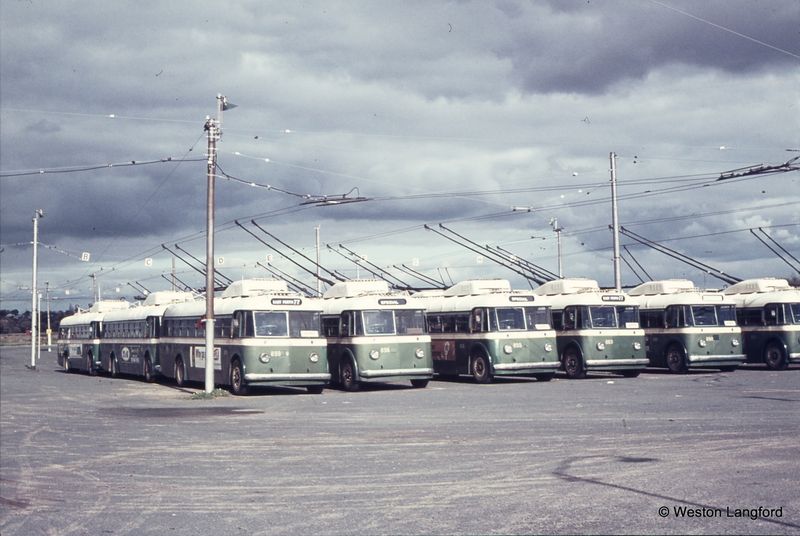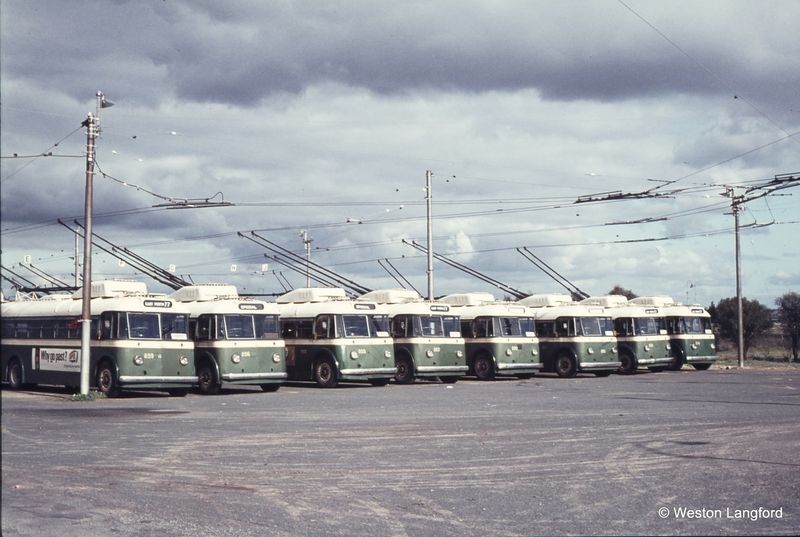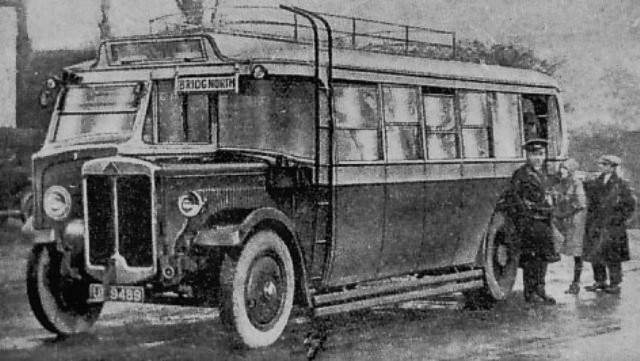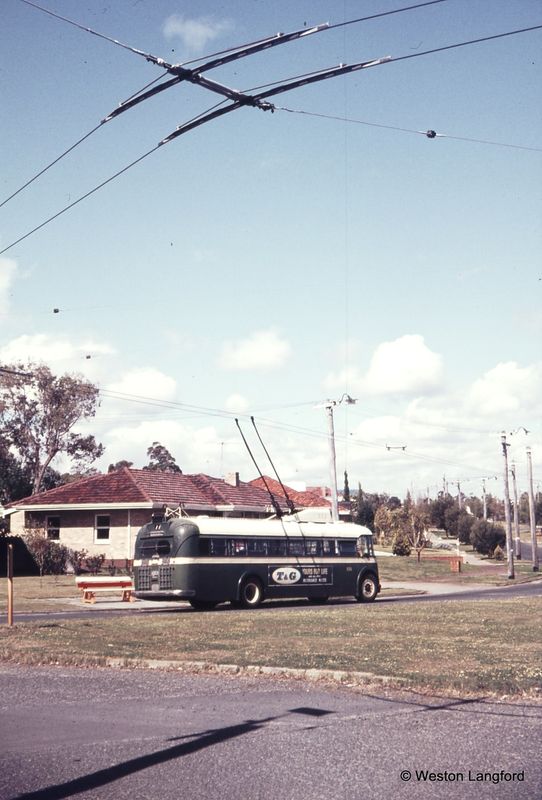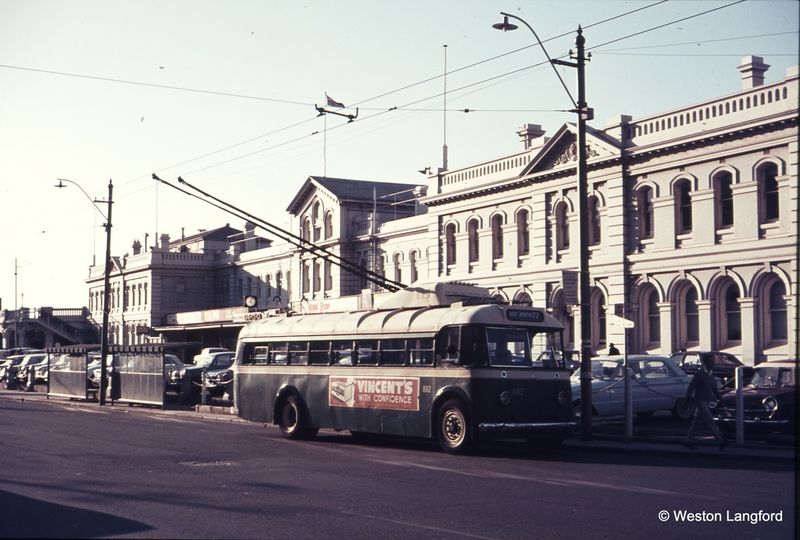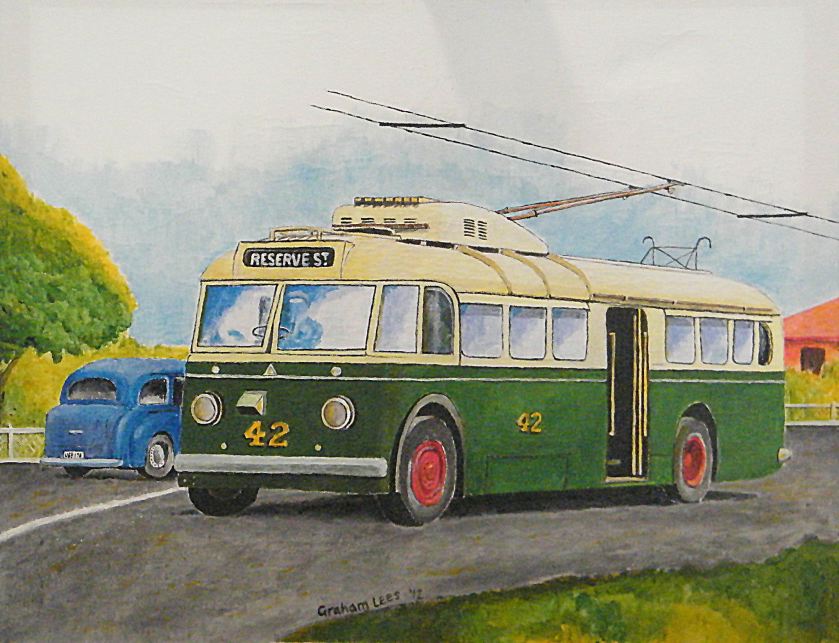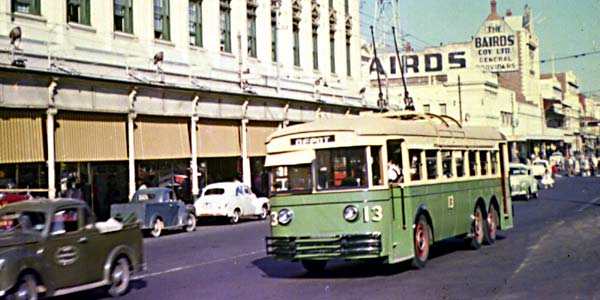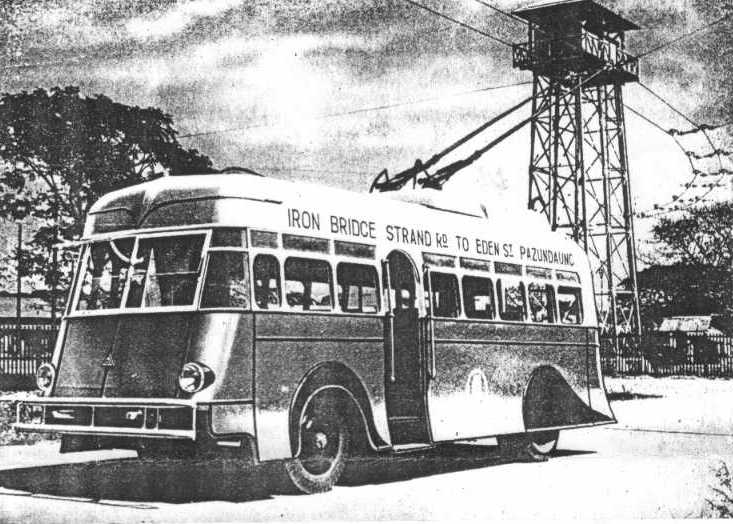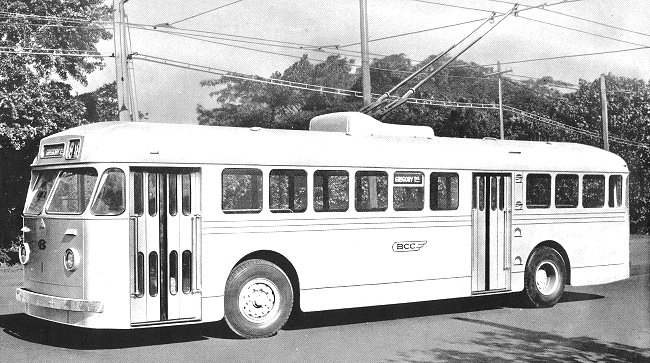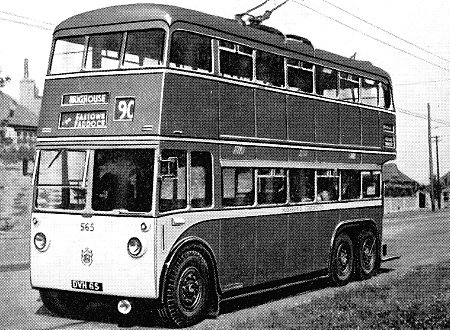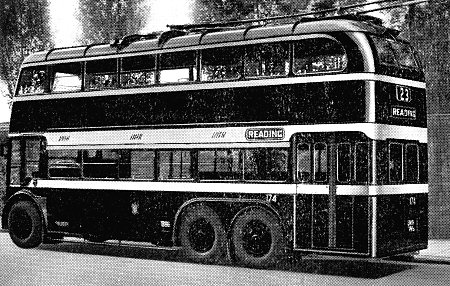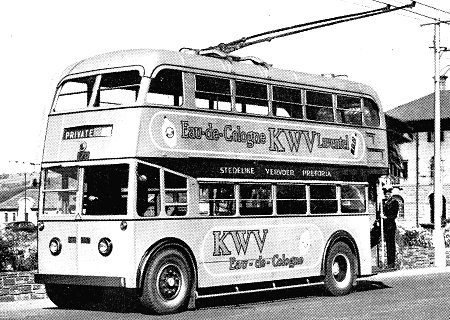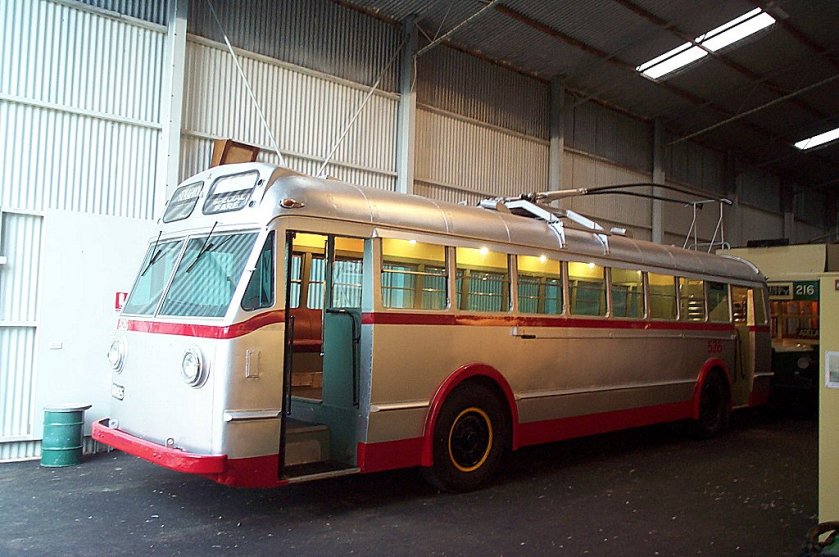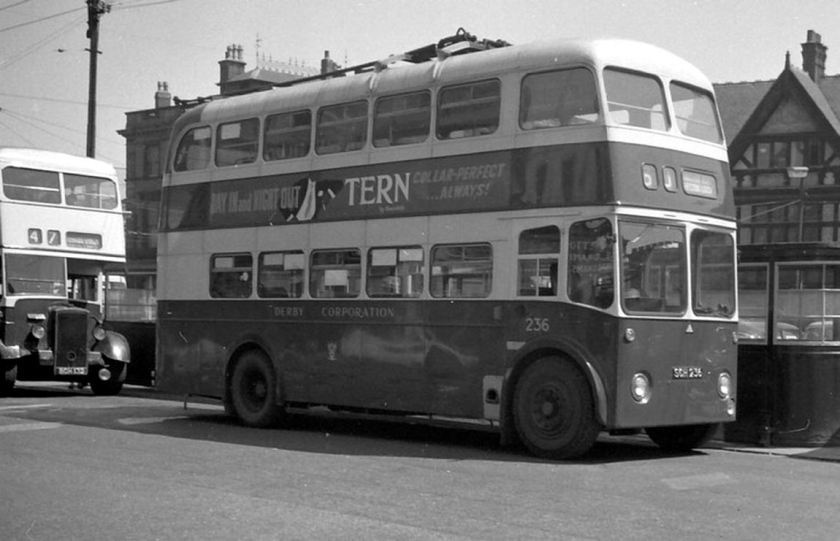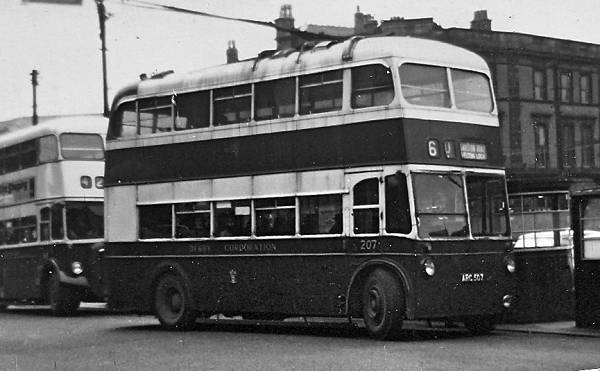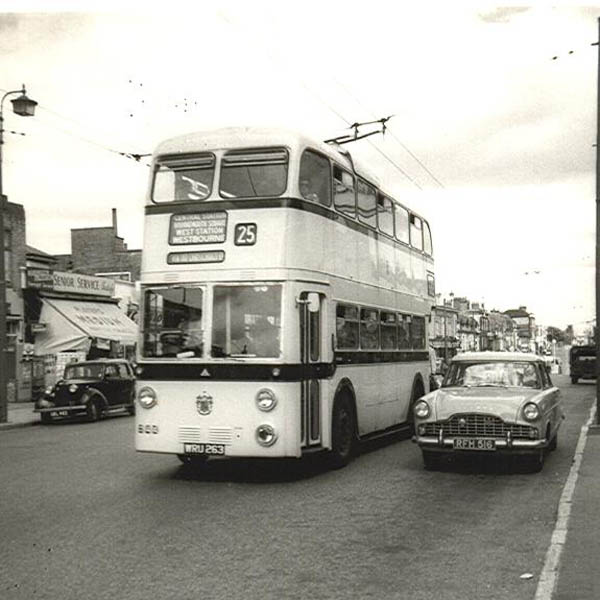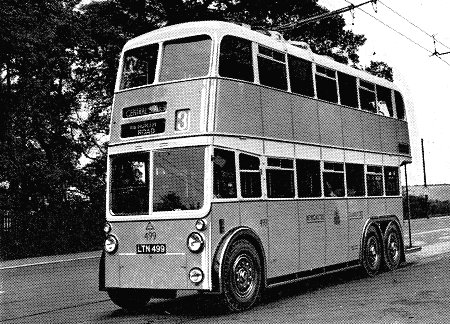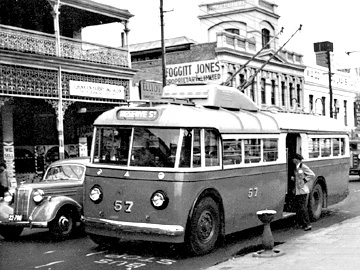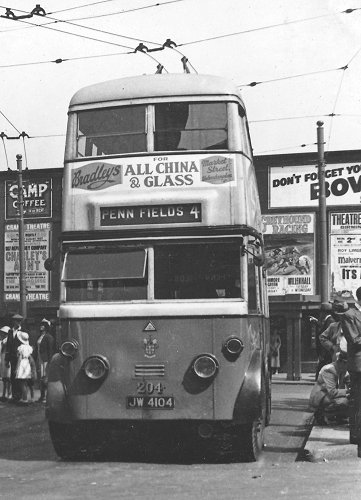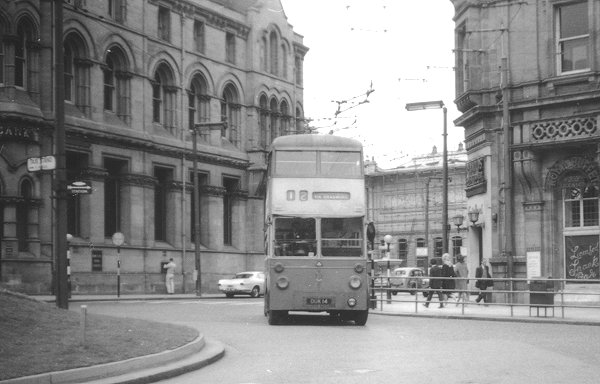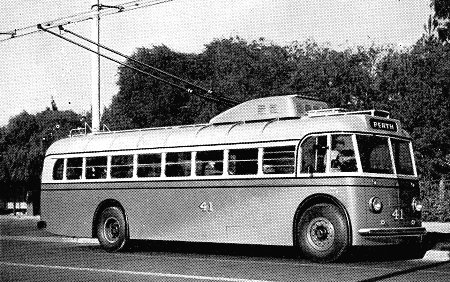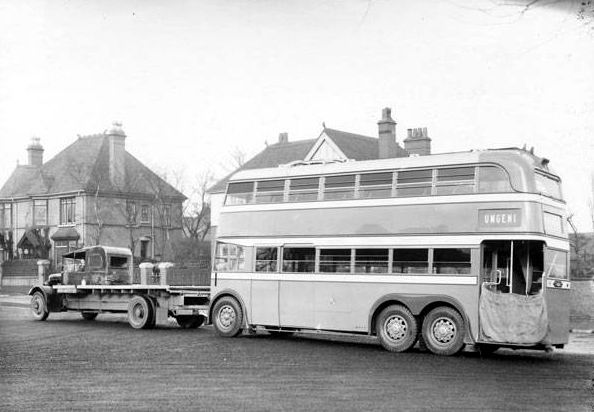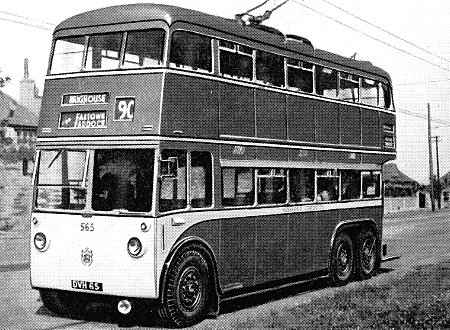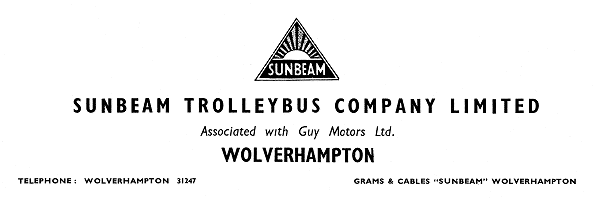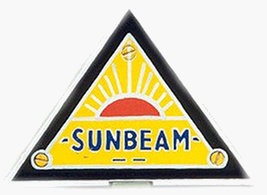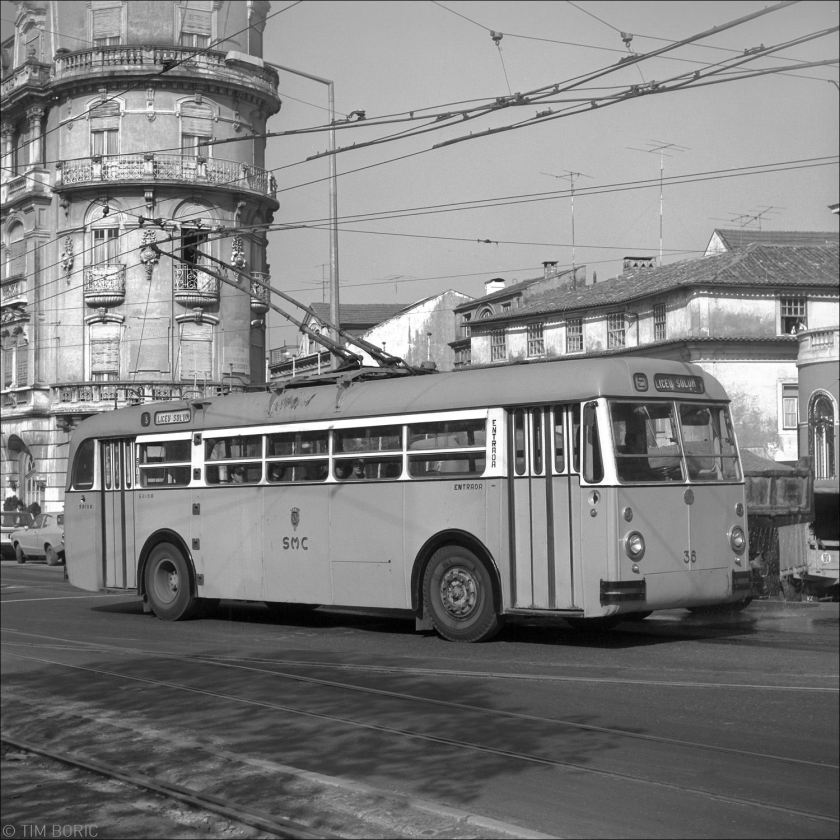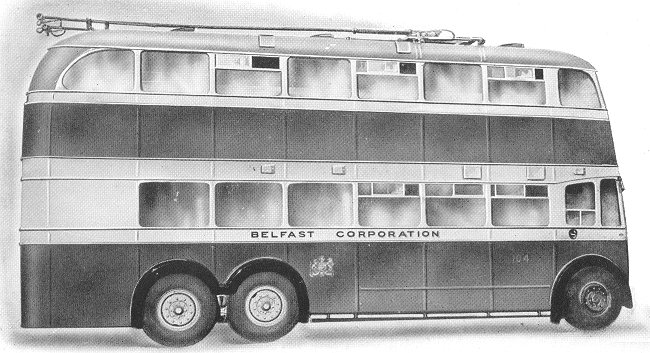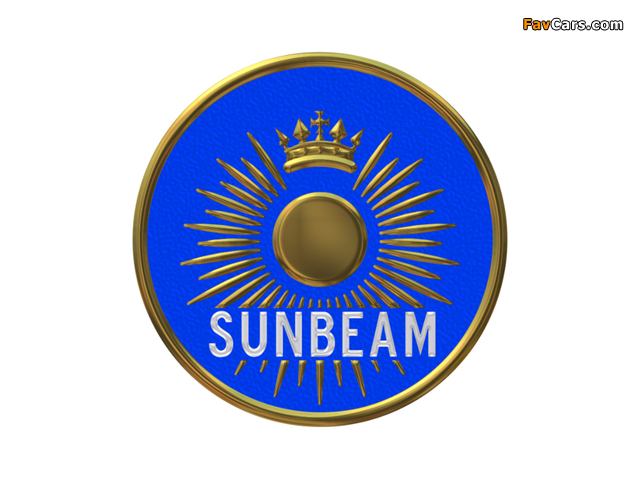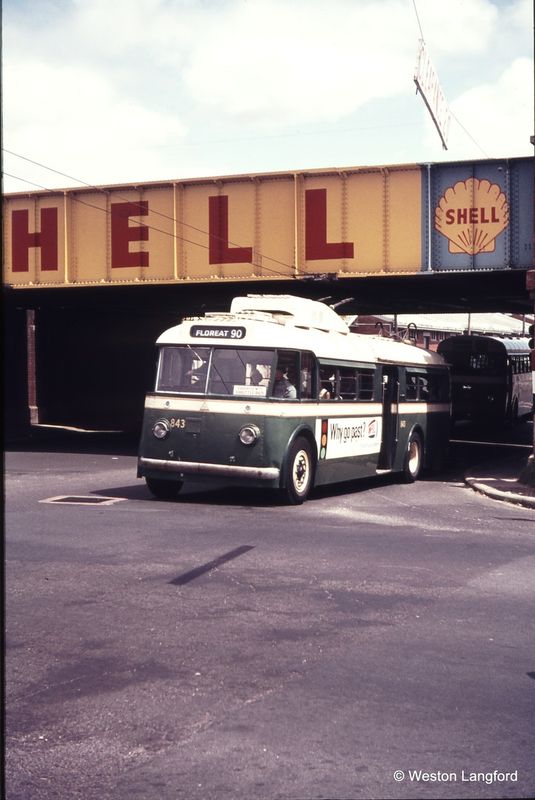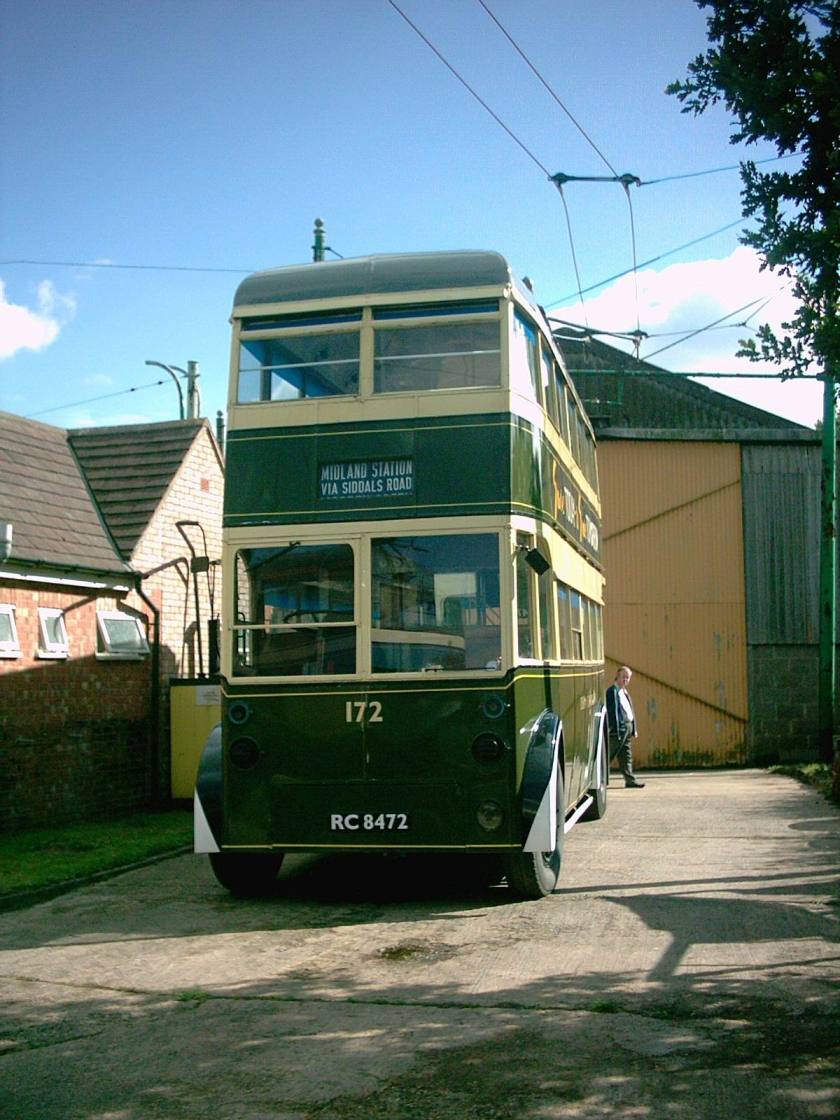Sunbeam (car + trolleybus company)
This is the complete history of Sunbeam, only the fat printed text goes about the trolleybuses. The rest comes back when I write about and show you the Sunbeam Cars.
Early history
The first production car named as a Sunbeam was introduced in 1901, after a partnership with Maxwell Maberley-Smith. The Sunbeam-Mabley design was an odd one, with seats on either side of a belt-drive powered by a single-cylinder engine of less than 3 hp (2.2 kW). The design was a limited success, with 420 sold at £130 when production ended in 1904 (source?? Other sources state 130 made). At that point the company started production of a Thomas Pullinger–designed car based on the Berliet mechanicals. They introduced a new model, based on a Peugeot motor they bought for study, in 1906 and sold about 10 a week.
1928 Sunbeam bus with an MS2 chassis and a Weymann body, used by Walsall Corporation.
In 1905, the Sunbeam Motorcar Company Ltd was formed separate from the rest of the John Marston business, which retained the Sunbeam motorcycles and bicycles.
1928 Sunbeam 6 wheel 27 pass. Dodson Body
The Breton car designer, Louis Coatalen, joined the company from Hillman-Coatalen in 1909, and became chief designer. He soon reorganised production such that almost all parts were built by the company, as opposed to relying on outside suppliers. He quickly introduced his first design, the Sunbeam 14/20, their first to use a shaft-driven rear axle, upgrading it in 1911 with a slightly larger engine as the 16/20.
1931 Sunbeam bus with a W4 chassis and a Park Royal body. Courtesy of Eardley Lewis
Sunbeam made a small number of Veterans, and by 1912 were making conventional, high-quality cars. Direct competitors to Rolls Royce, Sunbeams were considered to be a car for those who thought an RR a little ostentatious.
Coatalen was particularly fond of racing as a way to drive excellence within the company, noting that “Racing improves the breed”. After designing the 14/20, he started the design of advanced high-power engines, combining overhead valves with a pressurised oil lubrication system. In 1910 he built his first dedicated land-speed-record car, the Sunbeam Nautilus, powered by a 4.2-litre version of this engine design. The Nautilus implemented a number of early streamlining features, known as “wind cutting” at the time, but the custom engine suffered various problems and the design was eventually abandoned. The next year he introduced the Sunbeam Toodles II, featuring an improved valve system that turned it into a success. Coatalen won 22 prizes in Toodles II at Brooklands in 1911, and also achieved a flying mile of 86.16 mph (138.66 km/h) to take the 16 hp Short Record. Sunbeam cars powered by more conventional (for the time) side-valve engines featured prominently in the 1911 Coupé de l’Auto race, and improved versions won first, second and third the next year. Sunbeams continued to race over the next few years, but the company had moved on to other interests.
1932 Sunbeam ad 1946
1933 Sunbeam Sikh with Christopher Dodson H36-38R body J-9215
Coatalen also designed a number of passenger cars, notably the Sunbeam 12/16. By 1911 Sunbeam were building about 650 cars a year, at that time making them a major manufacturer.
First World War
Starting in 1912 they had also branched out into aircraft engines, introducing a series of engines that were not particularly successful commercially. Coatalen seemed to be convinced that the proper solution to any engine requirement was a design for those exact specifications, instead of producing a single engine and letting the aircraft designers build their aircraft around it. Their most numerous designs were the troublesome V8 Sunbeam Arab, which was ordered in quantity in 1917 but suffered from continual vibration and reliability problems and only saw limited service, and the more successful V12 Sunbeam Cossack. Meanwhile Coatalen continued to experiment with ever-more odd designs such as the star-layout Sunbeam Malay, which never got beyond a prototype, the air-cooled Sunbeam Spartan and the diesel-powered Sunbeam Pathan. The company was fairly successful with the introduction of newer manufacturing techniques, however, and was one of the first to build aluminium single-block engines, a design that would not become common until the 1930s.
1933 Sunbeam Weymann 3 axle trolleybus, this machine had a 60 seat body
During the First World War, the company built motorcycles, trucks, and ambulances. The company also participated in the Society of British Aircraft Constructors pool, who shared aircraft designs with any companies that could build them. Acting in this role, they produced 15 Short Bombers powered by their own Sunbeam Gurkha engines, 20 Short Type 827s, 50 Short 310s, and others including Avro 504 trainers; they even designed their own Sunbeam Bomber, which lost to a somewhat simpler Sopwith design. Sunbeam had produced 647 aircraft of various types by the time the lines shut down in early 1919.
Post-war
In 1919 Darracq bought the London-based firm of Clément-Talbot (becoming Talbot-Darracq) in order to import Talbots into England from France. On August 13, 1920, Sunbeam merged with the French company Automobiles Darracq S.A.. Alexandre Darracq built his first car in 1896, and his cars were so successful that Alfa Romeo and Opel both started out in the car industry by building Darracqs under licence. Adding Sunbeam created Sunbeam-Talbot-Darracq, or STD Motors.
1934 Sunbeam bus with an MS3 chassis and a Metro-Cammell body. Turning in Victoria Square
In addition to quality limousine, saloon and touring cars, Coatalen was pleased to build racing cars for Henry Segrave—who won the French and Spanish GPs in 1923/4. He also built a Brooklands racer with a purpose built V12 18.3 litre engine whose design was a hybrid of the Sunbeam Manitou and the Sunbeam Arab aero engines. This engine had four blocks of three cylinders arranged in two banks set at 60 degrees (unlike the Arab which were set at 90 degrees). Each cylinder had one inlet and two exhaust valves actuated by a single overhead camshaft. The two camshafts were driven by a complex set of 16 gears from the front of the crankshaft – a very similar arrangement to that used on the Maori engine which had two OHC per bank of cylinders. This famous car (Sunbeam 350HP) established three Land Speed Records – the first achieved by Kenelm Lee Guinness at Brooklands in 1922 with a speed of 133.75mph. Malcolm Campbell then purchased the car, had it painted in his distinctive colour scheme, named it Blue Bird and in September 1924 achieved a new record speed of 146.16mph at Pendine Sands in South Wales, raising it the following year to 150.76mph. The same year Coatalen’s new 3 litre Super Sports came 2nd at Le Mans—beating Bentley—this was the first production twin-cam car in the world. In 1926 Segrave captured the LSR in a new 4 litre V12 Sunbeam racer originally named Ladybird and later renamed Tiger. Coatalen decided to re-enter the LSR field himself, building the truly gigantic Sunbeam 1000HP powered by two 450 hp (340 kW) Matabele engines. On 29 March 1927 the car captured the speed record at 203.792 mph (327.971 km/h). The car is now at the National Motor Museum, Beaulieu, UK.
1935 Park Royal H31-25D body was one of sixty-three Sunbeam MS2s
Sunbeam’s great era was really the 1920s under Coatalen’s leadership with very well engineered, high quality, reliable cars — and a great reputation on the track.
1935 Sunbeam 202 , ALJ 286 with massive ark from trolley booms
A later land speed record attempt, the 1930 Silver Bullet, failed to achieve either records, or the hoped-for advances in aero engines. It is now almost forgotten. Sunbeam did not really survive the depression and in 1935 went into receivership and was sold to Lord Rootes. The last true Sunbeam was made in 1935. The new entry model “Dawn” was a typical mid-1930s design with independent front suspension whereas other models, the 18.2HP and Speed 20 were based on Vintage designs and qualify as PVT under VSCC rules.
1935 Sunbeam MS2 with Park Royal body
Coatalen’s obsession with improvement meant that there were numerous small changes in models from year to year. Therefore although his designs are basically similar, few parts are interchangeable.
1935 Sunbeam MS2 with Park Royal O68R bodywork ALJ-896
In the Vintage period, typically two models dominated production volumes at each period:
- 1920–24 16 hp, 16/40, 24 hp, 24/60 & 24/70 all based on pre-war designs.
- 1922–23 14 hp The first highly successful post-war 4-cylinder.
- 1924 12/30 & 16/50 only produced in small numbers.
- 1924–26 14/40 and big brother 20/60 developed from 14 hp with 2 more cylinders added.
- 1926–30 3 litre Super Sports, highly successful and much coveted, the first production twin OHC car in the world.
1935 Sunbeam TB advert
- 1926–30 16 hp (16.9) & 20 hp (20.9). Two new designs with six-cylinder integral cast iron block and crankcase. Both were reliable capable cars produced over many years, (20.9) with a 3-litre engine producing 70 BHP is noted for its performance and is well respected as a practical and reliable touring car. It has many shared components with the 3-litre Super Sports (brakes, suspension, steering, axles, gearbox, transmission).
- 1926–32 20/60 developed into 25 hp with bore increased from 75 to 80 mm. A few 8-cylinder cars produced in this period, 30 hp & 35 hp.
- 1930–32 16 hp bore increased from 67 to 70 mm, (16.9 to 18.2 hp).
- 1931–33 New model 20 hp introduced with 80 mm bore and 7 main bearings rated at 23.8 hp. Very smooth and powerful engine.
- 1933 18.2 hp engine installed in Speed 20 chassis and renamed ‘Twenty’.
- 1933–34 20.9 hp engine resurrected with improved exhaust manifold and downdraught carb installed in new cruciform braced chassis for the Speed 20. Highly desirable and fast touring model especially the 1934 body style.
- 1933–35 Twenty-Five introduced with modified 1931–33 23.8 hp engine.
- 1934 Twenty given the 20.9 engine in place of the 18.2.
- 1934–35 Dawn introduced. 12.8 hp (9.5 kW) engine and IFS. Nice little car but not a great success.
- 1935 Speed 20 renamed Sports 21 with redesigned body style.
- 1935 Sports 21 given a high compression version of Twenty-Five engine.
1935 Sunbeam MS2 with Park Royal O69R body BRU-8
The most successful, judged by volumes, was the 16 hp (16.9) followed by 20 hp ( 20.9) made from 1926 to 1930. Whilst the 16 was solid and very reliable, it was a little underpowered at 2.1 litres, the 20.9 made a big jump to 3 litres and 70 bhp (52 kW; 71 PS) with similar body weight and vacuum servo brakes and was capable of 70 mph (110 km/h).
1936 Park Royal H31-25D body on its Sunbeam MS2 chassis BRU8
Sunbeam built their own bodies but also supplied to the coachbuilder trade; many limousines were built on Sunbeam chassis. The sales catalogue illustrates the standard body designs.
Rootes Group
STD Motors went into receivership in 1935. By this point only Talbot was still a success and in 1935 that portion was purchased by the Rootes Group. William Lyons of “SS Cars,” who was looking for a name change, given the rising Nazi connotations, tried to buy Sunbeam but they were also purchased by Rootes. After World War II SS Cars changed their name to Jaguar.
1938 Sunbeam BTH 5
Car production at the Wolverhampton factory was terminated but trolleybus production continued there and Karrier trolleybus production was re-located there from Luton by 1939. During wartime the factory produced the only trolleybus available in the UK; a four-wheeled double decker known as either the Karrier or Sunbeam W4. Rootes sold the factory and designs to Brockhouse Ltd in 1946 who sold them in turn to Guy Motors in 1948 who built Sunbeam trolleybuses at their factory until the last was completed in 1964.
Rootes was an early proponent of badge engineering, building a single mass-produced chassis and equipping it with different body panels and interiors to fit different markets. They ended production of existing models at all the new companies, replacing them with designs from Hillman and Humber that were more amenable to mass production.
1938 Sunbeam MF2 with Park Royal H29-25R body BDA367
In 1938 Rootes created a new marque called Sunbeam-Talbot which combined the quality Talbot coachwork and the current Hillman and Humber chassis and was assembled at the Talbot factory in London. The initial two models were the Sunbeam-Talbot 10 and the 3-litre followed by the Sunbeam-Talbot 2 Litre and 4 litre models based on the earlier models only with different engines and longer wheelbases. Production of these models continued after the war until 1948.
1938 Sunbeam MF2 with Park Royal H29-25R body
In the summer of 1948, the Sunbeam-Talbot 80 and Sunbeam-Talbot 90 were introduced, with a totally new streamlined design with flowing front fenders (wings). The 80 used the Hillman Minx based engine with ohv and the 90 utilised a modified version of the Humber Hawk with ohv. The car bodies were manufactured by another Rootes Group company, British Light Steel Pressings of Acton, however the convertible drophead coupé shells were completed by Thrupp & Maberly coachbuilders inCricklewood. The underpowered 80 was discontinued in 1950. The 90 was renamed the 90 Mark II and then the 90 Mark IIA and eventually in 1954 the Sunbeam Mark III, finally dropping the Talbot name. With the model name changes, the headlights were raised on the front fenders and an independent coil front suspension and the engine displacement went from 1944 cc to 2267 cc with a high compression head and developing 80 bhp (60 kW; 81 PS).
1940 Sunbeam trolleybus no. 86 in Cape Town, South Africa
There was one more model of the Sunbeam-Talbot that appeared in 1953 in the form of an Alpine, a two seater sports roadster which was initially developed by a Sunbeam-Talbot dealer George Hartwell in Bournemouth as a one-off rally car that had its beginnings as a 1952 drophead coupé. It was named supposedly by Norman Garrad, (works Competition Department) who was heavily involved in the Sunbeam-Talbot successes in the Alpine Rally in the early 1950s using the Saloon model. The Alpine Mark I and Mark III (a Mark II was never made) were hand built like the Drophead Coupé at Thrupp & Maberly coachbuilders from 1953 to 1955 when production ceased after close to 3000 were produced. It has been estimated that perhaps only 200 remain in existence today. The Talbot name was dropped in 1954 for the Sunbeam Alpine sports car, making Sunbeam the sports-performance marque. In 1955 a Sunbeam saloon won the Monte Carlo Rally. Production ceased in 1956 and replaced by the sporty Sunbeam Rapier.
1940 Sunbeam Trolleybus, Rotherham Black Country Histor
In 1959 a totally new Alpine was introduced, and the 1955 Rapier (essentially a badge-engineered Hillman Minx) was upgraded. After several successful series of the Alpine were released, director of US West-Coast operations, Ian Garrad, became interested in the success of the AC Cobra, which mounted a small-block V-8 engine in the small AC Ace frame to create one of the most successful sports cars of all time. Garrad became convinced the Alpine frame could also be adapted the same way, and contracted Carroll Shelby to prototype such a fit with a Ford engine. The result was the Sunbeam Tiger, released in 1964, which went on to be a huge success.
1943 Sunbeam W, rebodied by Roe in 1955
Chrysler era
But at this point, Rootes was in financial trouble. Talks with Leyland Motors went nowhere, so in 1964, 30 percent of the company (along with 50 percent of the non-voting shares) was purchased by Chrysler, who was attempting to enter the European market. Ironically, Chrysler had purchased Simca the year earlier, who had earlier purchased Automobiles Talbot, originally the British brand that had been merged into STD Motors many years earlier.
1943 Sunbeam W with Park Royal bodywork and rebodied in 1960 with a Roe H34-28R body
Chrysler’s experience with the Rootes empire appears to have been an unhappy one. Models were abandoned over the next few years while they tried to build a single brand from the best models of each of the company’s components, but for management, “best” typically meant “cheapest to produce,” which was at odds with the former higher-quality Rootes philosophy. Brand loyalty started to erode, and was greatly damaged when they decided to drop former marques and start calling everything a Chrysler. The Tiger was dropped in 1967 after an abortive attempt to fit it with a Chrysler engine, and the Hillman Imp–derived Stiletto disappeared in 1972.
1943 Sunbeam W with Roe H62R body rebodied in 1960
The last Sunbeam produced was the “Rootes Arrow” series Alpine/Rapier fastback (1967–76), after which Chrysler, who had purchased Rootes, disbanded the marque. The Hillman (by now Chrysler) Hunter, on which they were based, soldiered on until 1978. A Hillman Avenger-derived hatchback, the Chrysler Sunbeam, maintained the name as a model, rather than a marque, from 1978 to the early 1980s, with the very last models sold as Talbot Sunbeams. The remains of Chrysler Europe were purchased by Peugeot and Renault in 1978, and the name has not been used since.
Products
Sunbeam rear entrance Tonneau
Sunbeam Cars
Pre WWI
- 1901–04 Sunbeam Mabley
- 1902-03 Sunbeam rear entrance Tonneau
- 1903–10 Sunbeam 12 hp
- 1904-05 Sunbeam side entrance Tonneau
- 1905–11 Sunbeam 16/20 and 25/30
- 1908 Sunbeam 20
- 1908–09 Sunbeam 35
- 1909 Sunbeam 16
- 1909–15 Sunbeam 14/20, 16/20, and 20
- 1910–11 Sunbeam 12/16
- 1911–15 Sunbeam 18/22, 25/30 and 30
- 1912–15 Sunbeam 12/16 and 16
- 1912–14 Sunbeam 16/20
Inter-war years
- 1919–21 Sunbeam 16/40
- 1919–24 Sunbeam 24, 24/60 and 24/70
- 1922–23 Sunbeam 14 and 14/40
- 1923–26 Sunbeam 20/60
- 1924–33 Sunbeam 16 (16.9 and 18.2)
- 1925–30 Sunbeam 3 litre Super Sports (Twin Cam)
- 1926–32 Sunbeam Long 25
- 1927–30 Sunbeam 20 (20.9)
- 1930–33 Sunbeam 20 (23.8)
- 1933–35 Sunbeam Speed Twenty
- 1934–35 Sunbeam Twenty
- 1934–35 Sunbeam Twenty-Five
- 1934–35 Sunbeam Dawn
Rootes Group Cars
- 1936–37 Sunbeam 30
- 1938–48 Sunbeam-Talbot Ten
- 1939–48 Sunbeam-Talbot Two Litre
- 1938–40 Sunbeam-Talbot Three Litre
- 1939–40 Sunbeam-Talbot Four Litre
Post WWII
- 1938–48 Sunbeam-Talbot Ten
- 1939–48 Sunbeam-Talbot Two Litre
- 1948–50 Sunbeam-Talbot 80
- 1948–54 Sunbeam-Talbot 90 Marks I, II & IIA
- 1954–57 Sunbeam 90 Mark III
- 1953–55 Sunbeam Alpine Mark I
- 1955–67 Sunbeam Rapier Series I, II, III, IIIA, IV & V
- 1959–68 Sunbeam Alpine Series I, II, III, III, IV & V
- 1963–64 Sunbeam Venezia by Carrozzeria Touring
- 1964–67 Sunbeam Tiger
- 1966–76 Sunbeam Imp Sport
- 1967–72 Sunbeam Stiletto
- 1967–76 Sunbeam Rapier Fastback & Sunbeam Alpine Fastback
- 1977–81 Talbot Sunbeam
- 1979–81 Talbot Sunbeam Lotus
- 1982–82 Sunbeam Lotus-Horizon
Double decker buses
1933 Sunbeam Sikh – JJ 9215 Christopher Dodson H36-28R
Sikh 1930-33 (three built)
1929 Sunbeam Pathan 4 wheeler
Pathan 1930-1938 (at least four built for Woverhampton Corp’n)
- DF2 1936-1948 (one built for Wolverhampton Corp’n.)
None built
Double decker trolleybus
1935 Park Royal H31-25D body was one of sixty-three Sunbeam MS2s
MS2 1934-1948

1934-sunbeam-bus-with-an-ms3-chassis-and-a-metro-cammell-body-turning-in-victoria-square
MS3 1934-1948
6-wheeled MS3 Sunbeam trolleybus that was operated by Newcastle Transport
MF1 1934-1949
1938 Sunbeam MF2 with Park Royal H29-25R body BDA367
MF2 1935-1952
1943 Sunbeam W4 with Park Royal bodywork and rebodied in 1960 with a Roe H34-28R body
W4 1943-1947
FWX 914 Sunbeam F4 East Lanes H37/29F Trolleybus
F4/F4A 1948-1965
1948 Sunbeam S7 Trolleybus
S7/S7A 1948-58
Double or single deck trolleybus
301LJ (301) Sunbeam MF2B / Weymann
MF2B 1934-65
Export only
- Sunbeam Minx
- Sunbeam Vogue/Sunbeam Arrow
- Sunbeam Funwagon/Sunbeam Highwayman
Sunbeam-Coatalen engines
Sunbeam, Wolverhampton, England, started to build aircraft engines in 1912. Louis Coatalen joined Sunbeam as chief engineer in 1909, having previously been Chief Engineer at the Humber works in Coventry. The company quickly became one of the UK’s leading engine manufacturers and even designed an aircraft of its own. Sunbeam discontinued the production of aero engines after Coatalen left the company in the 1930s.
- Sunbeam Crusader V8, 150 hp (110 kW)
- Sunbeam Zulu V8, 160 hp (120 kW), developed from Crusader
- Sunbeam Mohawk V12, 225 hp (168 kW)
- Sunbeam Gurkha V12, 240 hp (180 kW), developed from Maori
- Sunbeam Cossack V12, 320 hp (240 kW), 18.4 litres
- Sunbeam Nubian V8, 155 hp (116 kW), 7.7 litres
- Sunbeam Afridi V12, 200 hp (150 kW), 11.476 litres
- Sunbeam Maori V12, 250 hp (190 kW), 14.7 litres, developed from Afridi
- Sunbeam Amazon Straight-6, 160 hp (120 kW), 9.2 litres, developed from Cossack
- Sunbeam Saracen Straight-6, 200 hp (150 kW), 11.2 litres, developed from Amazon
- Sunbeam Viking W18 “Broad Arrow” 450 hp (340 kW), 33.6 litres, developed from Cossack
- Sunbeam Arab V8, 200 hp (150 kW), 11.8 litres
- Sunbeam Bedouin inverted V8, 200 hp (150 kW), 12.3 litres, developed from Arab
- Sunbeam Manitou V12, 325 hp (242 kW), 14.7 litres, developed from Maori
- Sunbeam Tartar V12, 300 hp (220 kW), 15.4 litres
- Sunbeam Kaffir W12 “Broad Arrow” 300 hp (220 kW), developed from Arab, 18.3 litres
- Sunbeam Spartan V12, 200 hp (150 kW), 14 litres, air-cooled
- Sunbeam Matabele V12, 400 hp (300 kW), 22.4 litres, developed from Cossack
- Sunbeam Malay Five-pointed star arrangement of 20 cylinders, 500 hp (370 kW), 29.4 litres
- Sunbeam Pathan Straight-6, 100 hp (75 kW), 8.8 litres, diesel
- Sunbeam Dyak Straight-6, 100 hp (75 kW), 8.8 litres
- Sunbeam Sikh V12, 800 hp (600 kW), 64.1 litres
- Sunbeam Sikh II
- Sunbeam Sikh III
- Sunbeam 2,000hp
From here only Sunbeam Trolleybuses
1943-sunbeam-w-with-roe-h62r-body-rebodied-in-1960
1943-sunbeam-w-rebodied-by-roe-in-1955
1943-sunbeam-ws-with-weymann-h30-26r-bodies
1943-rotherham-74-cet613-is-sunbeam-ms2c-with-what-i-believe-to-be-an-east-lancs-body
1944-56-seat-sunbeam-s4-trolleybuses-four-of-which-were-bodied-by-roe-and-four-by-weymann-car-16-cpy287-was-one-of-the-roe-bodied-examples
1944-sunbeam-w-and-rebodied-by-roe-h37-28r-in-1961
1944-sunbeam-w-built-and-rebodied-by-roe-h37-28r
1944-sunbeam-w-but-rebodied-by-roe-in-1962
1944-sunbeam-w-from-1944-but-rebodied-by-roe-in-the-early-1960s
1944-sunbeam-w-utility-chassis-that-was-rebodied-by-roe-in-1960
1944-sunbeam-w-with-a-park-royal-h30-26r-body-in-january-1958-it-re-entered-service-with-a-new-roe-h33-28r-body
1944-sunbeam-w-with-roe-h61r-body-on-learner-duties-new-in-1944-6-rebodied-in-1958
1944-sunbeam-w-with-roe-h62r-body-rebodied-in-1960
1944-sunbeam-w-with-roe-h62r-body-rebodied-in-1960
1944-weymann-utility-bodied-sunbeam-w4
1944-weymann-utility-bodied-sunbeam-w4.
1945-sunbeam-bus-with-a-w4-chassis-and-a-park-royal-body
1945-sunbeam-roe
1945-sunbeam-w-chassis-carrying-roe.
1945-sunbeam-w-started-life-as-southend-corporation-131-with-a-park-royal-utility-body
1945-sunbeam-w-with-a-brush-body
1945-sunbeam-w-with-park-royal-h30-26r-body
1945-sunbeam-w-with-park-royal-h30-26r-body
1945-sunbeam-w-with-roe-31-29r-bodywork-grh356
1945-sunbeam-w-with-roe-31-29r-bodywork-grh356
1946-sunbeam-w-trolleybus-rebodied-by-roe-in-1959
1946-sunbeam-w-trolleybus-rebodied-by-roe-in-1959
1946-sunbeam-w-with-northern-coachbuilders-h56r-body-1
1946-sunbeam-w-with-northern-coachbuilders-h56r-body-2
1946-sunbeam-w-with-northern-coachbuilders-h56r-body-3.
1946-sunbeam-w-with-northern-coachbuilders-h56r-body-4
1946-sunbeam-w-with-northern-coachbuilders-h56r-body
1946-sunbeam-w-with-roe-bodywork
1946-sunbeam-with-a-w4-chassis-and-a-park-royal-body
1946-w4-sunbeam-chassis-fitted-with-a-park-royal-body-it-entered-service-with-wolverhampton-corporation-transport
1946-sunbeam-london-dd-trolleybus
1947-sunbeam-maidstone-trolleybus
1947-sunbeam-w-chassis
1947-sunbeam-w-with-an-n-c-b-h30-26r-body
1947-sunbeam-w-with-brush-b35c-body
1947-sunbeam-w-with-weymann-h56r-body
1947-sunbeam-w-with-weymann-h56r-body
1947-sunbeam-w-with-weymann-h56r-body
1947-sunbeam-w-with-weymann-h56r-body-11
1947-sunbeam-w-with-weymann-h56r-body
1947-sunbeam-w-rebodied-by-roe-h32-28r-in-1960
1947-sunbeam-w4-with-northern-coachbuilders-h30-26r-bodywork
1947-sunbeam-ws-delivered-between-1947-and-1949-449-and-440-had-been-rebodied-by-roe-in-1960-1-but-473-still-carried-the-original-park-royal-body
1948-sunbeam-f4-with-brush-b32c-body
1948-sunbeam-f4-with-brush-bodywork
1948-sunbeam-f4-with-brush-h30-26r-body
1948-sunbeam-f4-with-east-lancs-h37-29f-body
1948-sunbeam-f4-with-east-lancs-h37-29f-body
1948-sunbeam-ms2-with-roe-h72r-body
1948-sunbeam-s7-trolleybus
1948-sunbeam-s7-with-locally-produced-northern-coachbuilders-bodywork
1948-sunbeam-s7-with-northern-coachbuilders-h39-31r-body
1948-sunbeam-s7-with-northern-coachbuilders-h39-31r-body
1948-sunbeam-trolleybus-with-a-w4-chassis-and-a-park-royal-body
1948-sunbeam-w-with-park-royal-h54r-body
1948-sunbeam-w-with-roe-h32-28r-body-ejw-451
1948-sunbeam-ncb-trolleybus-501
1949-sunbeam-bus-with-an-f4-chassis-and-a-park-royal-body
1949-sunbeam-ms2-with-original-park-royal-h72r-body
1950-sunbeam-f4-trolley-rebodied-by-roe-in-1964
1950-sunbeam-f4-trolleybus-built-in-1950-and-rebodied-by-roe-in-1965
1950-sunbeam-f4-vehicles-with-park-royal-h56r-bodywork
1950-sunbeam-f4-with-park-royal-h30-26r-body-adx-191
1950-sunbeam-f4-with-park-royal-h56r-body-
1950-sunbeam-ms2-with-roe-h40-30r-body
1950-sunbeam-s7-with-park-royal-h38-30rd-body-erd-149
1950-sunbeam-s7-with-park-royal-h38-30rd-body
1951-sunbeam-f4-wit-brush-h30-26r-body-ndh-958
1951-sunbeam-f4-with-brush-h30-26r-bodywork
1951-sunbeam-f4a-with-willowbrook-h36-34r-bodywork-xdh-72
1951-sunbeam-ms2-with-roe-h70r-body
1951-sunbeam-trolleybus
1951-sunbeam-with-east-lancs-h29-26r-body
1952-sunbeam-commercial-motor-show-at-earls-court
1952-willowbrook-h32-28r-body-on-a-sunbeam-f4-chassis
1953-sunbeam-f4-rebodied-by-roe-in-1964
1953-sunbeam-f4-with-willowbrook-h32-28r-body
1953-sunbeam-f4-with-willowbrook-h32-28r-body
1953-sunbeam-f4-with-willowbrook-h32-28r-body
1953-sunbeam-f4a-with-willowbrook-body-passes-131-odh-89-a-full-front-park-royal-bodied-leyland-pd2-1-of-1951
1954-sunbeam-2-axle-double-deck-trolleybus-30-ft-overall-length-built-for-walsall-corporation-in-1954
1954-sunbeam-f4a-with-willowbrook-h36-34rd-body
1954-sunbeam-f4a-with-willowbrook-h70r-body
1954-sunbeam-mf2b-chassis-and-roe-bodywork-and-nicknamed-e28098coronations
1954-sunbeam-mf2b-with-roe-h30-24d-body-rkh102
1954-sunbeam-mf2b-with-roe-h30-24d-body-rkh102
1955-sunbeam-f4a-built-with-a-distinctive-willowbrook-body
1955-sunbeam-f4a-willowbrook-h70rd-at-ingram-road-bloxwich-on-route-15.
1955-sunbeam-mf2b-mv-with-roe-h54d-body
1955-sunbeam-mf2b-mv-with-roe-h54d-body
1955-willowbrook-bodied-sunbeam
1956-sunbeam-f4a-willowbrook-h36-34rd
1956-sunbeam-f4a-with-70-seat-willowbrook-body
1956-willowbrook-bodied-sunbeam-f4a
1956-51-willowbrook-bodied-sunbeam-f4a-passes-131-odh89-a-full-front-park-royal-bodied-leyland-pd2-1-of-1951
1957-sunbeam-model-coachwork-by-munck-of-bergen-norway
1958-guy-sunbeam-arab-trolleybus-belfast
1958-sunbeam-f4a-with-a-harkness-body
1958-sunbeam-mf2b-weymann-h63d
1958-sunbeam-mf2b-with-weymann-h63d-body-wru-261
1958-sunbeam-mf2b-with-weymann-h63d-body
1959-sunbeam-mf2b-weymann-h63d
1959-sunbeam-roe-trolleybuses
1959-sunbeam-s7-h40-32r
1959-sunbeam-s7-h40-32r
1959-sunbeam-s7-with-east-lancs-h40-32r-body
1959-sunbeam-s7a-trolleybus-with-east-lancs-h40-32r-bodywork
1959-sunbeam
1960-roe-bodied-sunbeam-f4a
1960-roe-bodied-sunbeam-f4a
1961-burlingham-bodied-sunbeam-f4a
1961-sunbeam-f4a-trolleybuses-with-burlingham-h38-30f-bodies
1961-sunbeam-f4a-with-burlingham-front-entrance-bodywork
1961-sunbeam-f4a-with-burlingham-front-entrance-bodywork
1961-sunbeam-f4a-with-burlingham-h38-30f-bodywork
1961-sunbeam-f4as-with-burlingham-h38-30f-body
1961-sunbeam-mf2b-with-weymann-h65d-body-296-lj
1962-sunbeam-mf2b-trolleybus
1962-sunbeam-mf2b-trolleybus
1962-sunbeam-mf2b-with-weymann-h65d-body
1962-sunbeam-mf2b-with-weymann-h65d-body
1962-sunbeam-trolleybus-with-weymann-bodywork
1962-sunbeam-trolleybus-with-weymann-bodywork
1965-sunbeam-mf2ns-utic-trolleybus
Lots of trolleys
sunbeam-w4-chassis-fitted-with-a-park-royal-body-courtesy-of-eardley-lewis
barrack-street-bridge-route-18-southbound-sunbeam-trolleybus-846 © Weston Langford
barrack-street-jetty-arhs-special-sunbeam-trolleybus-851 © Weston Langford
Sunbeam bc_gb149_p_7043
cambridge-street-and-gregory-street-down-arhs-special-sunbeam-trolleybus-851 © Weston Langford
cambridge-street-near-holland-street-route-80-westbound-sunbeam-trolleybus-856 © Weston Langford
cambridge-street-near-holland-street-route-108-westbound-sunbeam-trolleybus-856 © Weston Langford
fwx-914-sunbeam-f4-east-lanes-h37-29f-trolleybus
grantham-street-and-brookdale-street-route-77-eastbound-sunbeam-trolleybus-869 © Weston Langford
hay-street-east-trolley-bus-depot-sunbeam-trolleybuses-854 © Weston Langford
hay-street-east-trolley-bus-depot-sunbeam-trolleybuses-859 © Weston Langford
hay-street-east-trolley-bus-depot-sunbeam-trolleybuses-859 © Weston Langford
hay-street-east-trolley-bus-depot-sunbeam-trolleybuses-859 © Weston Langford
oc14-sunbeam-of-wolverhampton
oceanic-drive-terminus-route-77-eastbound-sunbeam-trolleybus-856 © Weston Langford
perth-station-wellington-street-eastbound-sunbeam-trolleybus-882 © Weston Langford
perth-trolley-bus-sunbeam-no-42-on-the-wembley-route © Graham Lees
rangoon-sunbeam-trolleybus
single-deck-sunbeam-trolleybuses-used-in-brisbane
sunbeam-guy-huddersfield-4
sunbeam-guy-s7-reading-corporation-transport-department-5
sunbeam-guy-trolleybus-pretoria-city-transport-department-3
sunbeam-guy-trolleybussen-van-de-city-of-johannesburg-6
sunbeam-adelaid-02
sunbeam-derby-corporation-trollybus-sunbeam-f4a
sunbeam-f4-with-brush-h30-26r-body
sunbeam-mf2b-263
sunbeam-newcastle-upon-tyne-corporation-7
sunbeam- perth – 55
sunbeam-perth-57
sunbeam-t-bus-ms3-chassis-with-metro-cammell-bodywork
sunbeam-trolley-bus-in-queen-square
sunbeam-trolleybus-western-australian-government-tramways-perth-8
sunbeam-wolverhampton1
sunbeam4
sunbeam-trolleybus-rijdt-in-1977-op-lijn-5-naar-liceu-solum-over-de-avenida-emidio-navarro-dichtbij-het-hoofdstation-van-coimbra © Tim Boric
Sunbeam TB 2
west-perth-subway-down-arhs-special-sunbeam-trolleybus-843 © Weston Langford
weymann-utility-bodied-sunbeam-w4-trolleybus-172
This is IT
